If I told you there was a small neighborhood in Downtown Omaha that had the look and feel of a 1920s or 1930s movie set, would you catch a dimbox over there as quickly as you could just to get a gander? Because there is such a strange, thrilling stretch of architecture right in our midst and I’m goofy for it.
The Historic Howard Street Apartment District is simply transportive. Go have a look-see between 22nd and 24th on Howard on some dark, foggy night. You should plan to arrive unexpectedly. You’re a Walk-In, after all. I’d like to think they’ll never see you coming, but you may want to wear a big coat with a smart collar or maybe a nondescript hat. Trust me–weave your way along the sidewalk, taking note, stroll by the innumerable apartment windows, and remember to stare like a Fearless Out-Of-Towner if approached. Take it all in. Finally, clasp your hands together and see if you don’t unexpectedly exclaim: “This IS a movie set!” You’re a natural. And let’s be honest about those of us gathered here together, we’ve got an eye for these old buildings that take shape around us.
In our last mystery adventure, we were following the trail of the The Case of the Curious Cricket Room and Burgess-Nash Company . Today we’ll be tracking the Historic Howard Street Apartment District but not the apartment buildings per se. Did you happen to catch it? In the middle of that entire movie set smoke and mirrors there is a lone, incredible mansion just tucked away, waiting to be discovered. And that, dear Omaha friends, is the focus of our investigation today, which I will leisurely unfold (over the next five hours.) Have you got some time to wander around this property with me? Tell your family you’ll be back later. I’ll cover for you.
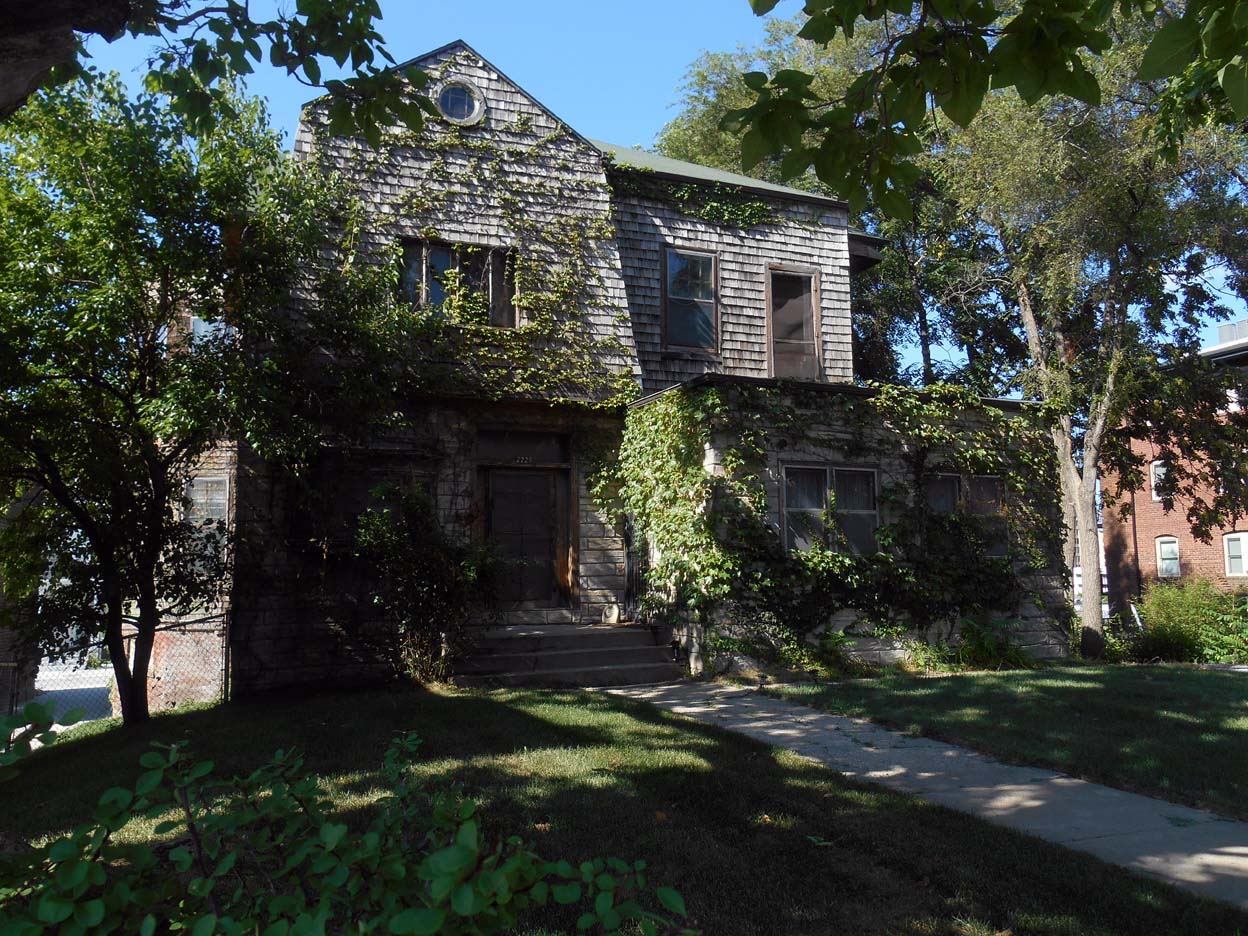
The Tip Off
The architectural infatuation of focus is 2226 Howard Street. Back on May 15, 2016 a My Omaha Obsession reader, Christine H., wrote in and brilliantly suggested an investigation into the house. I thought the home sounded familiar from my late 1990s YMCA days and proceeded to do a quick drive-by to steady my hunch. What I found in 2226 Howard was far better than I had remembered from 18 years earlier. She was a fantastic mansion of the Old Omaha Elite, resplendent in her quiet way.
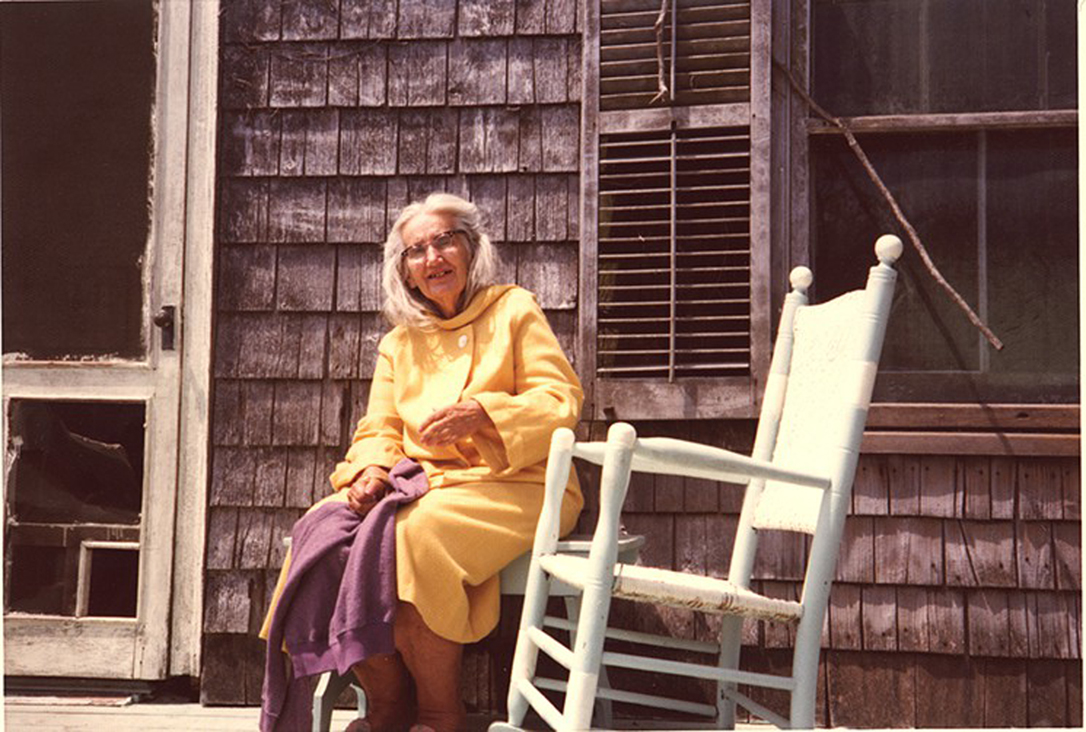
There was an unpretentious air to 2226 Howard, for anyone In The Know already Knows the charms of the Shingle Style. But for all that imagined modesty, she had the distinct bearing of someone who comes from good origins. I couldn’t help but begin to ideate Omaha’s own Grey Gardens House complete with Big and Little Edie Bouvier Beale. 2226 Howard Street: I was mad for her.
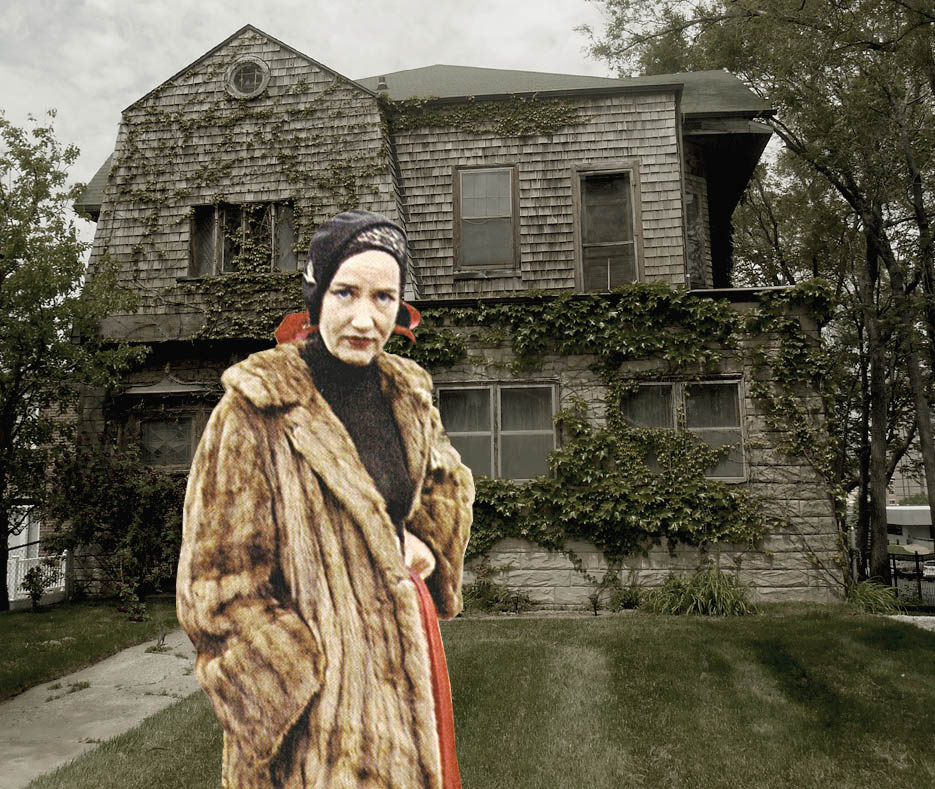
If only!
Off With an Obsessive Start
As many of you might have noticed, I’ve got a real Shingle Style Problem and I’m not quite sure when it began. Maybe it developed during another issue from my youth—my Mansion Obsession. Of course what passes for a mansion around here is quite modest compared to other parts of the country. I realize Omaha did not have the Quasi-Aristocratic, Thurston Howell IIIs, Old Money of the New England variety but I contend that our Old Guard Society of the past would have most likely rather lined the bank vault than pour money into a rambling, extravagant estate. We are through and through, a practical lot. But I’ve strayed the course. The point is I Know a Good Shingle Style home when I see one.
The Beginning of the Search
The Howard Street Apartment District, as it is now called, is lined with incredible apartments, row houses and double houses, with the center strip being Howard. There is a short block to the north on Dewey Street, almost like a back alley. From the “National Register of Historic Places Registration Form”I learned that “originally the area was filled with mansions and large single-family homes on the western most part of the Central Business District of Downtown Omaha. These apartments later replaced the original mansions.” (I plan to write more about the Howard Street Apartment District in the future.) “The only original home in these few blocks is at 2226 Howard.”

Boundary map from “National Register of Historic Places Registration Form.”

The only other original mansion, although built later, is the gorgeous Thomas Kimball home at 2236 St. Mary’s Avenue. Kimball built this home for his mother, Mary Rogers Kimball. This mansion is an eclectic mix (of heaven). Go around back and get a whiff of that carriage house! Yes, I will be back to write about this one at some point. Adore.
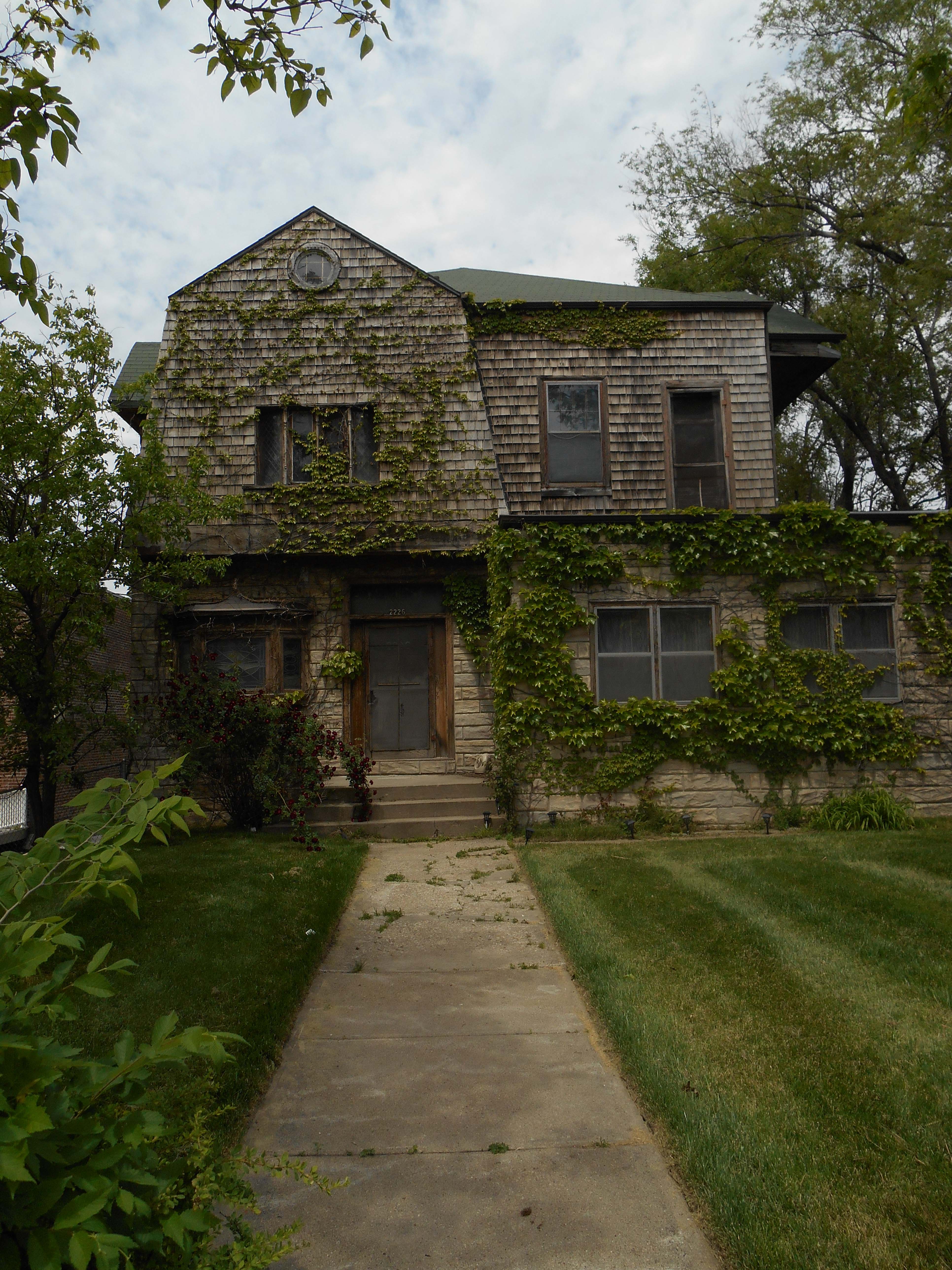
According to the incredible “National Register of Historic Places Registration Form” filed in 1996 by Stacy Pilgrim, Planner Specialist with the Omaha City Planning Department, “Currently the district retains only one of the original mansions, the 1885 house at 2226 Howard.” Later in the report, Ms. Pilgrim says, “This single family dwelling constructed in the shingle style, was built around 1890.” This was just the beginning of the confusion. “By the late 1920’s it had been converted into a rooming house, but is currently a single family residence. The two and half story house is covered in narrow clapboard and decorative scale shingles, common during the late 1800’s. The entire house has been painted green. Double hung sash windows are found on all facades and some decorative lead glass windows are found on the first floor. The main façade is the southern façade and the main entrance is through an enclosed porch. The roof is low pitched and hipped with cross gables. Within each of the cross gables is small window at the attic level. Very few alterations have been made to the exterior of the house and it retains a very high degree of integrity.” Thought to be “predominantly representative of the types of single family houses found in the area.”
History of the Shingle Style
From Shingle Style: Innovation and Tradition in American Architecture 1874-1982, by Morgan and Roth, I learned that It All Began with a photograph of Whitehall, the Bishop George Berkeley house in Middletown, Rhode Island. This home was built between 1728-29—lovingly covered entirely in wooden shingles. This photo appeared in the Jan 1874 inaugural issue of The New York Sketchbook of Architecture, a publication aimed at architects–promoting new approach to design inspired by America.
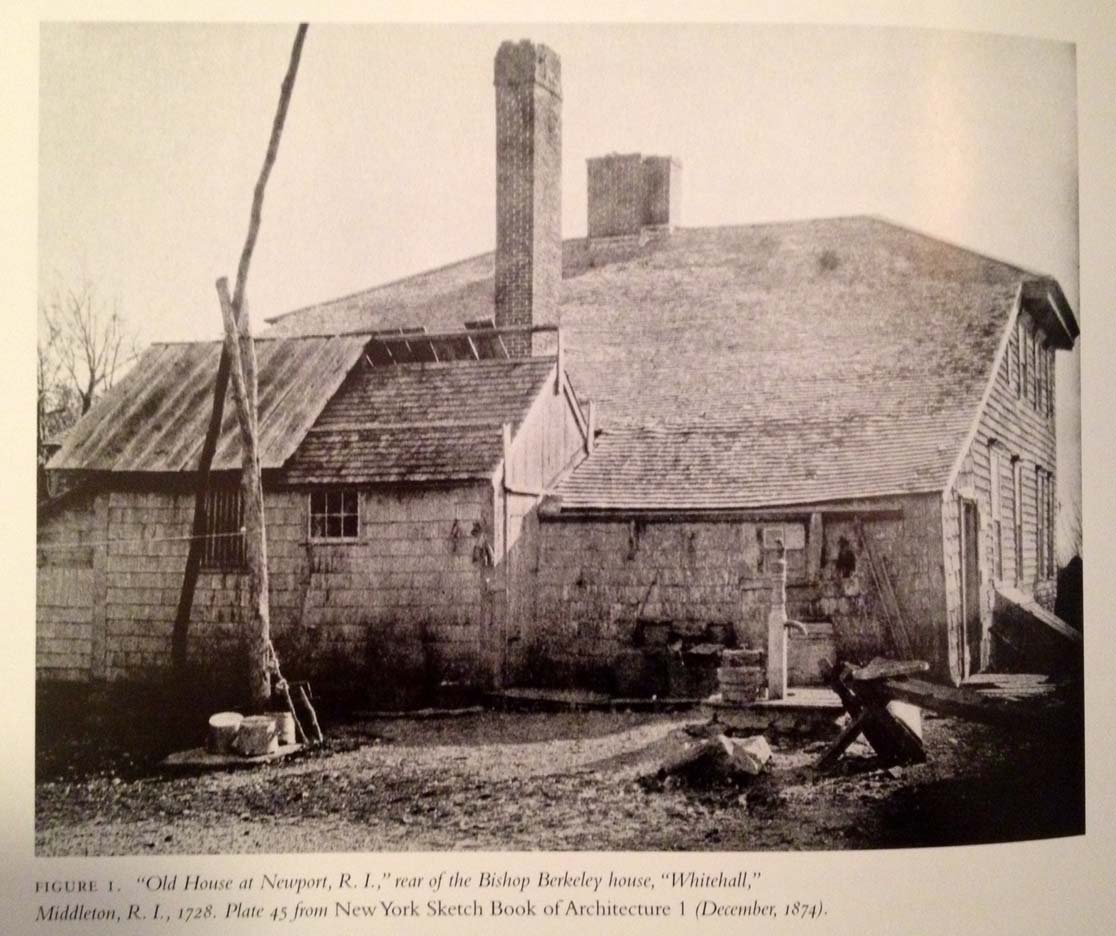
Whitehall. From Shingle Style: Innovation and Tradition in American Architecture 1874-1982, by Morgan and Roth. This photo and the influence it had, represented a shift away from contemporary design and high style, instead focusing on architecture of the Founding Fathers. “The four years following the appearance of this photograph, there would emerge a new approach to domestic architecture that capitalized on the lightness and flexibility of wood.” From 1880s-1890s, Shingle Style would expand across America, leaving the New England countryside and seaboard, where the style was popular with the upper crust. McKim, of McKim, Mead & White is credited with having published the original Whitehall photo. McKim, Mead & White would go on to become a prestigious New York architectural firm, known for their gorgeous Shingle Style designs.
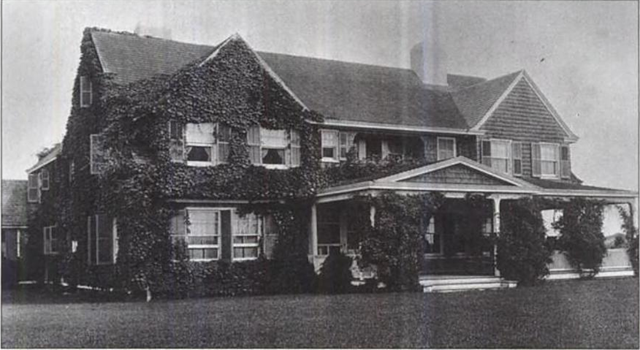
Original Grey Gardens home of my dream. The shingle-style home was designed by Arts and Crafts architect Joseph Greenleaf Thorpe in 1897. A Princeton graduate, Thorpe designed many of the summer cottages in East Hampton during the late 19th Century. “The Shingle Style emerged, called into being by the leisured classes, who desired an architecture that spoke of easy and carefree pastimes, an architecture that was not pretentious or boastful, that connected with an ancestral past but was not held in check by it. From 1879 to 1916, the Shingle Style flourished.”
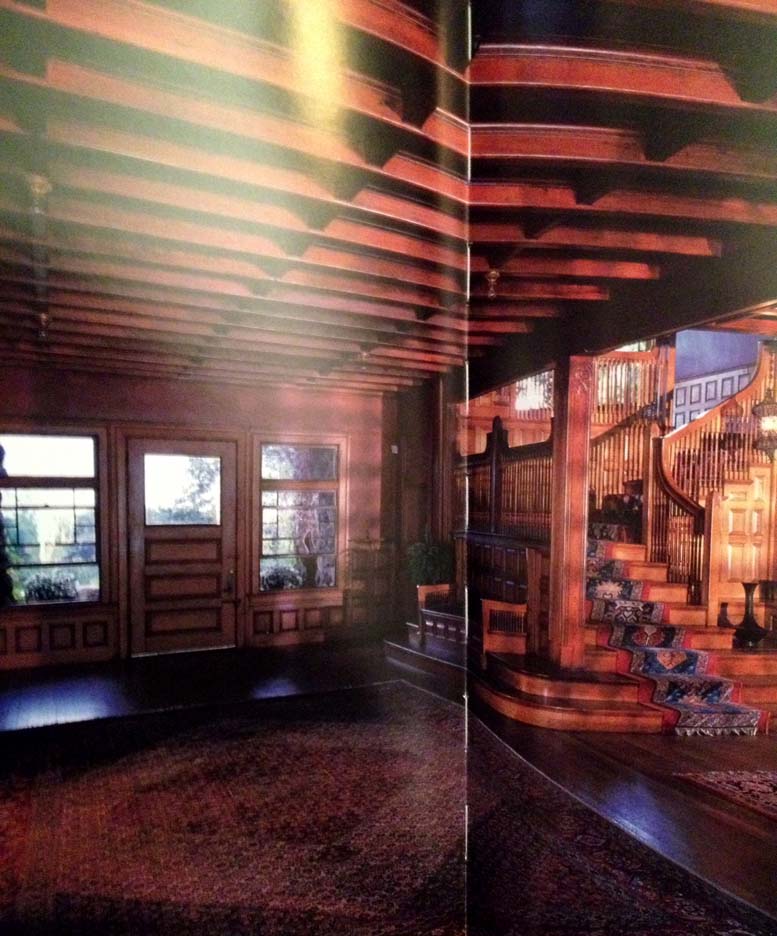
Interior of the vast living hall of a Shingle Style home. Desirous woodwork. From Shingle Style: Innovation and Tradition in American Architecture 1874-1982, by Morgan and Roth. Photograph taken by Bret Morgan. I would later find Stonehurst in Massachusetts. I can dream, right? From The Visual Dictionary of American Domestic Architecture by Rachel Carley, “Like the Queen Anne style, the Shingle Style was influenced by the work of the architect Richard Norman Shaw (1836-86). On the exterior—stripped of excess decoration—shingles form a continuous covering, stretched smooth over roof lines and around corners in a kind of contoured envelope.” Henry Hobson Richardson is credited with developing the style.
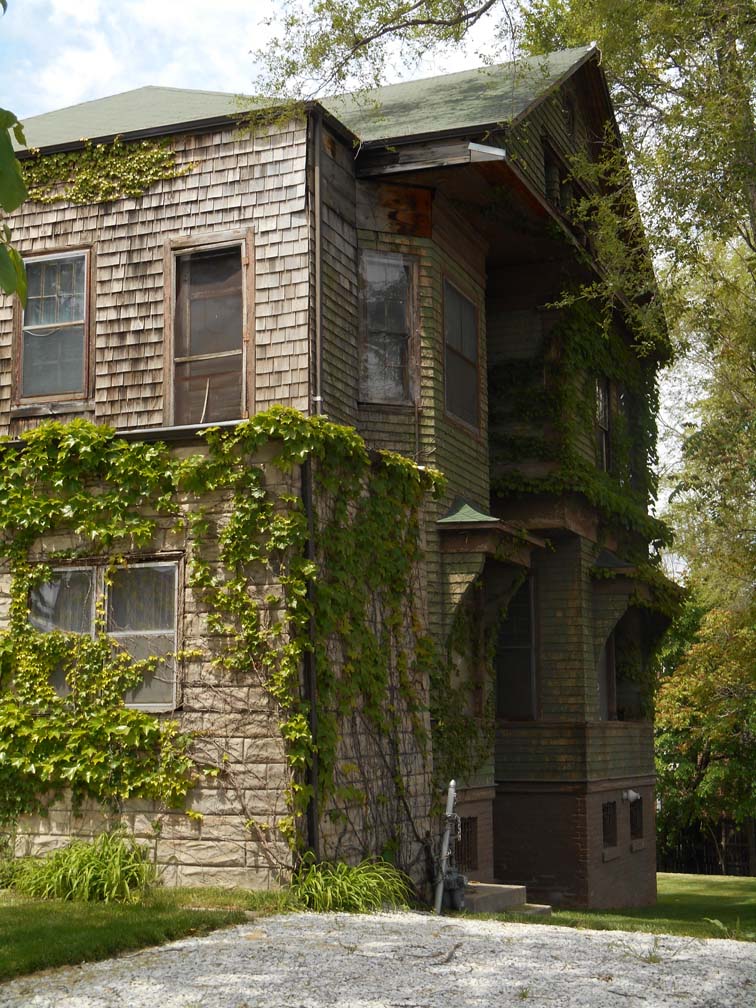
East side of 2226 Howard
From A Field Guide to American Houses by Virginia Savage McAlester, “The Shingle Style does not emphasize decorative detailing at doors, windows, cornices, porches, or on wall surfaces. Instead it aims for the effect of a complex shape enclosed with a smooth surface (the shingled exterior) which unifies the irregular outline of the house.” Decorative detailing is used sparingly. “It is the first style that begins to emphasize the volumetric spaces within the house more than exterior surface details.” Towers are found in about one-third of Shingle houses. A simple porch would have been common. Window surrounds are simple; bay windows are common. It never gained as wide popularity of its contemporary, the Queen Anne style.
I was putting together that the Shingle Style was a combination of three architectural styles. It has roots in the Queen Anne with its shingled surfaces and asymmetrical forms. It borrowed the gambreled roof from Colonial Revival movement and from the Richardsonian Romanesque it borrowed irregular, sculpted shapes and stone lower stories. “It was an unusually free-form and variable style; without the ubiquitous shingle cladding it would be difficult to relate many of its different expressions. One reason for this great range of variation is that it remained primarily a high fashion architect’s style, rather than becoming widely adapted to mass vernacular housing.”

2226 Howard leaded glass windows–each distinct.
This Omaha home made a clear statement about its owner. The Shingle Style wasn’t about indulging in the obvious fuss and the extravagance. This was the Insiders’ Wink. The Old Guard mastery of nonchalance. Twas far more privileged to have a taste for Roughing It. And those aging shingles, regardless of locale, would only continue to demonstrate that point of casualness as the decades rolled by, weathering to perfection, as if right near the Southampton seaside…. but it was right here in Omaha. How did it end up downtown? I would soon find 2226 Howard Street had the most strange and varied history of any investigation I had ever been on. Quite frankly, this beauty deserves a book all her own.
2226 Howard: The Shingle Style
In studying this home, I instantly thought that the stone front was added later. Somehow it did not look like the rubble rock of other Shingle Styles’ foundations. It would have been typical of the Shingle Style to have a more prominent porch. Had this stone-enclosed room off to the right been added later or was it originally a part of the porch? According to the Douglas County Assessor site there is an “Add-on of natural stone/moss rock.”
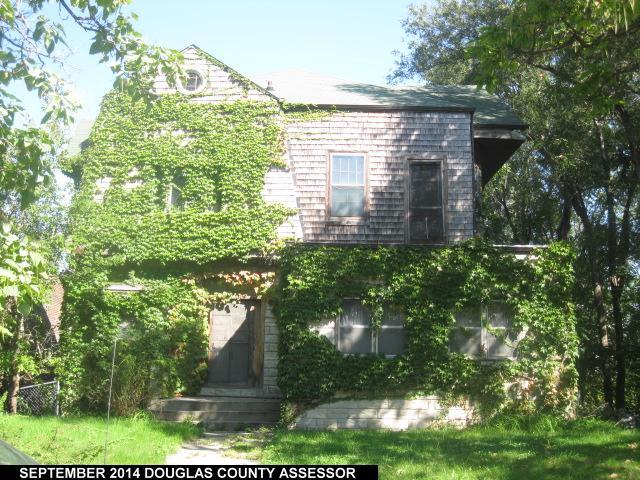
Photo from the Douglas County Assessor site. Its proper name is 2226 Howard. Lot 1 of City Block 0 in the Jefferson Place Addition.

Floor plans from the Douglas County Assessor site. The site reported the home to be 3697.0 sq ft.
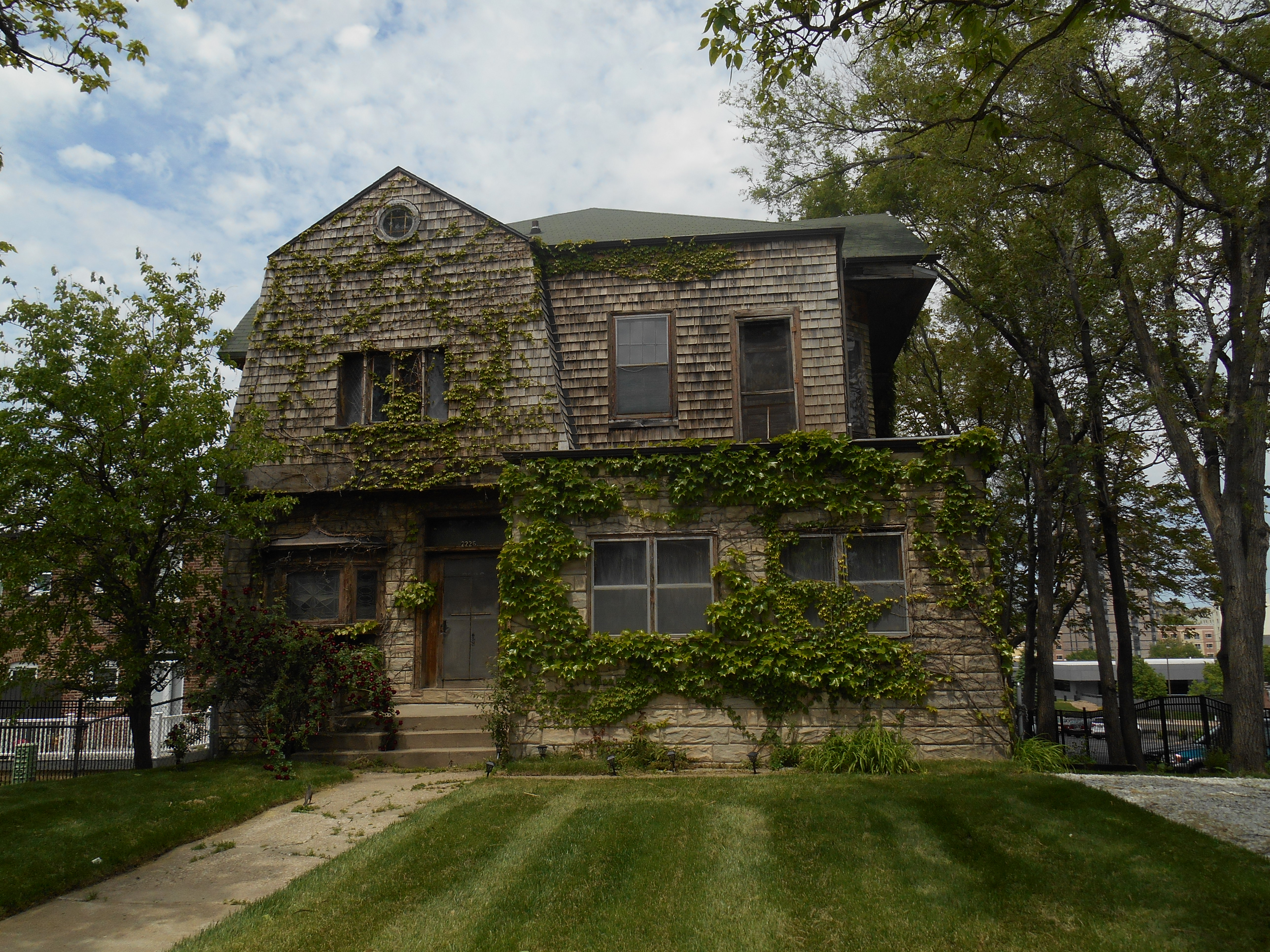
Although this house has a side-gabled roof, the dominant front-facing gambrel places it in the “gambrel subtype” or sometimes called a gambreled, cross-gabled roof.
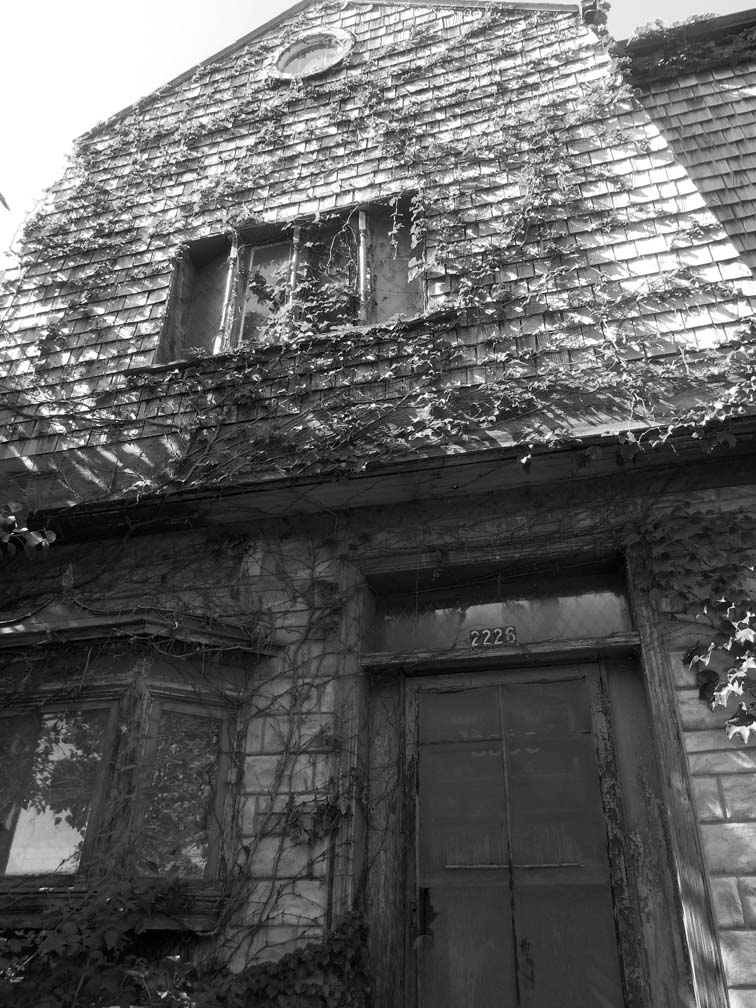
Four leaded glass windows with Queen Anne spindle work upstairs. This very top rounded window reminds one a classic New England summer home.
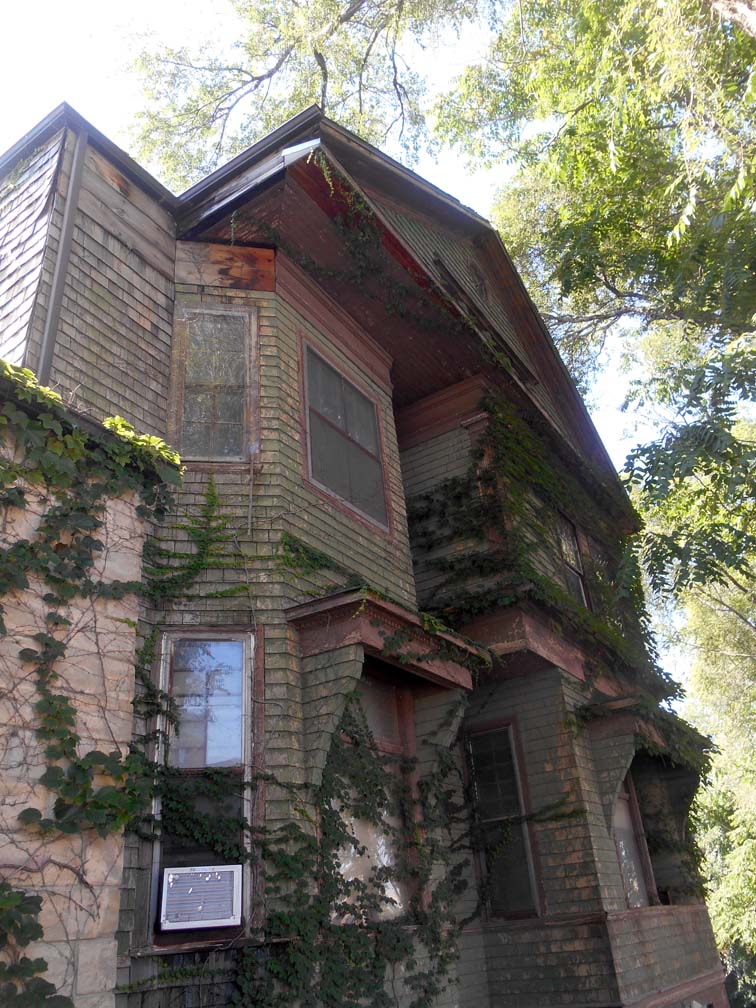
Three floors—or just a secret attic view? Another round window is visible. Eight lights over one sash windows seen throughout the house. Lovely.
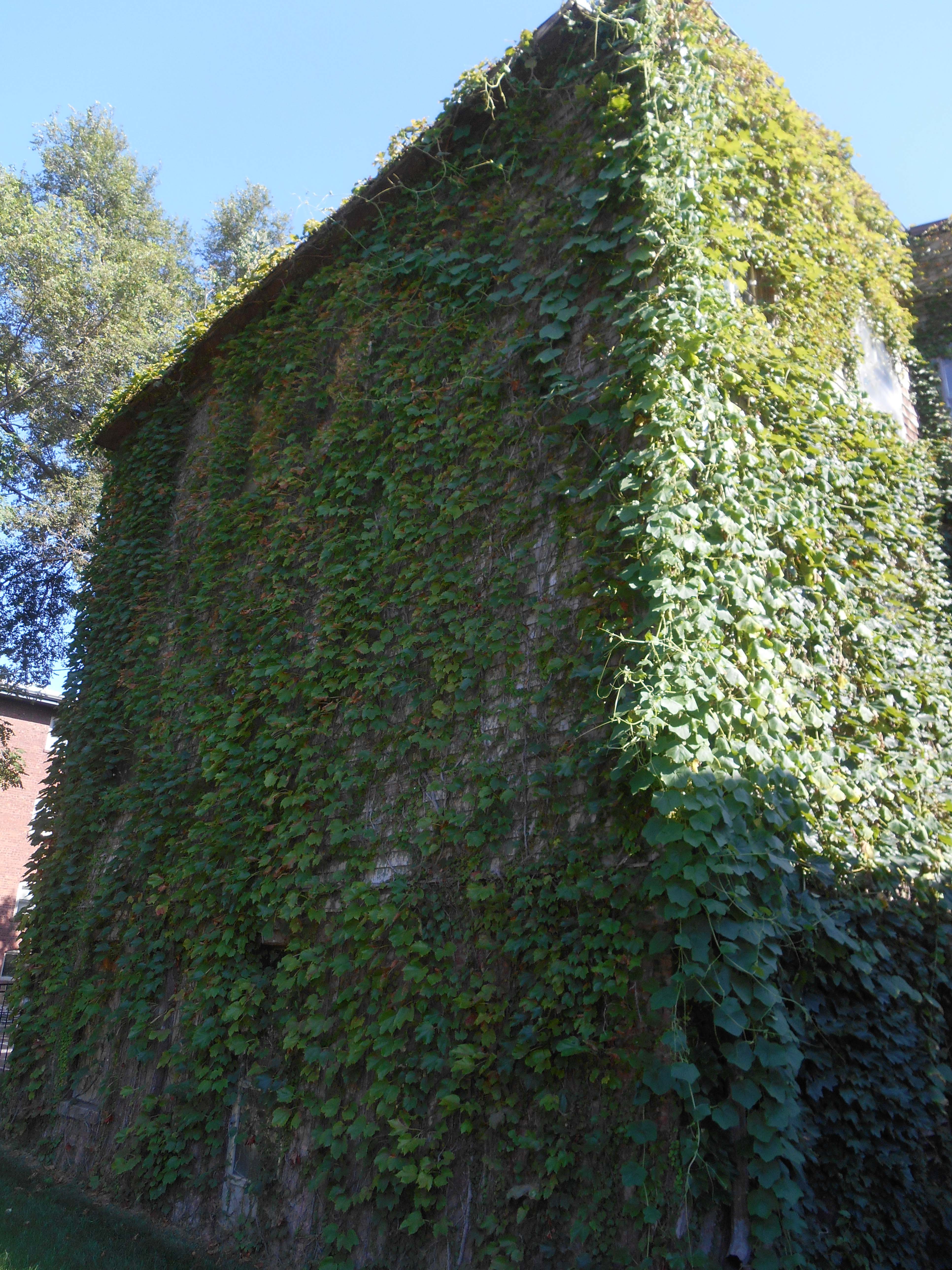
Virginia Creeper vine enshrouding the back of the house. Thank you. Don’t mind if I do.
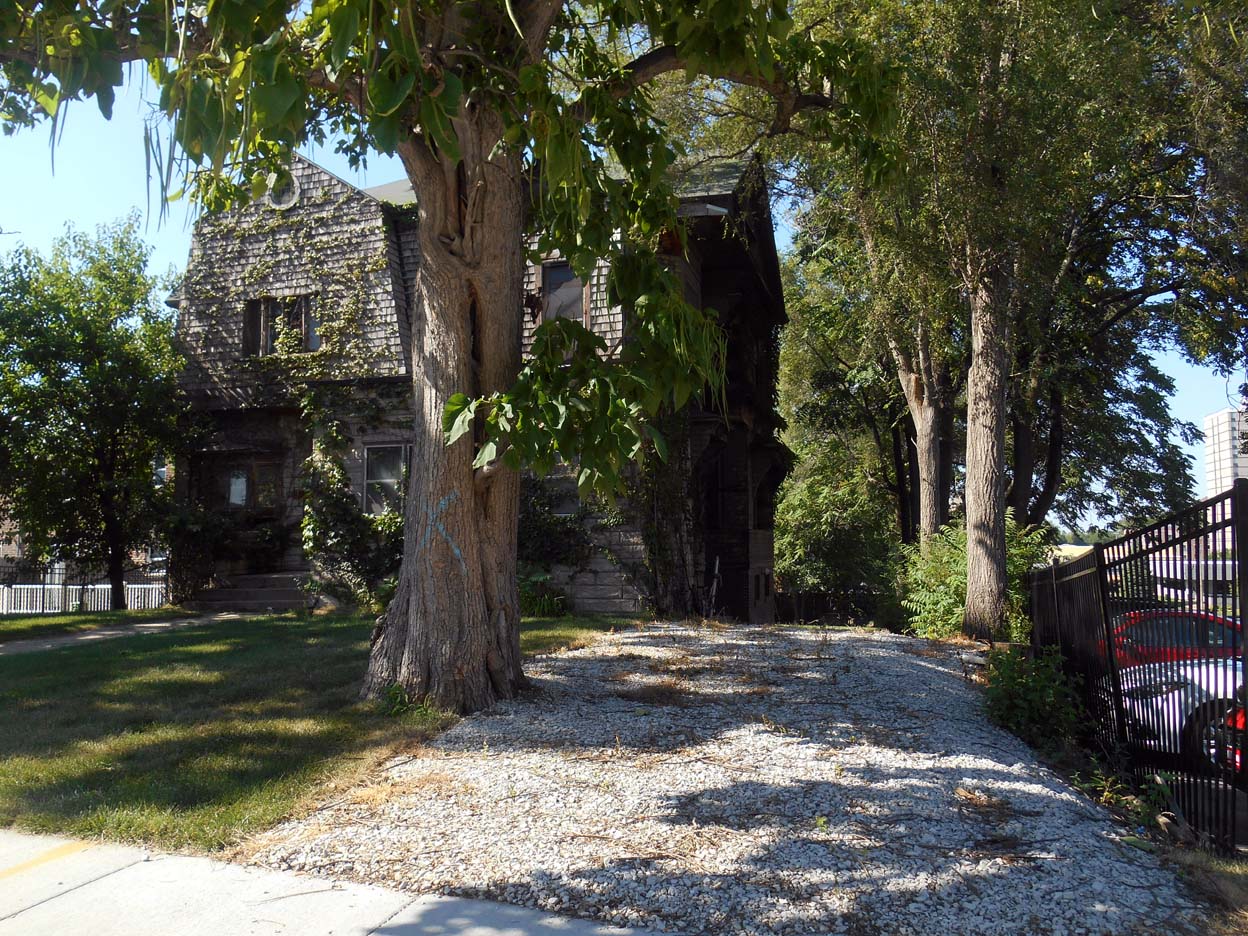
Two Catalpa trees are in the front yard. What looks to be an old gravel driveway runs part way on the east side of the property. No longer used. There is no garage and no carriage house behind the lot.
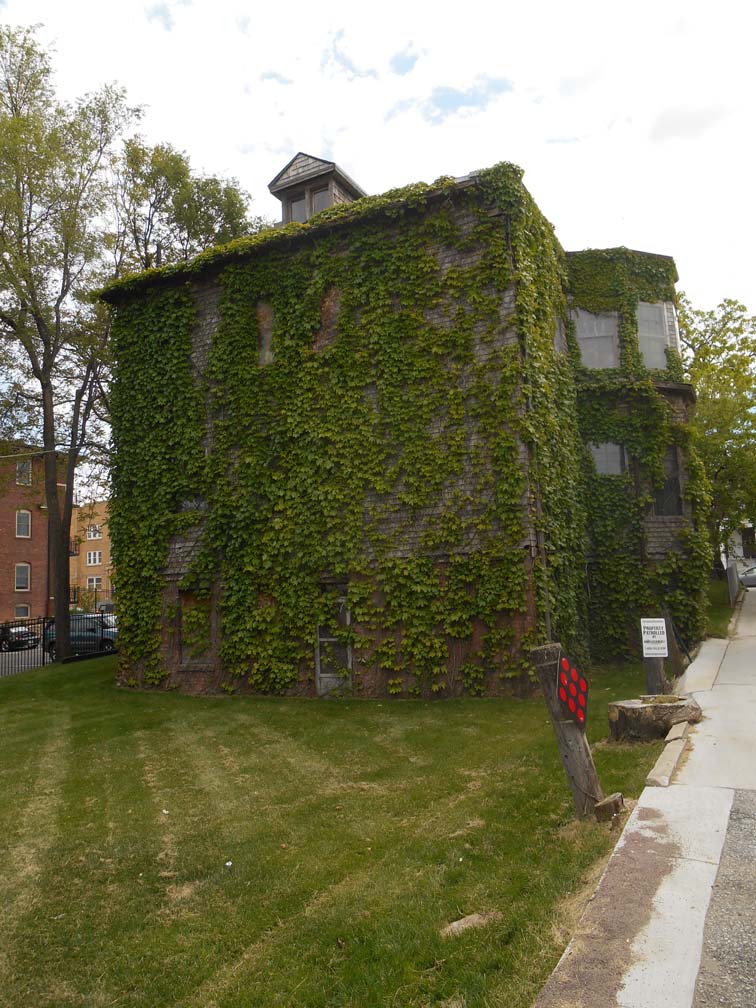
Gabled dormer window in the rear of house. North side.
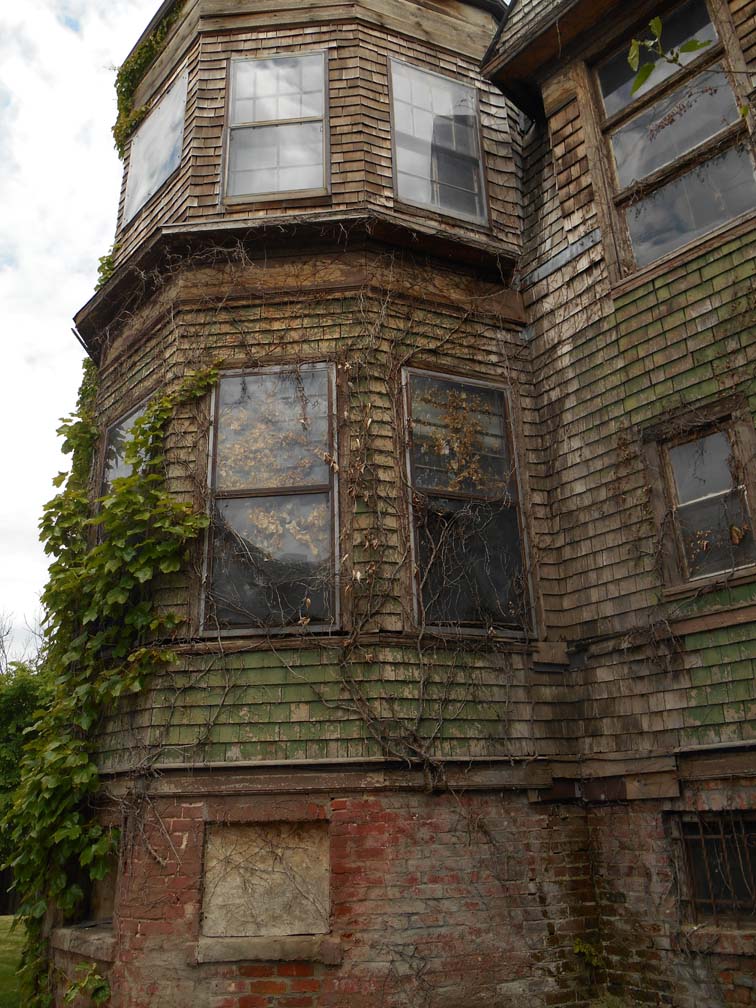
Two story bay windows in the tower—common of the Shingle Style. In this photo one can see the green painted shingles that were mentioned in the historic form earlier. This is my favorite photo of the house. I want to know what that lowest level, brick portion is like on the inside. Dying.
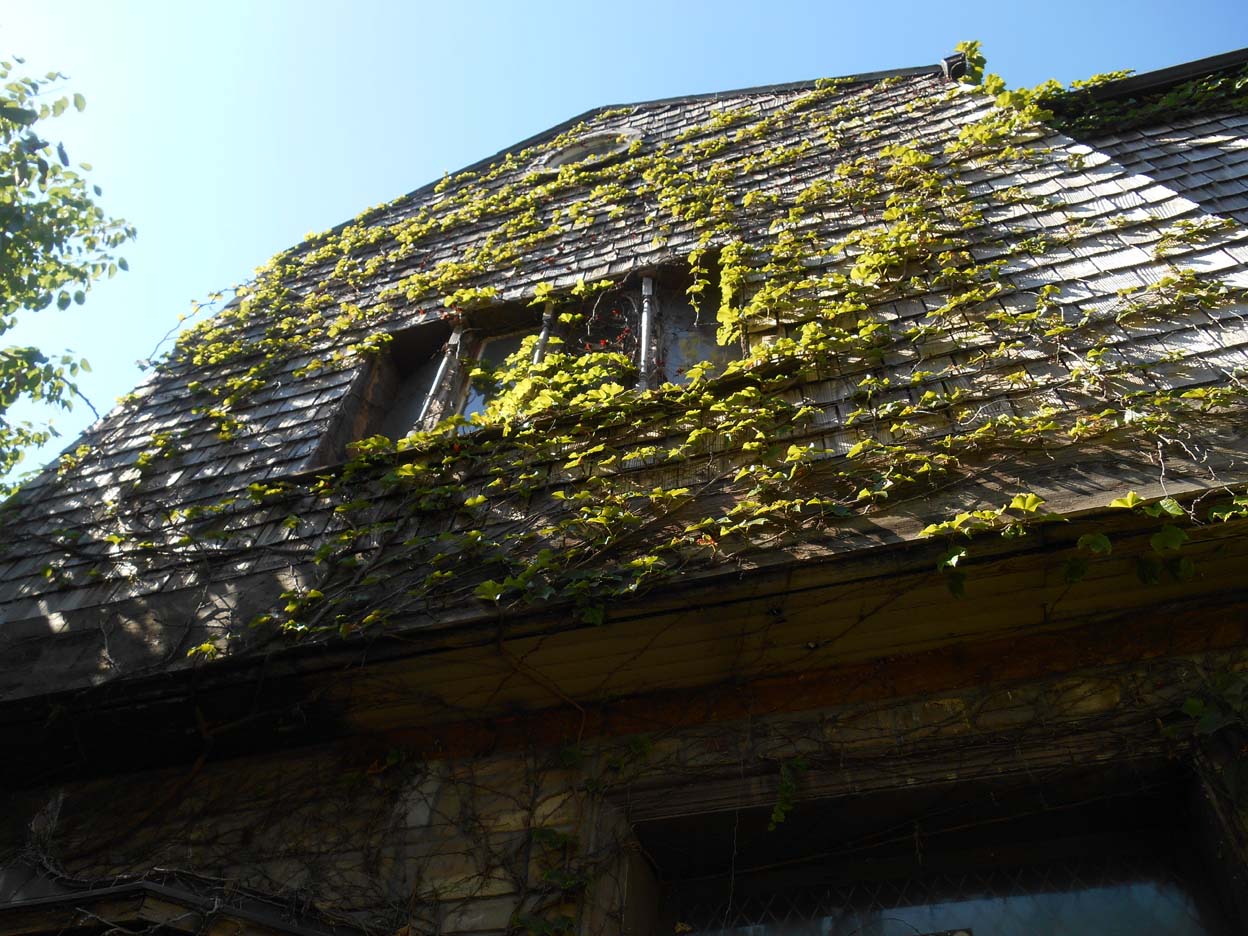
Spindle work of the Queen Anne commonly incorporated into the Shingle Style look.
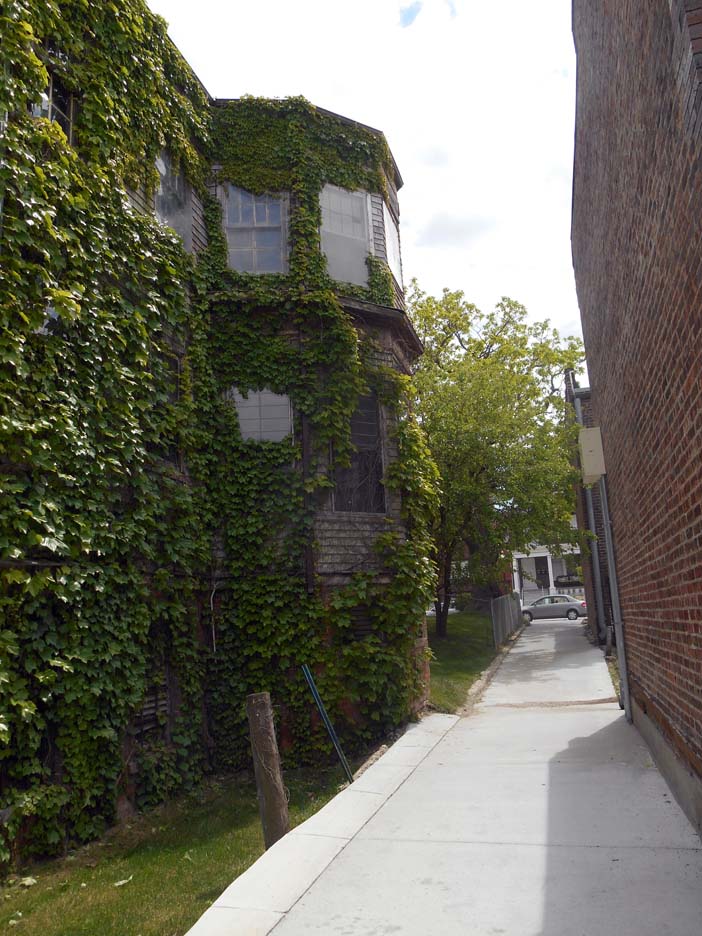
Asymmetrical forms frequently seen in the Shingle Style. This is a great little footpath on the west side of the home. It leads to the Dewey Avenue homes. Don’t forget to peek back here on your visit. Fascinating.
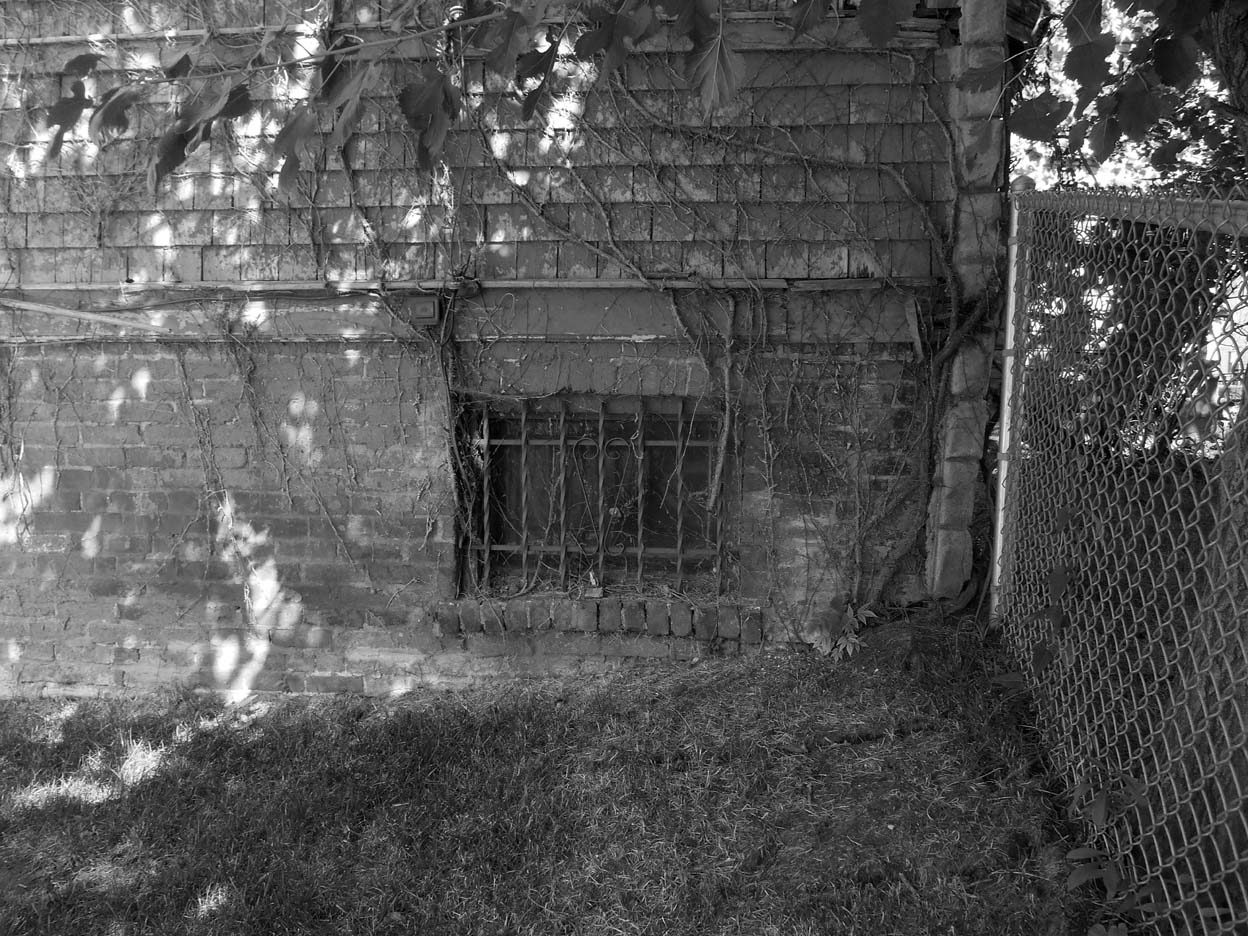
Rusticated stone foundation on lower story common. 2226 Howard displays brick. Photo taken of the western side of property. I love the twisted ironwork on the basement windows. Can you imagine the details inside? I’d die a hundred deaths to step into this home. But we are not dead yet. Are you still following with me? This will certainly be a long braintwister of a story and I’m getting chills.
Early History of the Area
From American Guide Series Omaha: A Guide to the City and Environs written and compiled by the Federal Writers’ Project Works Progress Administration State of Nebraska information gathered from 1935-1939. Nineteenth Street on Howard was “Once of the finest residential streets of Omaha. Here lived such prominent citizens as George Hoagland, James Woolworth, Charles Turner and Herman Kountze. The site of St. Mary’s Cemetery was on the corner of 24th and Howard Streets, now covered by apartment houses and small shops. St. Mary’s was the first Catholic burial ground in Omaha. It was part of a ten-acre tract of land purchased by Rt. Rev. James M. O’Gorman, vicariate of Nebraska Territory in 1863. It had a natural growth of timber and along its east boundary ran Otoe Creek. The cemetery was abandoned in 1873 due to the encroachment of the city and the bodies were re-interred in Holy Sepulchre Cemetery on Leavenworth.”

Holy Sepulchre Cemetery sign. In 1885 when Harney Street was graded, all trace of the cemetery disappeared. Photo from the Holy Sepulchre site.
Through Larsen and Cottrell’s dense, fascinating book The Gate City: A History of Omaha, I learned that by 1870 the Omaha western-most city limits extended to present-day 36th Street. By 1880, along with the Union Pacific Railroad, Omaha was served by seven other rail lines and its population had quadrupled. Richard Orr’s book Streetcars of Omaha and Council Bluffs, mentions that by 1889 there was a streetcar route and horse care line along St. Mary’s Street. It would make sense that wealthy business owners would want to build on the western most edge of the city, as that has traditionally been the pattern in this town. Move west. Yes, you’re beginning to understand how one would come to live on Howard Street. This high point was truly the high-end of the street. A plateau of sorts of which to look down upon the rest of Downtown Omaha.
Early Blunders
I was thrown a curve ball early in my investigation when I learned from the City Planning records that 2226 Howard Street was built in 1913 by architect Hodd Peterson of Peterson and Dodd. I was ecstatic! The client was Dr. Slabaugh. I hungrily gathered my clues and found he was famous Omaha dentist, turned latent real estate mogul: Slabaugh Realty. How did I get this fortuitous break so early on? But also this was all a misstep in their recording of data. It turns out Dr. Slabaugh owned Lot 7, 2227 Howard, the Bartlett Apartments. Later I found the 2217 Bosworth Apartments credited to Dr. Slabaugh. Oh my…this was the way things were unfolding. Not tidily.
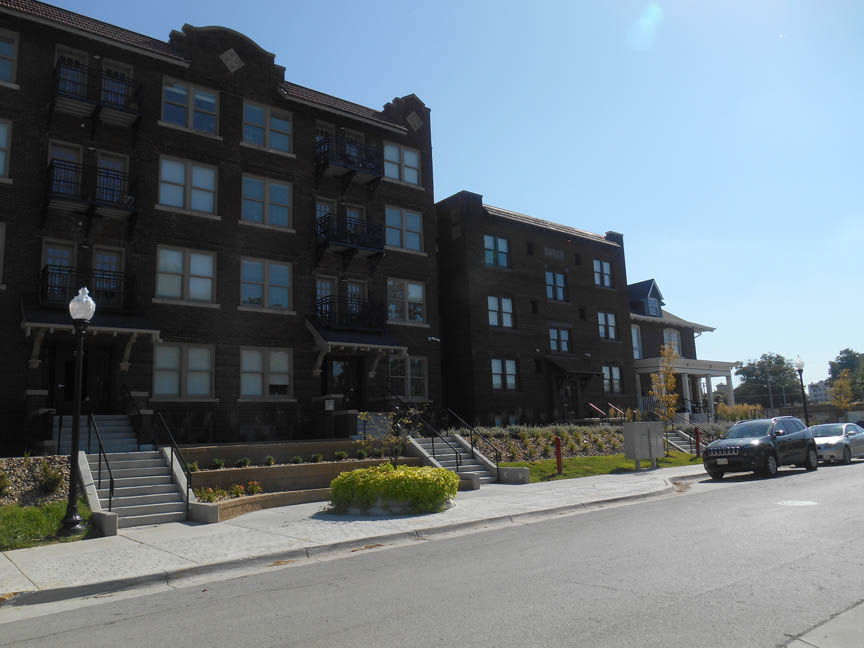
The Bosworth Apartments at 2217 Howard on the left and the Bartlett Apartments at 2227 Howard on the right. These fine apartments are on the south side of the street, across from 2226 Howard. Through An Inventory of Historic Omaha Buildings prepared by Landmarks Inc in 1980, I found 2226 Howard remained a mystery, including their architectural style labeling of “Queen Anne.” There was no information on original owner, builder, architect or cost. I would have to continue on my search.
Howard Street
From the Streets of Omaha: Their Origins and Changes compiled by H. Ben Brick, I learned more about lengthy, east-west Howard Street. Howard Street was named “In honor of Colonel Howard, father in law of Henry Farnam or possibly named for Robert A Howard, one the Omaha’s first attorneys or possibly also took its name from General Tilman A. Howard of Rockville, Indiana, a prominent lawyer, special envoy from the United States to the ‘Lone Star republic.’ It was mainly the good offices of General Howard that brought the great state of Texas into the Union. Its name changed from Capitol View Street between East Grove Street (now 33rd St) and Isaacs Street (36th Street) in Isaac’s and Selden’s Addition, and from Hurford Avenue between 20th Street and 21st Street in Oak Knoll Addition. There were at least four other Howard Streets running north-south and east-west at different times, now have all changed their names.”
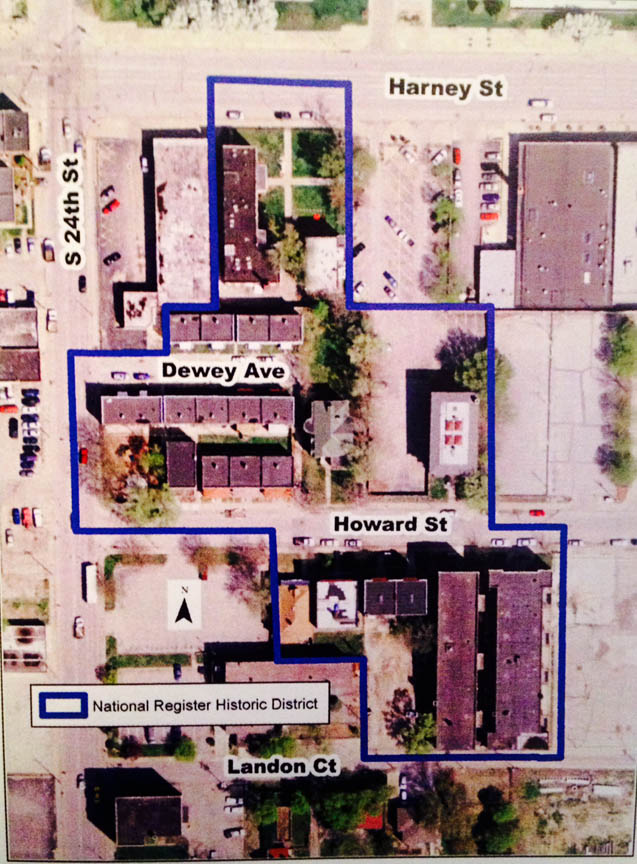
Photo from the Reconnaissance Survey of Downtown and Columbus Park Omaha report by Gredler, Long and Pettis: Howard Street Apartment District Boundary Map.
Harrison Johnson and My Trials at the Deeds Office
Let me tip you off to this, if you’ve never been to the Register of Deeds office. Any deed, pre-dating 1910, is in their database–not in the lovely handwritten ledgers that I adore so. The computer files are pretty insane to navigate and I groan a bit when this is part of an investigation. I am not blaming the Deeds office. They are so friendly and generous with their time. It is a fright for even the most skilled of amateur sleuths. So with that tucked away in the back of your mind, I offer up my findings, although these should be taken with a grain of salt—meaning, this is but a Guessing Game of the general area of Jefferson Place, previous to formal platting.
I believe that the land near or encompassing 2226 Howard was owned by Harrison Johnson, previous to 1857. Sarah A. Johnson owned the property by July 1861. Through some deep digging, I found out later that Ms. Johnson was Harrison Johnson’s mother. An employee at the Register of Deeds office said that this area (around 22nd to 24th and Howard) appeared to be broken into many lots (most likely farmland) and sold at different times over the years. I won’t take you down that rabbit hole list of names, as we have enough information to cover just sticking to the facts, but believe me—it was a hideous mess to trek through in search of leads. And I loved every minute of it.
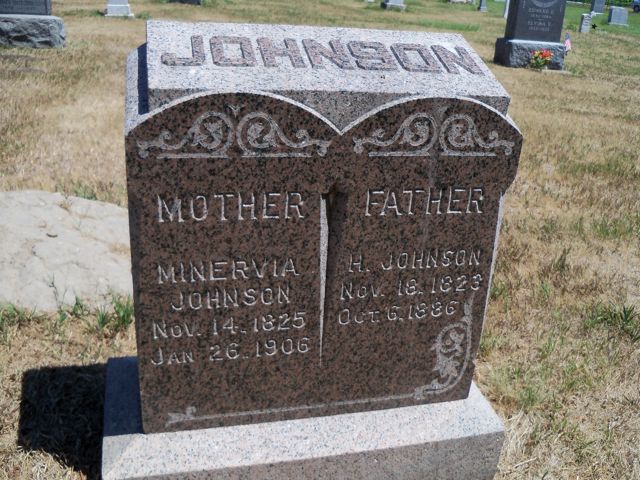
Harrison Johnson grave site in Brown County Nebraska. Photo from the Find a Grave website.
The U.S. Census of 1860 (thanks to the familysearch.org site) showed Harrison Johnson at age 37, a farmer. His wife Minervia 34, and their seven children, all under the age of 15 lived in the home. My word. In addition there were four farm laborers living with the family. Also living in the house was Sarah Johnson, age 60, Harrison’s mother. Harrison Johnson’s 1885 Omaha World Herald obituary referred to him as “A well known citizen. A man of scholarly tastes and is best known as the author of a history of Nebraska.” Our kind of guy. (I just want to point out that his obituary was from 1885 but his headstone says his death was in 1886.) Nearby neighbors shown in the 1860 census were the Poppletons, Clarks and Frengels. Many months later I would learn from the American Guide Series Omaha: A Guide to the City and Environs that Harrison Johnson, called “an early settler” apparently carved the trail, later a country road to downtown. As the city grew, additions were platted along the road and it became a St. Mary’s Avenue. Interesting side note: St. Mary’s Avenue hill was very steep in the early years; passengers of the horse drawn streetcars frequently had to get off and walk until the cars reached the summit. The hill was graded and cut down in the late 1880’s. I would find out later that the same steep hill on Howard Street would be graded between 1920-1940.
***Addendum as of 4/30/2017*** I just found this Omaha map published by Oscar F. Davis, surveyor and real estate agent, 1866. Notice the name H. Johnson on the middle left hand side very near the Howard Street property, along what would become St. Mary’s Avenue. Used with permission thanks to the David Rumsey Map Collection, www.davidrumsey.com.
The trail through the deeds was a muddy mess, much like old St. Mary’s must have been but one clear pathway that seemed to make the most sense was that of the Guy C. Barton connection. “Sarah M. Kitchen and Sr.” sold to Guy C. Barton in November of 1890, a name I knew I recognized.
The Barton Family
Guy C. Barton acquired the land that 2226 Howard would later inhabit on November of 1890. Guy C. Barton “and wife” then put the deed in their married daughter’s name the very same month.But I didn’t know she was daughter just yet. Jessie Rollins became the owner of 2226 Howard in November of 1890. This wet behind the ears gumshoe wanted to know more.
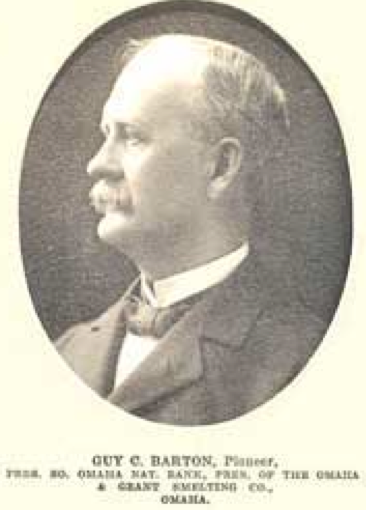
Guy Barton photo from the Find a Grave website.
Now…. according to the 1880 U.S. Census, Guy C. Barton, (45) and wife, Saphia (have also found it spelled Sophia) Dewolf Barton (42) lived with their daughter, Jessie, (21) and son, King Charles “K.C.” (19). They had another daughter, Frances, who wasn’t living at home at the time.
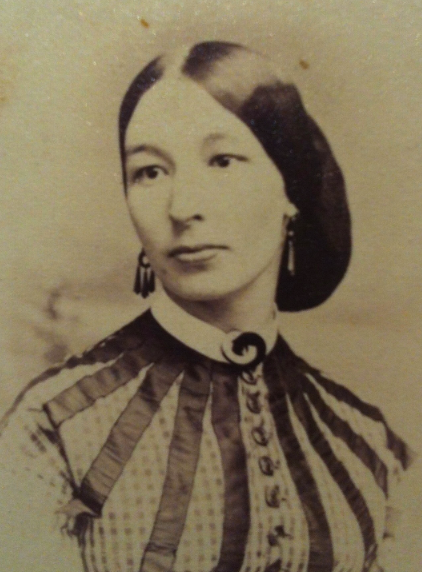
Sophia or Saphia Dewolf Barton. An exotic beauty with fabulous taste in clothing, jewelry and hairstyles–I am assuming from this faint-worthy photograph. The detailing on this dress is AMAZING. That collarpiece, buttons and satin ribbon design…
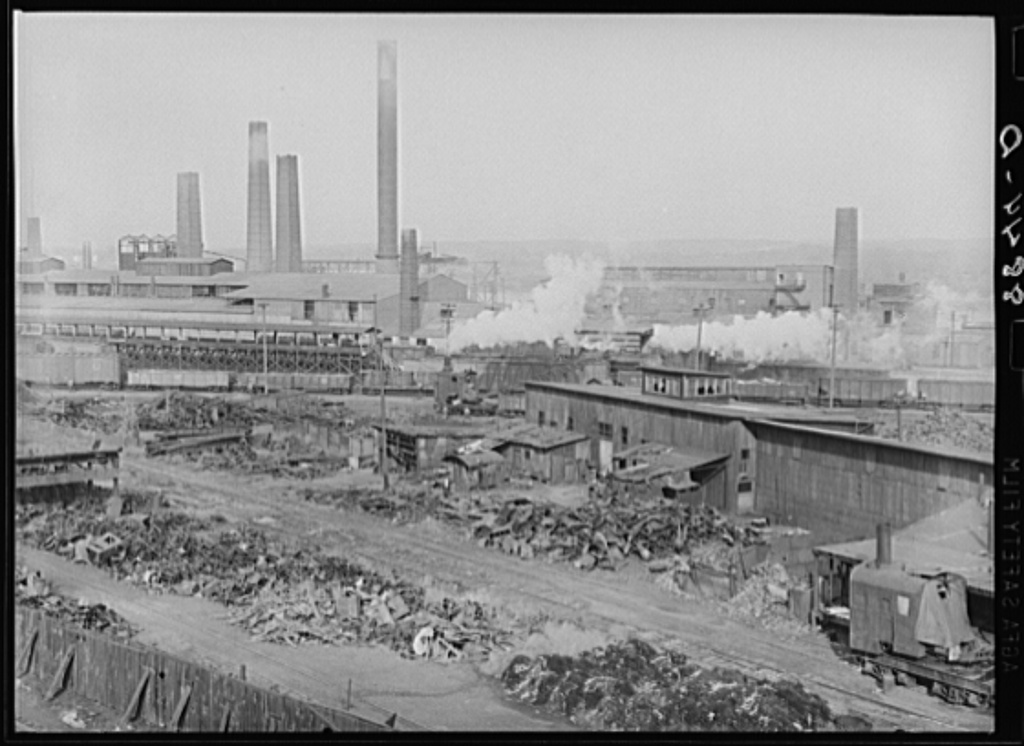
Omaha and Grant Smelting and Refining Company photo from the Library of Congress website. I have written this company previously in The Secret of Burt Street. I had heard the name Guy C. Barton many times through my Omaha investigations and had always hoped “Guy” was pronounced the French way. Guy Conger Barton was a remarkable man. President of the Omaha and Grant Smelting and Refining Company, as well as vice president of Omaha Horse Railway Company, Barton is mentioned often in Omaha history books. Savage and Bell’s History of the City of Omaha Nebraska wax unapologetically about Guy’s outstanding painting collection, of all things. He was also a one-time newspaperman, a rancher, a banker and enjoyed a stint in politics as speaker of the house.
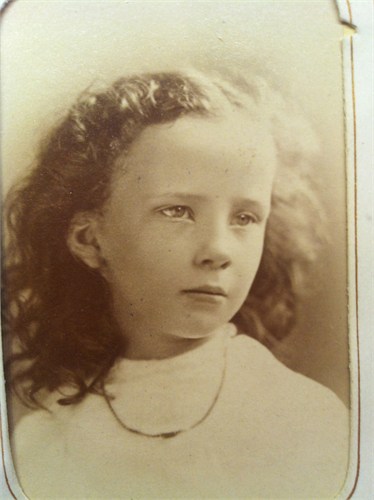
The Barton’s daughter, Young Jessie.
In 1886 the family residence was at 2103 California. Miss Jessie Barton was living with her parents. In time I would find Jessie Barton Rollins featured in Omaha’s Society Pages (leading me to believe she was married) brushing shoulders with the likes of the Patricks, the Poppletons, the Gallaghers, the Millards, and the Woolworths. But her closest girlpals all appeared to be single: Miss Dewey, Miss Yost, Miss Hoagland and Miss Millard. (And we already know we like Miss Bertha Yost.) This was The Omaha Clique. One party in particular, “Jessie Rollins was attired in a pink silk costume, very elaborate” where she “did the honors at the chocolate urn.” Yes, they said chocolate urn. I could go on and on about this group of girls and their antics. In one hilarious article, the journalist was detailing a fun girl day out and about in town in one of the girl’s Peerless automobiles. While driving, Miss Jessie Millard “got stuck in a bit of gumbo.” It went on and on about their adventure. Brilliant writing.
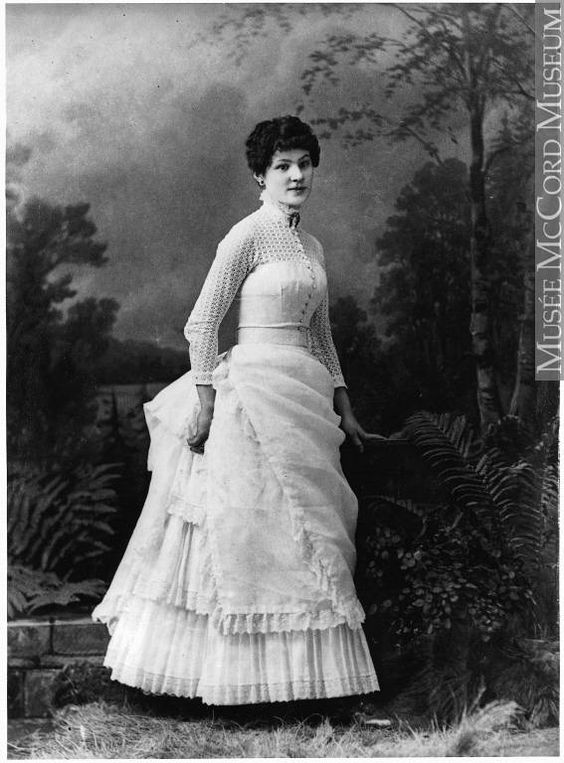
A dress from the later 1880s.
And there was a clue to yet another marriage for our Jessie from 1897: “The announcement of the approaching marriage of Mrs. Jessie Rollins, daughter of Mr. and Mrs. Guy C. Barton, to Mr. George Christiancy, formerly of Omaha.” I thought this was unusual for that time and assumed maybe Mr. Rollins had passed away at a young age. Elsewhere along the way I found listings for Mrs. Jessie Barton Christiancy living in New York. These were all just fragments of evidence that would not make sense for a long time.
The J. H. Millard Clue and Development of Jefferson Place
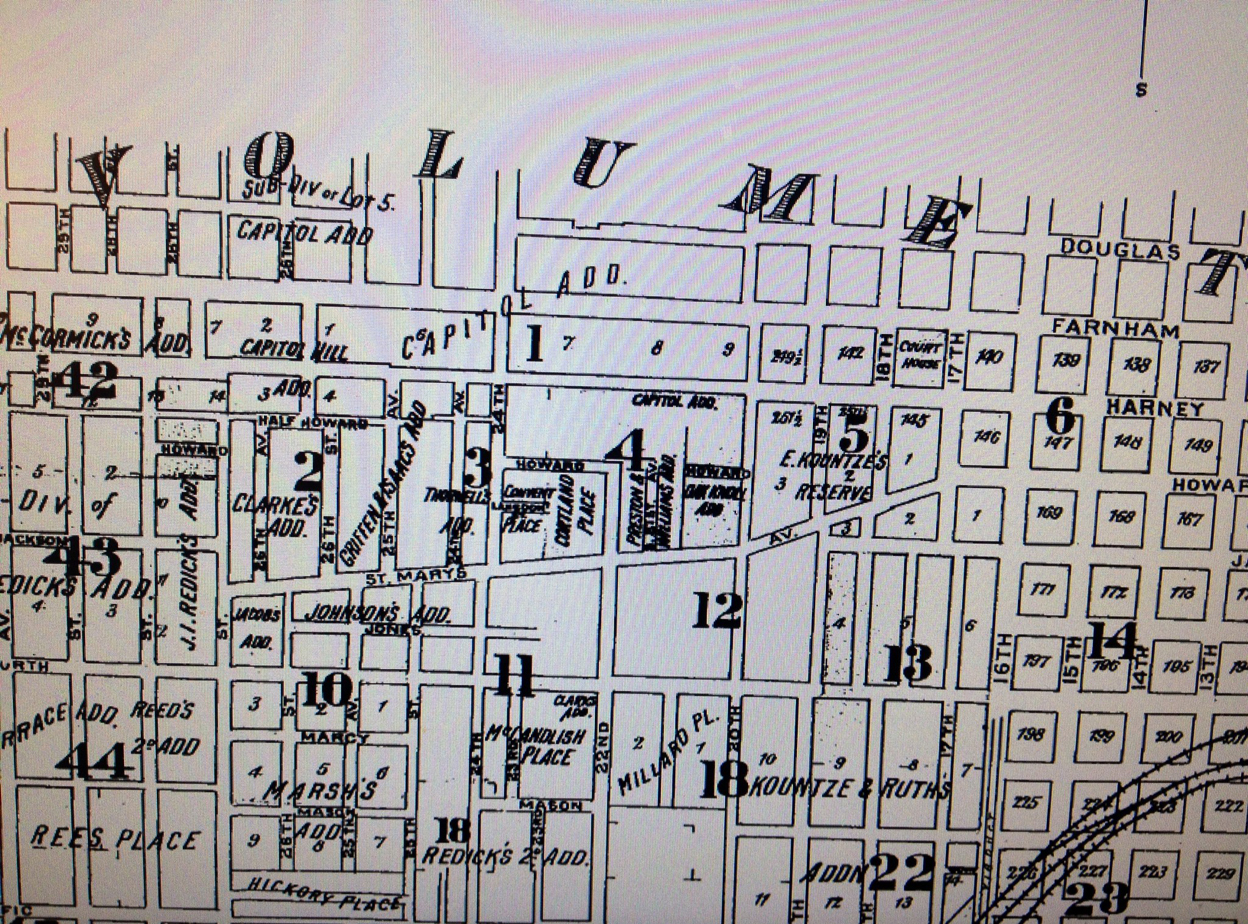
1890 map of the downtown area. Thank you to Trina Westman of the Omaha City Planning Department for sharing this.
Through the Register of Deeds paper work I found the cryptogram“J. H. Millard to the public 1890 plat.” What exactly did that mean? I had heard the name Millard, of course. Joseph “Joe” Hopkins Millard was the wealthy president of the Omaha National Bank. Another exceptional Omahan and close friend of Barton’s, Millard helped to organize the South Omaha Bank, as well as going on to be Mayor of Omaha and a U. S. Senator from Nebraska. Does anyone else wonder how these pioneers found the time to have a hand in so many operations?

Joseph Hopkins Millard. Photo from Find a Grave site.
I was not entirely sure if J. H. Millard had actually owned the 22nd and Howard property, or if he was involved in creating the original public land survey plats for the official legal record? I discovered through many articles that Barton and Millard were friends, (as were their whole families), business partners and big names in early Omaha.
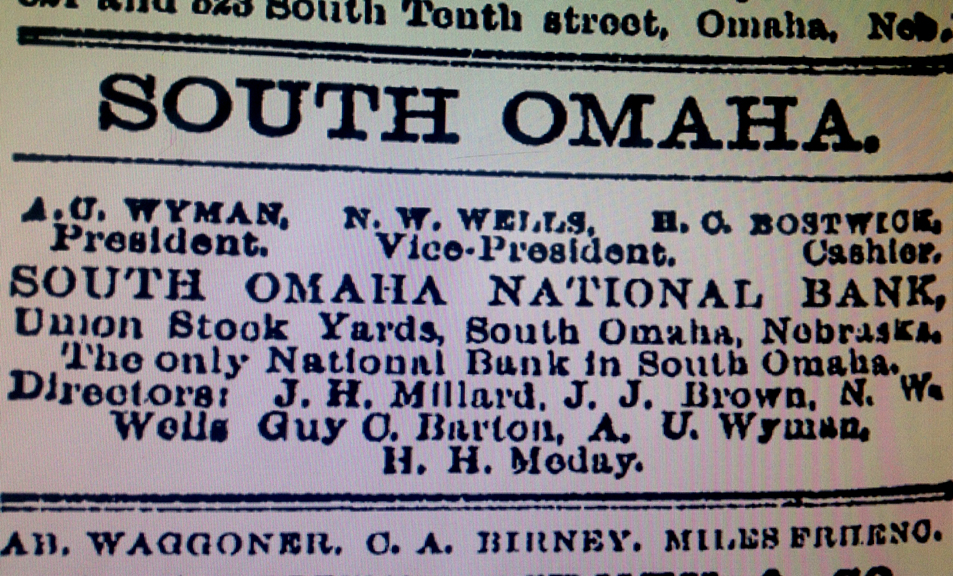
South Omaha Bank ad, Omaha World Herald from Feb. 20, 1890, listing directors Millard and Barton.
From the U.S. Census of 1880, the Millard family lived at 1616 Farnam Street. J. H. Millard was a 43-year-old banker. Born in 1837 in Canada. His wife was Caroline Barrows Millard, age 42. Their son, Willard (18). Yes, that’s right: Willard Millard. Hmmmm. I think I had better throw in that I would later discover that Willard Millard married Jessie Barton’s sister, Frances. Jessie Millard (16). Mary Higgins (21), their English servant. Maggie Henderson (23), Scottish servant. I had assumed that Millard had presented the land as an officiary of some sort until months later I found a brief mention in the Omaha World Herald from October 24, 1890. “J. H. Millard et al to public, dedication of Jefferson Place.” This meant that Joseph Millard, the landowner, offered his land for public use, the offer was then accepted for the sale of lots to be developed into Jefferson Place. In the end 2226 Howard was in Guy Barton’s daughter’s name: Jessie Rollins.
Not Quite the Right Fit
2226 Howard is on the Douglas County Assessor’s site as having been built in 1885. Likewise the Register of Deeds Office showed that 2226 Howard was filed by legal description in 1885. It showed up in 1889 under “historical index” but at least a portion of the land was replatted in October of 1890. What did all of that mean? Who designed the home and for whom was it built? All I had come up with was a bunch of dates but no real color, no storyline. The Bartons, to include Jessie lived at 2103 California in 1886. Did they build 2226 Howard as a gift for Jessie’s marriage to the mysterious Mr. Rollins? Miss Cassette had found these extravagant types of matrimonial gifts in these mysteries before. The truth in all of this was puzzling.
Sanborn Maps: Tips to the Past
Trina Westman of the Omaha Planning Department generously sent me over the Sanborn Map of 1890 (and many other years as you will soon see.) Sanborn Maps are so very cool and I’m pretty obsessed with them. The maps are large-scale documents of changes to the built environment, originally produced for fire insurance liability purposes. Every major city has Sanborn maps on file. Of note: by the late 1950’s a young Warren Buffet began buying shares of the company.
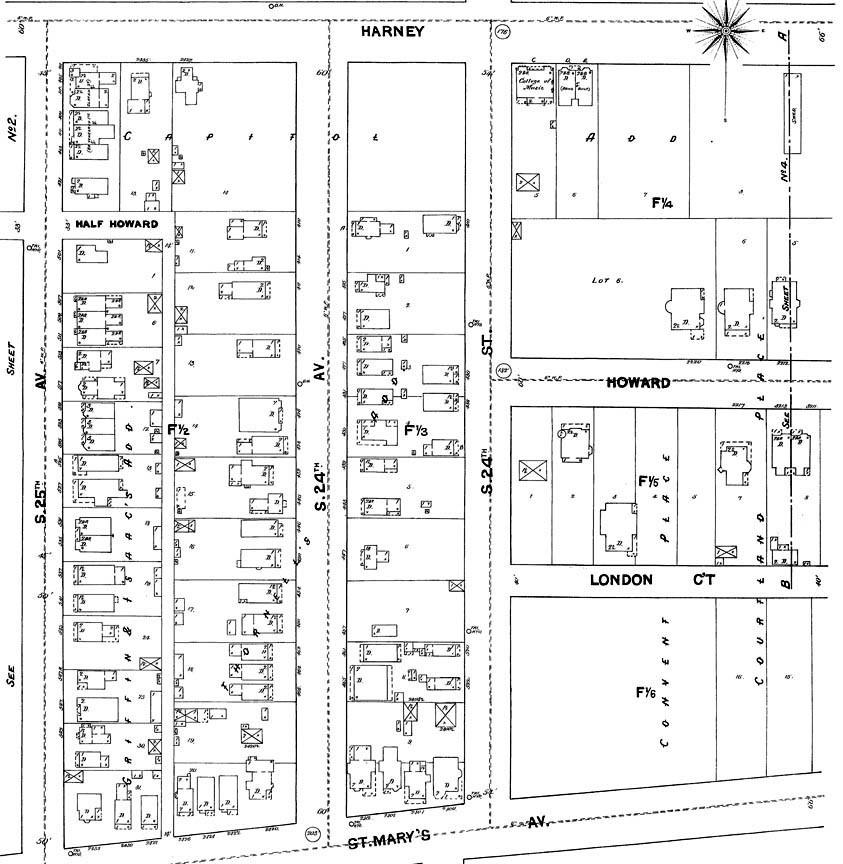
1890 Sanborn Map showing 2226 Howard was present on site but is shown as a part of Lot 6. Howard Street was not a through street at that time. In order to enter the neighborhood, one would have to head north on 22nd Street from St. Mary’s Avenue. Although labeled incorrectly as Lot 6 (did it change or was it a mistake?), you can see that the dimensions of 2226 were depicted as they are today in this early Sanborn drawing. Also you can see that there were other large homes next door and across the street–for instance a home with almost the same dimensions directly to the east, what would have been 2224, now an empty lot. The incredible Kimball home, previously shown on St. Mary’s Avenue is not yet built.
Breakthrough Clues of the Kitchen Family
Eight months later into my investigation, I found the clue that cracked the case wide open.

November 16, 1890 Omaha World Herald small article stating that Guy C. Barton had bought the Kitchen home for daughter, Jessie and “H. S. Rollins.” My Veronica Mars Mind was exploding and the puzzle could now be put together in the final hour.
I would learn that J. B. Kitchen Sr arrived in Omaha in 1881, representing the Kitchen Brothers firm. The name of Charles Kitchen came up later, presumably the brother, I thought. The Kitchen Company was in closing negotiations for the lot and building of the Grand Central Hotel. According to the OWH article of April 8, 1881,“The Kitchen Bros. are to build a good hotel, with no less than eighty rooms.” This was to be a first class hotel to replace the old Grand Central, which reportedly burned down in 1878.
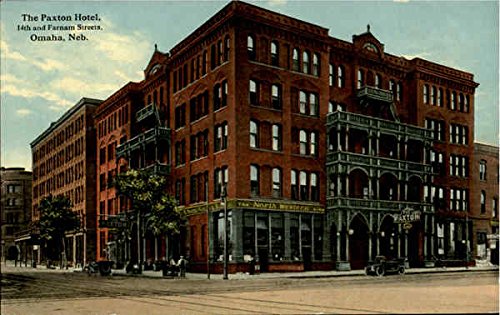
The original Paxton Hotel at the same location at 14th and Farnam. Brothers C.W., W.T. and J.B. Kitchen built the original Paxton Hotel in 1882 to replace the Grand Central Hotel. The Kitchen Brothers famously ran a number of hotels throughout America. After moving to Omaha, Sarah M. Kitchen, J. B.’s wife, began buying up properties in Omaha, while her husband’s company continued to build. In 1885 the Kitchen Brothers made headlines with a proposal to build a 60 feet high bridge from the Paxton Hotel across the alley to connect with Mr. J. B. Kitchen’s new building on Harney Street. By 1888, J. B. Kitchen was proprietor of the “new” Paxton Hotel. In 1928 the Paxton was replaced with the even newer art deco Paxton Hotel that we all know and love. If you want some more great details on the Paxton, check this out. http://www.thepaxton.com/about/history.php

I was able to back up and re-exam the remnants, digging into the early Sarah M. Kitchen lead. A pretty important pointer that I had missed in all those months was this permit from December 15, 1889. Sarah M. Kitchen’s building permit for 2226 Howard; the home was to be $10,000. $10,000 would have the buying power of roughly $271,000 by today’s standards. It would be a logical assumption that the Kitchen Brothers designed and built the Shingle Style home at 2226. Or did the Kitchens have an architect that they favored?
The Jessie Barton Rollins Dossier
I stumbled across evidence that pointed to Harry and Jessie Rollins living at 2018 Howard very early in their marriage. The couple was married in November of 1885. The Rollinses must have liked the Jefferson Place area well as this is just east of the Howard Street hill plateau. March 26, 1887 found Mrs. Harry Rollins “Looking for a girl who must be a good cook” for the couple’s home. The couple moved up the street to the Kitchen’s Shingle Style home in 1890 when Jessie’s parents bought them the property.

The saddest of the saddest articles from September 10, 1892. (Sorry, the article had been cropped too close by the online site but I hope you can make out the gist.) Apparently Jessie and Harry Rollins had a son, named “Little Guy,” after Jessie’s father. While Jessie and her brother, K. C., were away in Europe, she was notified of Little Guy taking ill. Jessie was not able to sail home in time and Little Guy died in her absence. I cannot be sure if he died at the family home. Not only that, but the family had the funeral without Jessie due to her not being able to get on a ship in time. I cannot imagine this young mother’s pain–the whole family’s pain.

Jessie Barton Christiancy photo from Find a Grave site. Such a splendid combination of her parents.
By 1893, not long after the death of Little Guy, the Omaha World Herald briefly mentioned, “Mrs. Jessie Rollins left for Washington where she spends the winter with relatives.” She notably left town alone. As we already know, her marriage to George Christiancy was announced in 1897. She would go on to live with George Armstrong Custer Christiancy in New York. From what I could find, Jessie never had any other children, understandably. I found her first husband, Harry Rollins selling off various properties around Omaha in 1899. I really felt for the couple’s loss.
The W. R. Kelly Lead
My very first Omaha World Herald clue about 2226 Howard was this notice from June 2, 1895, found within the “In Society” page. “Miss Ura Kelly charmingly entertained a house party of young people from Lincoln at her home 2226 Howard Street this Thursday.”
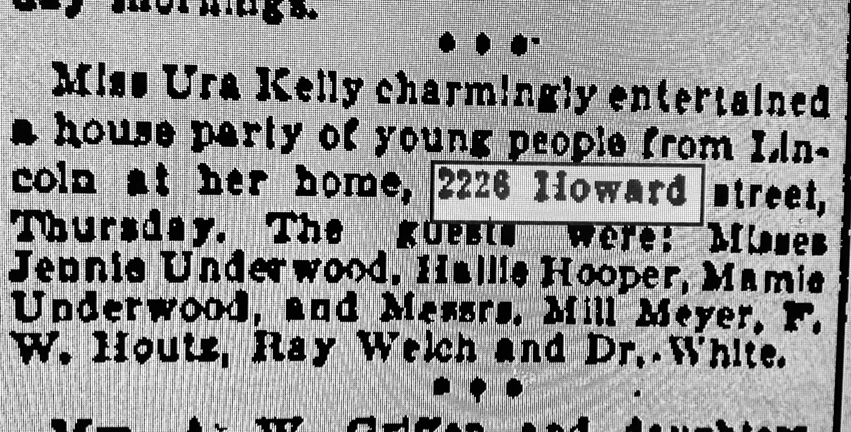
Again, this was the first thing I had found and I mistakenly believed this was teh first family to have lived at 2226 Howard. Who was young Ura Kelly?
Soon after, I discovered this….

From the Omaha World Herald Lost ads, September 27, 1895: “Lost Tuesday evening, between 19th and 24th, on Dodge, or between Dodge and Harney on 24th, a cape of wide black silk ribbon, with black satin ties. Finder will be rewarded on sending same to W. R. Kelly. 2226 Howard.”
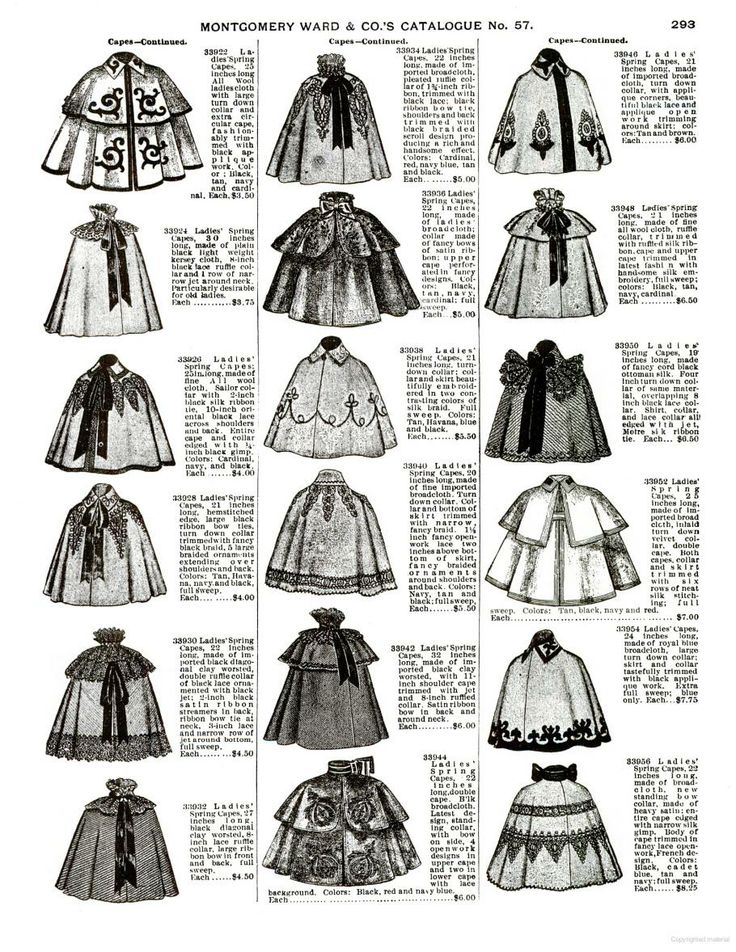
Breadcrumbs on the side trail: I just had to know what a cape looked like from 1895. Catalogue and Buyers’ Guide 1895 – Montgomery Ward. This cape sounded quite glorious to me. Miss Cassette has always loved a good cape. Although I prefer the grey Persian lambswool variety, I love these illustrated satin ribbons and embellishments.
I began to backtrack by looking in the Omaha City Directory but unfortunately, as you may remember from past mysteries, 1912 is the first year the Omaha City Directory began incorporating street address listings. Knowing the surname Kelly, I went through the city directory with fervor. According the Omaha World Herald article of January 21, 1888, William R. Kelly of Lincoln, was the long time trial attorney for Union Pacific Railroad to the state courts outside of Douglas County. Soon after he succeeded John M. Thurston as the UP assistant attorney for Nebraska when Thurston stepped into Poppleton’s position.
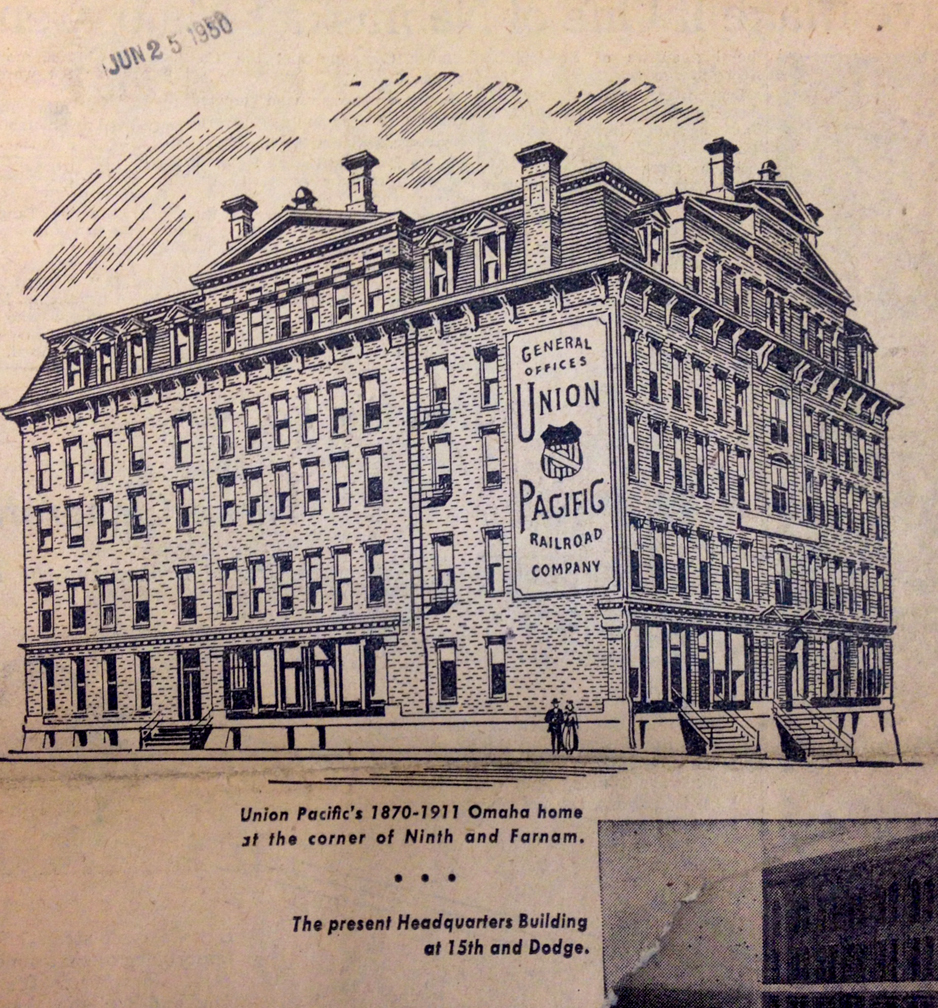
Union Pacific Railroad illustration of 1870-1911. “Omaha home of UP at corner of Ninth and Farnam.” Later headquarters moved to 15th and Dodge. Thank you to the W. Dale Clark Downtown Library for letting me peruse their file of news clipping, where I found this.
I knew I was dealing with A Real Someone when James Woodruff Savage and John Thomas Bell referred to William Kelly as “The physical heavy weight of the Omaha bar” in their book History of the City of Omaha, Nebraska. The Kelly family would continue to live in Lincoln, until about 1894 when Mr. Kelly lived solo in Omaha hotels for a number of years. I could not pin the Kelly name to the 2226 address until 1896. This would be roughly one year before Jessie Barton Rollins married George Christiancy. The Kelly family would be reunited at 2226 Howard, but according to the Register of Deeds, William Kelly was not the true owner. I believe the Kellys must have been renting from Jessie Barton Rollins. Little did I know this would become a complicated pattern of double-duty tracking with the Shingle Style mansion at 2226 Howard.
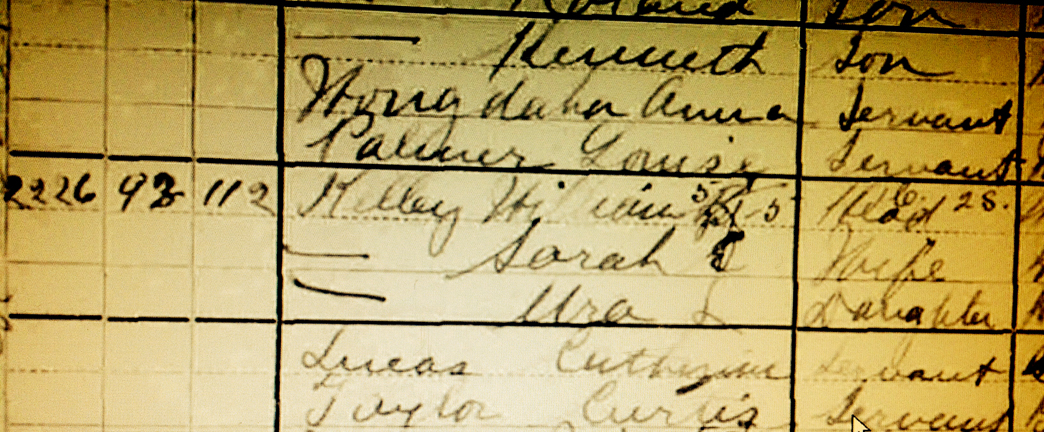
From the 1900 U. S. Census (courtesy of familysearch.org), I gained more tips. Kelley would be spelled with “ey” or “y” off and on throughout the hunt. In 1900 William Kelley was 51, born in Ohio. Wife Sarah E. Kelley was 50, also from Ohio. Ura L. Kelley, daughter was 25 years. Catherine Lucas, servant, was 30. Curtis Taylor, servant, was 25. Did I mention that in 1897, William R. Kelly and Charles Offutt were pallbearers at a mutual friend’s funeral? I do hope you remember Charles from Bertha Yost Offutt story. Check it out, if you haven’t already. Bertha Yost Offutt and the Mysterious Gold Coast Mansion Further proof that in time, all of these Omaha mystery characters will be connected.
1901 Sanborn Map
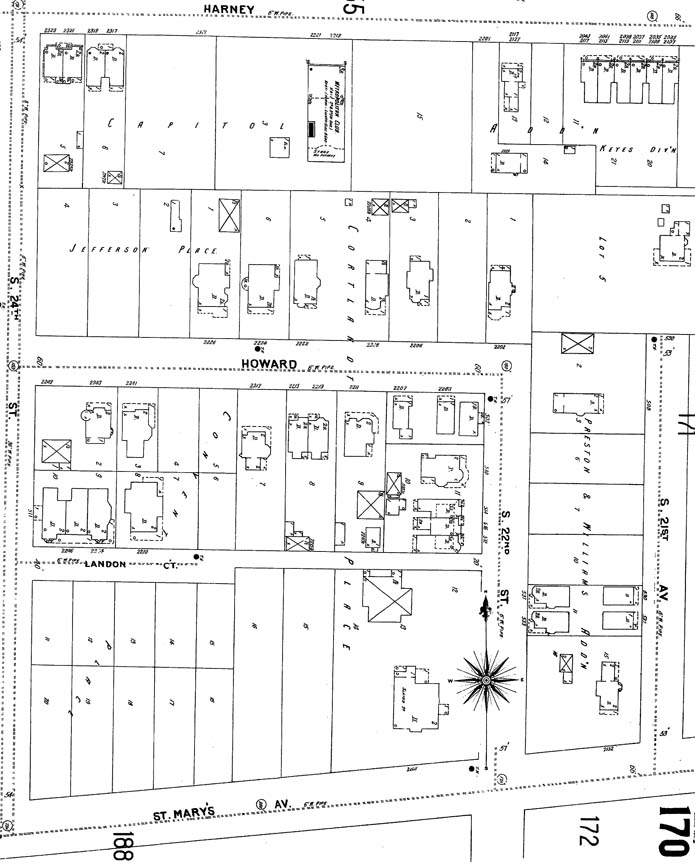
Thanks to Trina Westman of the Omaha City Planning Department for providing me with this map. By 1901 the Sanborn Map depicts 2226 correctly labeled on Lot 1. There is also the addition of a large garage, which was not present in the 1890 Sanborn. There is a large porch addition running the length of the front of the home that likewise was not present in the previous map. The properties to the west are now labeled as lots 2, 3 and 4. The house directly to the east, 2224 Howard, is now Lot 6.
Reported in the Reconnaissance Survey of Downtown and Columbus Park Omaha, the homes on the short Howard Street block were all mansions and large, single family homes. The 1900 census showed a listing of neighbors. 2222 Howard housed William Wyman, wife Mabel and sons Tucker and Clifford. 2224 Howard was home to George Patterson, wife Ella and sons Roland and Kenneth. 2243 Howard: William Bennett and Louise. 2241 Howard: Stephen Bangs and Jane.
June 4, 1902 the Omaha Bee announced the repaving and curbing of Howard Street from east line of 22nd Street to 24th street, amounting to the sum of $4,220.97, including the cost of two private driveways.” Lot 1, our 2226 Howard focus, cost $211.31.
Pieces of Vague Evidence
Sarah Kelly’s sister, visiting from Chicago, would get married at 2226 Howard in 1901. The Kellys would run many ads looking for servants over the years until the Omaha City Directory of 1906 revealed that the family had moved on. I could not even find them living in Omaha nor is the family buried here, from what I could find. Who moved into 2226 Howard and what became of it? Mind you, the Omaha City Directory did not start listing addresses until 1912 so I had nothing to go on. I did know for certain that Jessie Barton Christiancy continued to own the property. I would continue to find ads looking for servants for a “family of eight.” One would guess that 2226 Howard continued to serve her comfortable halls to the well to do. By October 7, 1908 the occupants were “Selling a bookcase, two feather beds, a good sewing machine.”
The Mansion Becomes a Rooming House
“Jessie B. Christiancy and husband” sold to John J. McClellan on May 13, 1910. From then on I located numerous ads for “Furnished rooms for rent 2226 Howard” and “Beautiful rooms for rent, with or without board: shade. 2226 Howard.” I imagined shade being a selling point in those days. I was sad…. and why was that? I remember being disappointed even as a little girl to discover a mansion was no longer a mansion but had been converted to apartments. As an adult, of course, I am just happy that these large rambling homes haven’t been torn down and can recognize the tremendous expense of keeping up a glorious home. But still…the fantasy tends to diminish when one spies a rickety fire escape winding out of Queen Anne tower or sees a large metal post office box affixed to a once impressive entryway, multiple apartment numbers stenciled to the outside. I know you understand this sad state of affairs.
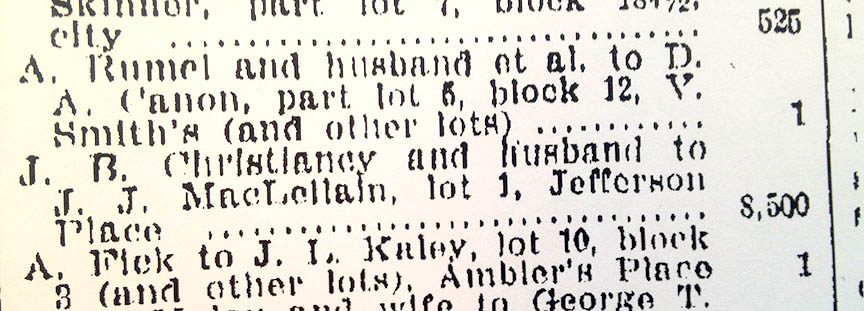
May 14, 1910 J. B. Christiancy and husband sold to J. J. MacLellain
I will admit to you, dear reader, that I was unable to dig up anything on John J. McClellan. I found a John J. who had been in the Civil War and a few others from here and there but nothing tying a John J. McClellan to Omaha. There was always a chance his name was spelled wrong on the deed. Later I found the announcement of the sale in the OWH where his name was spelled J. J. MacLellain, which produced even more insufficient results. Seeing as he had used the home as a money making venture in the form of rooming house, McClellan might have lived in another state altogether. The possibilities of which made me even sadder.
The Ethel Mick File, Horses, a Hospital and Frat Boys
Almost two years later in August of 1912, McClellan sold to Ethel Mick. According to the U.S. Census of 1920, Ethel Wead Mick was then 36 years of age and married to Captain William Henry Mick, age 41. This union brought two daughters, Ethel (14) and Ruth (11). I could not find evidence that the Micks lived at 2226 Howard. It is my belief that they too made a living from the rooming house concept.

May 12, 1912. The Omaha Daily News. This phrasing leads one to believe that the Micks did indeed live in the large, gorgeous home.
Ethel Wead was a student at Omaha Medical College in 1901, later Creighton Medical College and subsequently became a physician. It is said that she met William Henry Mick while in medical school; he, too, was a doctor. Ethel Wead Mick was the sister of well known F. D. Wead from Omaha and belonged to the E. D. Wead family, early settlers of Omaha. A sister named Pearl Wead existed. Adjacent to the Douglas County Courthouse in Omaha, on 18th Street, stood the Wead Building, which has since been demolished. The establishment accommodated the F. D. Wead Real Estate enterprise. Previously, in the 1800s, it was referred to as the F. D. Wead, Hutchinson & Wead Real Estate. I’ve got to think this was the family business or certainly the brother’s.
**Addendum of June 1, 2025** I have since learned that this was Ethel Theresa Wead Mick (March 9, 1881 – February 21, 1957), the creator of the Masonic girls’ organization The International Order of Job’s Daughters, currently referred to as Job’s Daughters International, and held the position of its inaugural Supreme Guardian.
Years later, the younger Ethel Mick would make national news for developing a “Junior Red Cross” after working as a youth fund raiser during a membership drive. Her brilliant little big idea spread across the country and was developed into a form of volunteerism for children during World War I.
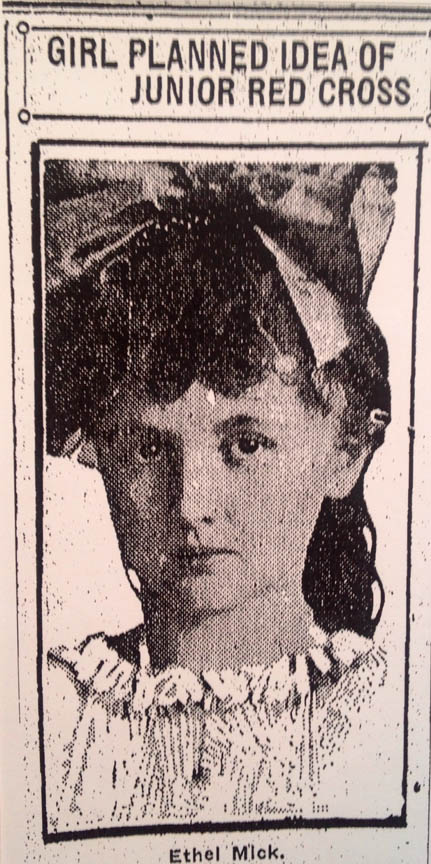
Here is Little Ethel Mick in 1917. One year later there was another article in the paper calling her “The Little Mother” of the Junior Red Cross society because of her hard work in the national organization. She was on the talk circuit, inspiring other school children through her speeches to be active in their communities. Her father, Captain William H. Mick, was stationed in Europe, where he was placed in charge of the X-ray department of a U. S. Army Evacuation Hospital.
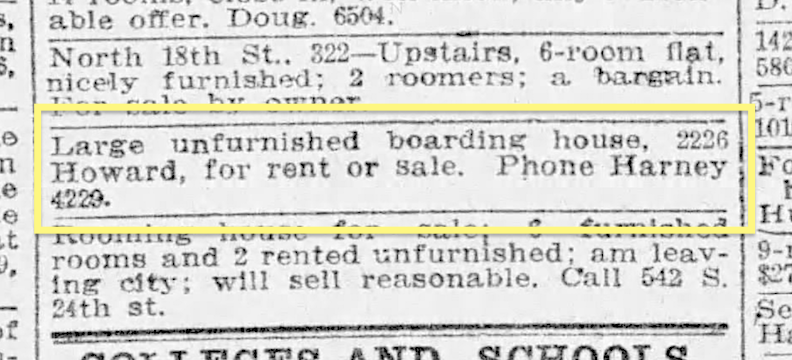
November of 1912, Omaha World-Herald. It appears that at year’s end, the Mick family was trying to sell the house and moving on. The printed word offers limited insights, although it seems the Micks had intended to transform the expansive boarding house into a residence before subsequently vacating, meanwhile retaining ownership. This I gathered from the U. S. Census and the deed to the home.
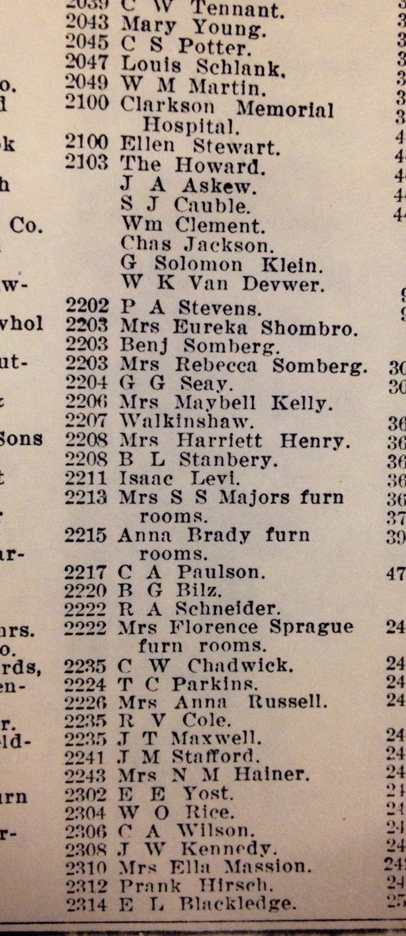
Omaha City Directory list of 1912 shows that Mrs. Anna Russell was running the boarding house of 2226 Howard Street. At this time 2100 Howard had a new business: The Bishop Clarkson Memorial Hospital. The Howard Apartments were on the block but none of the other apartment buildings that now inhabit Howard Street were there yet. Meanwhile some of the mansions were being converted to rooming houses but still quite a few single-family homes were intact on the block. Did anyone else catch the name J. T. Maxwell at 2235 Howard Street? YES, that is our favorite James Taliaferro Maxwell of Log Cabin fame. Check out Mysteries of Omaha: The Log Cabin and the Jones Street Bridge if you are not up to speed on this. I love when this happens! Omaha is such a big-small town.
2213 Howard Street was now Mrs. S. S. Majors furnished rooms. 2215 Howard was Anna Brady furnished rooms. 2222 Howard was Mrs. Florence Sprague furnished rooms. From an obituary of June 2, 1927, I later learned that Anna Russell, died at age 69, back east in Pennsylvania. She was mother of William Russell, local manager of the Omaha Ford Plant. She ran a couple of rooming houses while in Omaha.
There were several odd events, which coalesced in some fashion in 1913. I say in some fashion because I am not sure of the fine details in this perplexing mix. There were many ads selling horses out of 2226 Howard. One advertisement offered “Our entire outfit of horse, consisting of 13 head of horses and mares. Myers Construction Company. rear, 2226 Howard.” That would explain that large additional structure in the back of the house seen in the Sanborn maps. Later there was an ad stating, “For rent barn—suitable for ten cars.” Did this mean that the Myers Construction Company was operating out 2226 Howard or was an owner living in the rooming house?
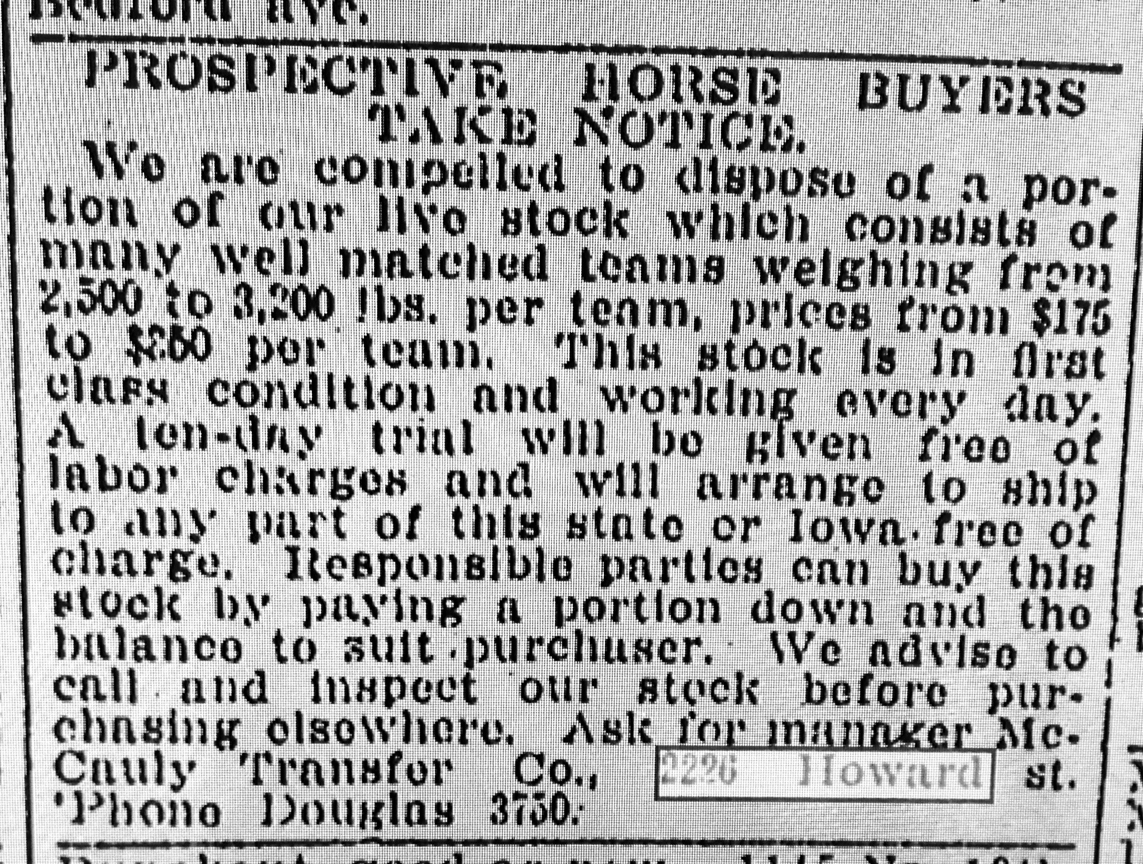
Another horse ad this time with manager McCauly Transfer Co.
The Micks remained the owners of 2226 Howard, according to the deed but the Omaha City Directory now listed the property as the “Emoh Club.” This conundrum caused some Detective Road Blockages, as I could not find any other mention of this club name from my usual sources. I began to find evidence that the Emoh Club was a national men’s organization from the late 1800s rather than a local drinking club.
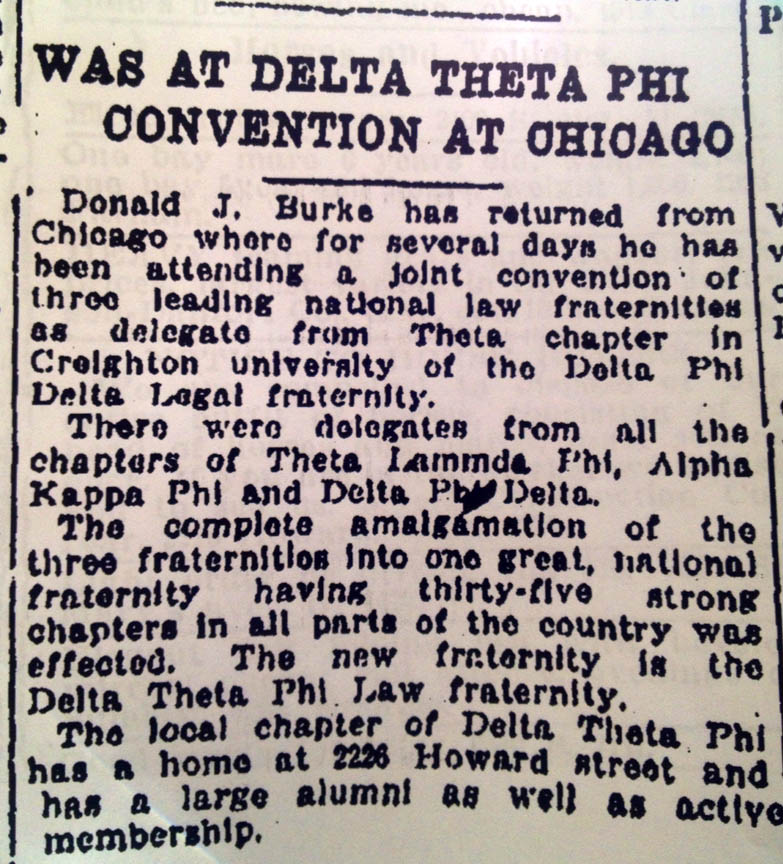
I finally chanced on an article from 1913 about Donald Burke, a Creighton University fraternity member having returned from a national law fraternities meeting in Chicago. This meeting joined three law fraternities into one thirty-five-chapter entity. The local chapter of Delta Theta Phi Law fraternity would be housed at 2226 Howard Street.
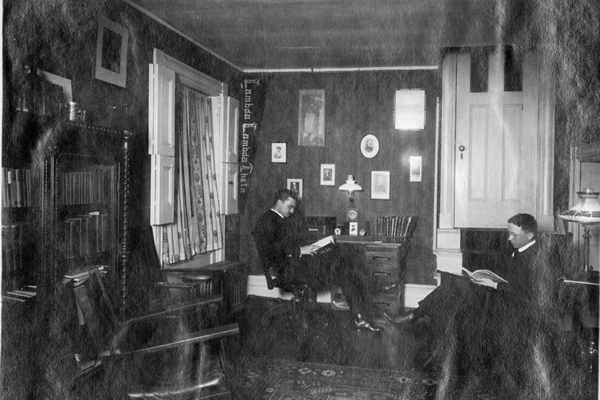
Fraternity room from 1913, just to give a feel for the time. I searched so hard for a Creighton Delta Theta Phi Law fraternity photo but turned up nothing. I know someone out there must have one.
Oh my stars. Can you imagine what the neighbors thought? Had there been two different clubs or were they one in the same? Maybe 1913 fellowship was not as raucous in those days but we can envision how that many young men living in a huge house might have worked out. During this time period American cities found quite a few of their mansions being rented out or bought by fraternities. Due to changes in the economy and a shift in styles, the well to do began to move into smaller homes that were easier to maintain. Our city still has a number of these sprawling frat houses sprinkled about town.
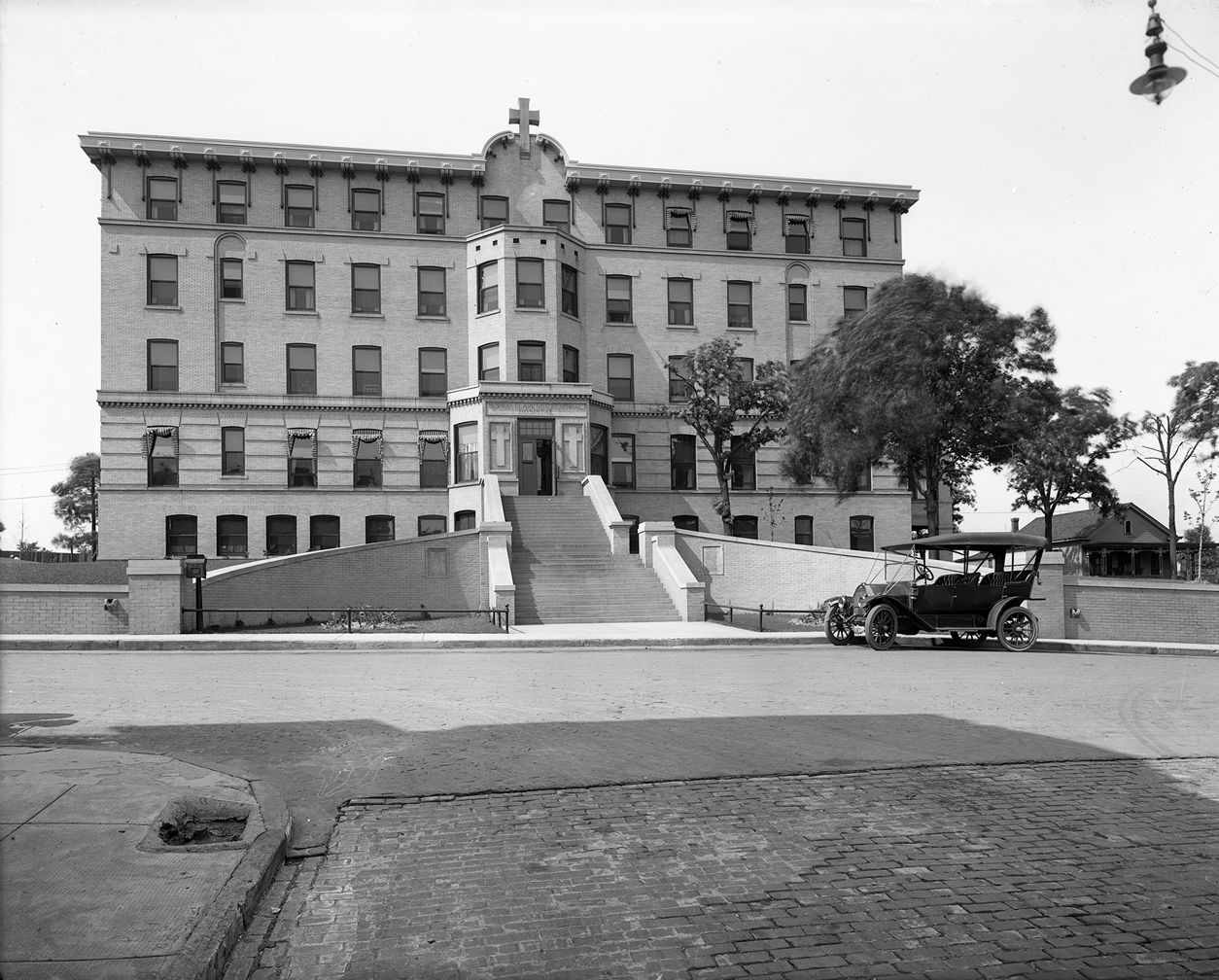
June 12, 1913. The exterior of Clarkson Hospital at 2100 Howard Street down the street. Approximately where the NRG Energy Center building now stands was the impressive Bishop Clarkson Memorial Hospital. Previous to this Howard Street move, the hospital was originally at 1716 Dodge Street. The 2100 Howard Street location was later razed around 1966. Notice the stable type barn in the background. (Photo courtesy of the Bostwick-Frohardt/KM3TV Photography Collection at The Durham Museum Photo Archive).
The Torrisons and a Series of Furnished Rooms
For a little perspective into our Omaha characters’ lives, World War I had started in 1914. Adelina Patti, a well liked Spanish opera singer in America, gave her last public performance for a Red Cross concert at London’s Royal Albert Hall.
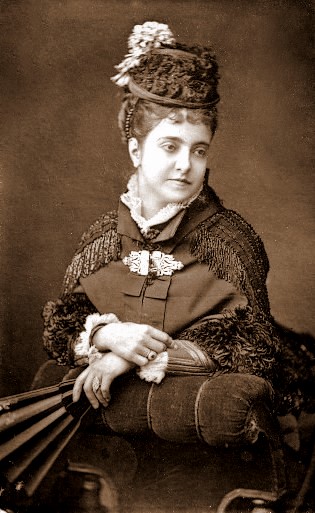
The Great Adelina Patti
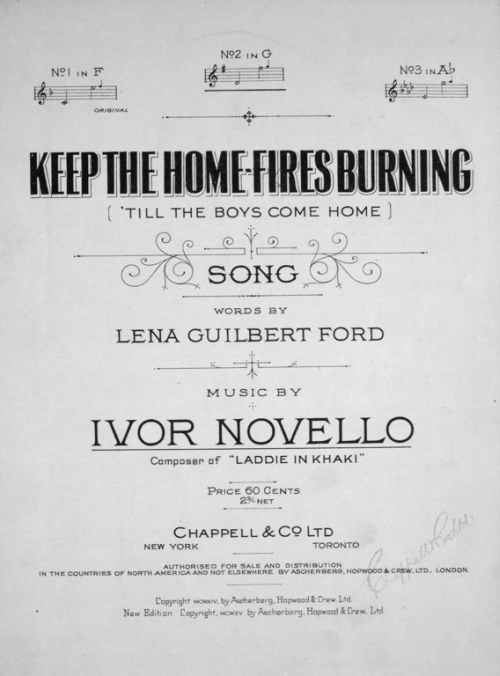
Songs such as “Keep the Home Fires Burning (‘til the Boys Come Home)” and “It’s a Long Way to Tipperary” would become the new popular music of the time as America and its allies bound together in somber, patriotic themes.
Months after the war began, “J. C. Torrison and wife” bought 2226 Howard on October 13, 1914. The 1910 U.S. census shows Mattie Torrison (43) was born in Norway and was married to Terges C. Torrison (44) of Wisconsin. Terges’ parents had each emigrated from Norway. The couple had three children Oscar (15), Mildred (10) and Eldred (6). Terges was listed as a real estate agent by profession in 1910. The Torrison family rented 2226 Howard out as a means of income. I could find no record of them living in the house. All three censuses showed them living around 25th and 28th streets.
The Omaha City Directory of 1914 and 1915 listed George Brenner and T. J. Delaney as tenants-apartment managers. They were actively selling “Second-hand lumber, all kinds of bldg materials” throughout 1914. Also from May 19, 1915: “Moved to city, forced to sell my big team of mares, 7 and 8 years old weight, 2,7000 lbs. Also wagon. 2226 Howard.” One of the men was running some kind of club at the house or was it at another location? Was the Zenda Club another fraternity? I couldn’t track any additional information about the club from my usual sources other than these ads. From Nov 4, 1915: “Wanted a good second girl at the Zenda Club. 2226 Howard.” From Nov 24, 1915: “Good German or Bohemian girl to work at the Zenda Club.” Interesting preference.
In 1916 George Brenner had moved to Irvington, NE and Thomas J. Delaney moved to Syracuse, NY. “Mrs. Florence Sprague Furnished Rooms” had hung up her shingle on the Shingle Style house. Her husband, Clark Sprague, had died very recently and she was now a widow. 2226 Howard was then listed under “C. A. Flynn Furnished Rooms” by 1918. One of my favorite worded ads from September of 1918: “On account of the draft, we have several excellent vacancies for room and board per week.” I just loved when people used to say “On account of…”in old movies. Charles A. Flynn and wife, Florence, began offering home cooked meals in the 1920s in addition to rooming. “Home cooking served family style 3 meals a day, per week $6 and 2 meals $5. Rooms $3 per week.” Later it would become the Mrs. Florence Flynn Furnished Rooms.

In the late teens, Americans had been taught to conserve food for the service members of World War I. Food was kept and donated to the military in order to feed American troops and our allies. During the teens, many Americans collectively lived by “Meatless Mondays” or “Wheatless Wednesdays.” When the war was over in 1918 there was common rejoice, I’m guessing, for innumerable reasons, one being the variety of food.

Fantastic Campbell’s Soup ad from 1923. Although Prohibition had entered the picture in 1920, a family could hope to have a Sunday dinner of baked ham with less concern of conservation and possibly a sip of illegal alcohol (although I’ve read this was not all that forbidden in one’s home.) People also began to eat at restaurants and clubs again with more of ease.
1925 brought Mrs. Anna Piller Furnished Rooms to 2226 Howard. Anna managed the renting and cooking. Her son Robert, was a salesman. Daughter Sophia Piller was student.
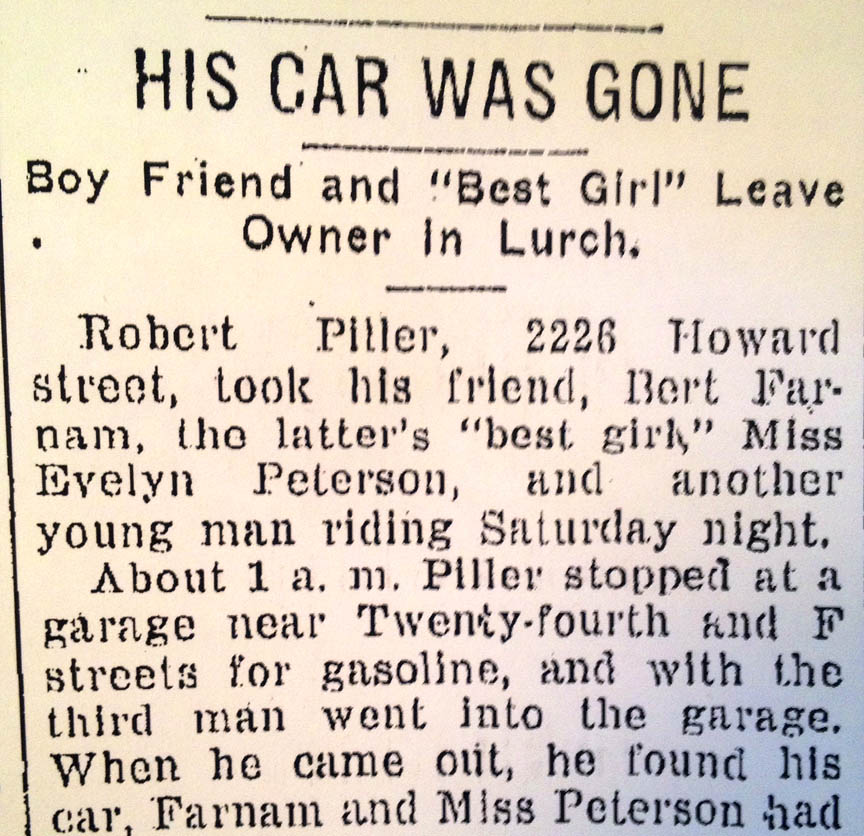
Omaha World Herald article of August 30, 1927.So the story goes, Anna’s son, Robert took his girlfriend, Miss Evelyn Peterson and two fellas out on a joy ride in his car. Robert went in for gas with one friend at a 24th and F Street garage around 1 am (can you imagine 1 am in 1927?!) and when he returned his girlfriend, guy friend and car were gone. Robert reported the incident to the police. His car, his gal and his pal were later found over at Miss Peterson’s home. A follow up article quoted Robert saying, “I laughed it off. I’m going to forget it.” He apparently had “Been wrong on the ‘best girl’ angle.”
All the while 2226 was owned by the Torrisons. In July of 1927, the home was transferred from Terges’s name to his wife’s name, Mattie Torrison. I believe Terges must have died because there was no mention of him again in census records. An Omaha World Herald real estate transfer from November 1927 shows the home was again transferred into another Torrison name—this time from mother Mattie Torrison to daughter Mildred C. Torrison Warrington.
The Warringtons
In January of 1929 my Shingle Style obsession went into W. W. Warrington’s name according to Register of Deeds Office. An Omaha World Herald article from June of 1927 announced that in a whirlwind, W. W. Warrington, Jr. had married Miss Mildred Torrison. “This marriage came as a surprise to relative and friends alike.” By the pattern established with this house, I would surmise that Mother Mattie gave the newlyweds the house as a wedding gift.
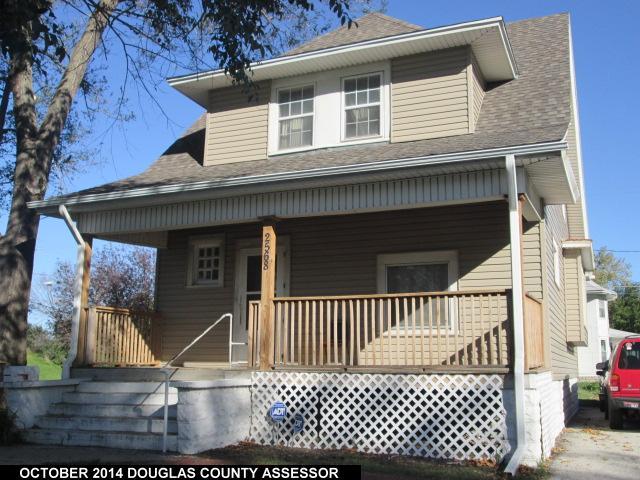
2568 Ames Avenue. I located the 1930 U. S. Census. At that time William W. Warrington (29) was married to Mildred Torrison Warrington (29) and mother-in-law, Mattie Torrison, (63) lived with the couple at this attractive house at 2568 Ames Avenue, a corner lot. According to the Douglas County assessor site, this home was built in 1910—although sometimes the years can be off. If this detail is correct, the Warrington-Torrison family did, indeed, live in this very house.
The March of the Apartments
By the late 1920s all of the apartment buildings, four plexes and duplexes on Howard Street and Dewey Avenue had been built. The Howard Street Apartment District had arrived but it was not yet called that. It must have felt like such a different neighborhood compared to when it was an enclave of mansions. Here is a listing of what once stood on that block. As I have mentioned, I plan to write another article revealing more of the history of these incredible apartment buildings. For now here are some photos of the historic apartments still standing that I snapped on a nice spring day last year.
2103 Howard: the Packard (earlier the Howard) Apartments: Razed
2205-07 Howard: the Hawthorne Apartments: Razed
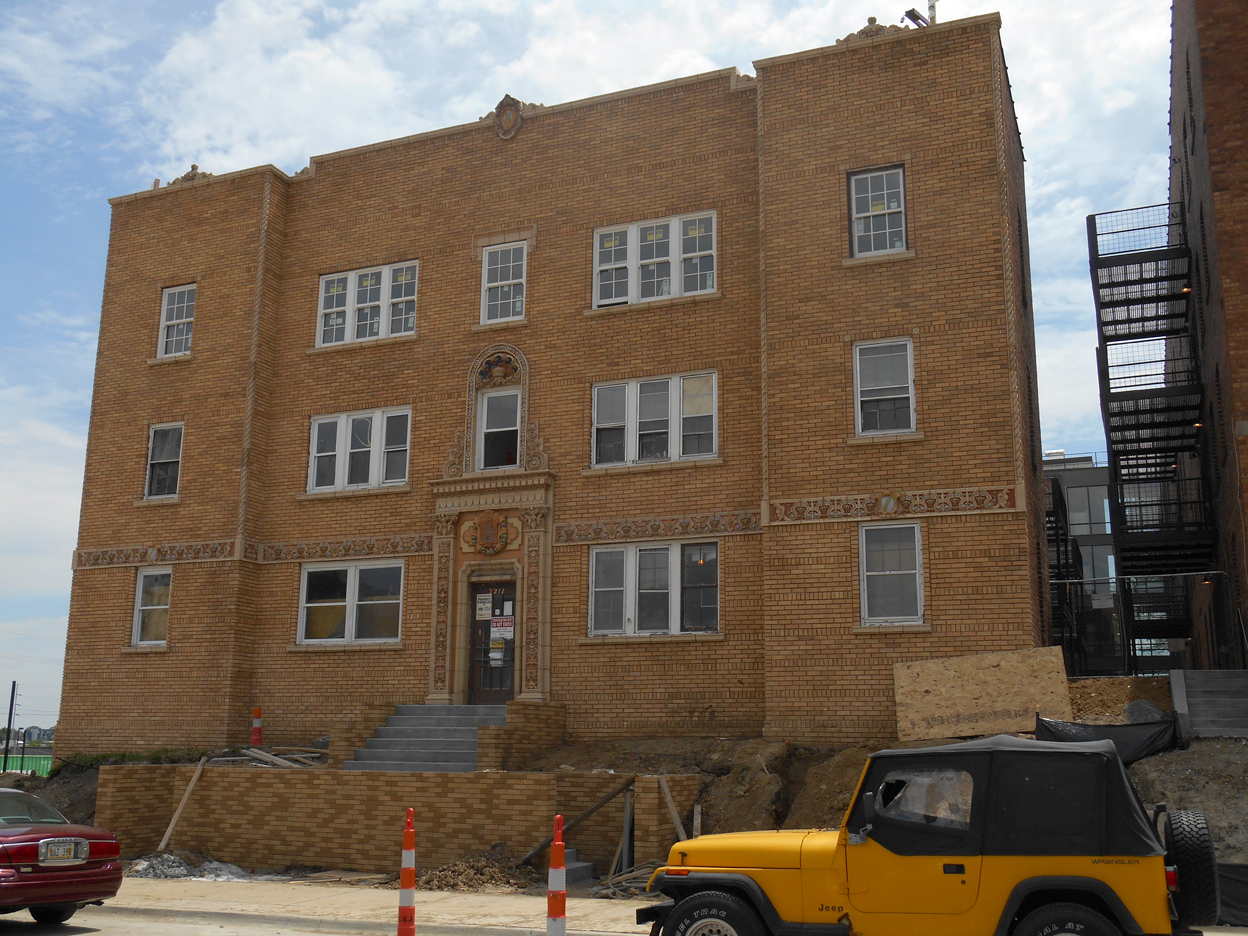
2211 Forrest Apartments (FAVORITE: also called Forrest Glen Apartments. Said to have been built in 1927. Designed by Frederick A. Henninger, my secret architect love, as you know.)

2215 Longfellow Apartments (1922)
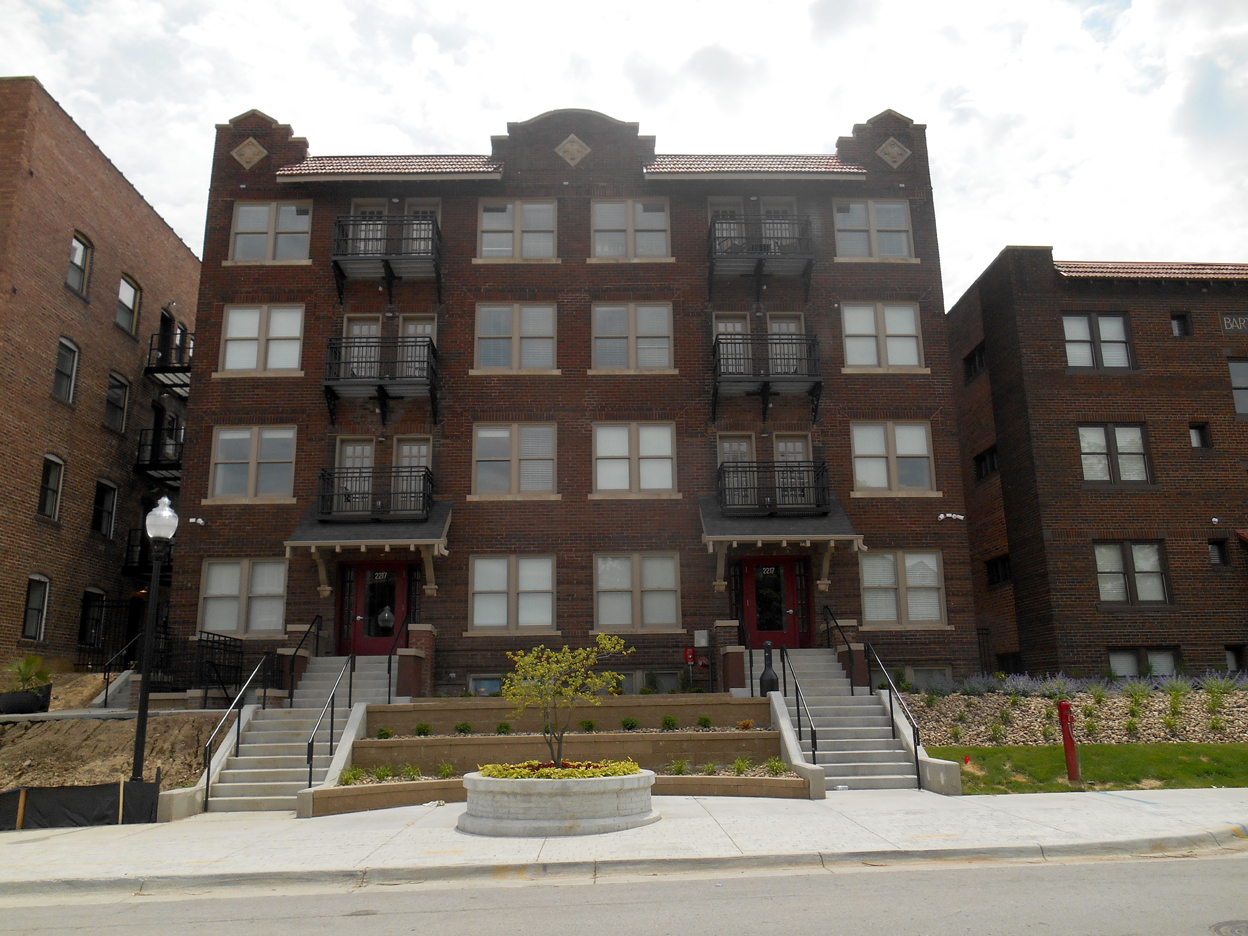
2217-19 Bosworth Apartments (1913)
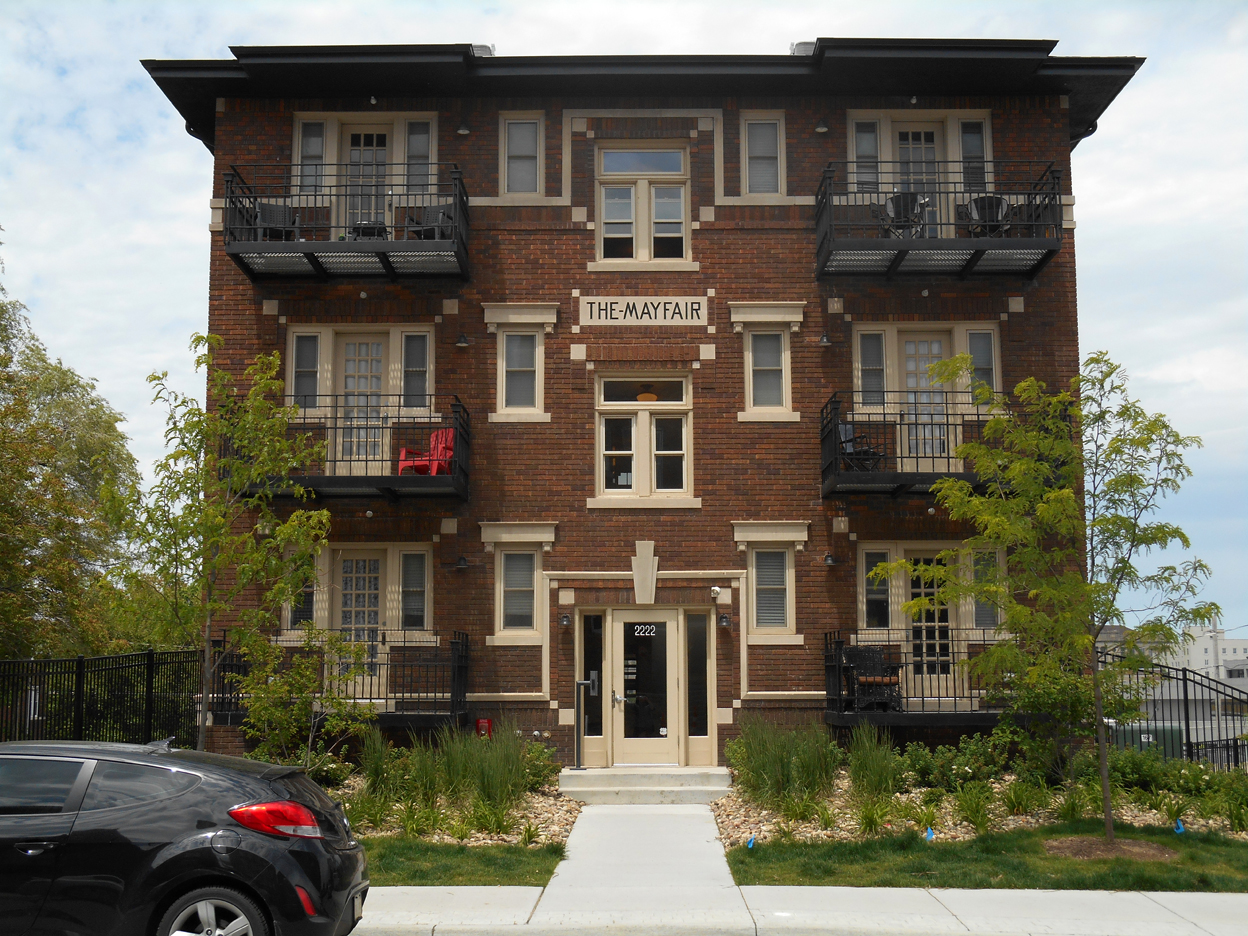
2222 Mayfair Apartments (1915 or 1916)

2227 Bartlett Apartments (supposedly built in 1929)
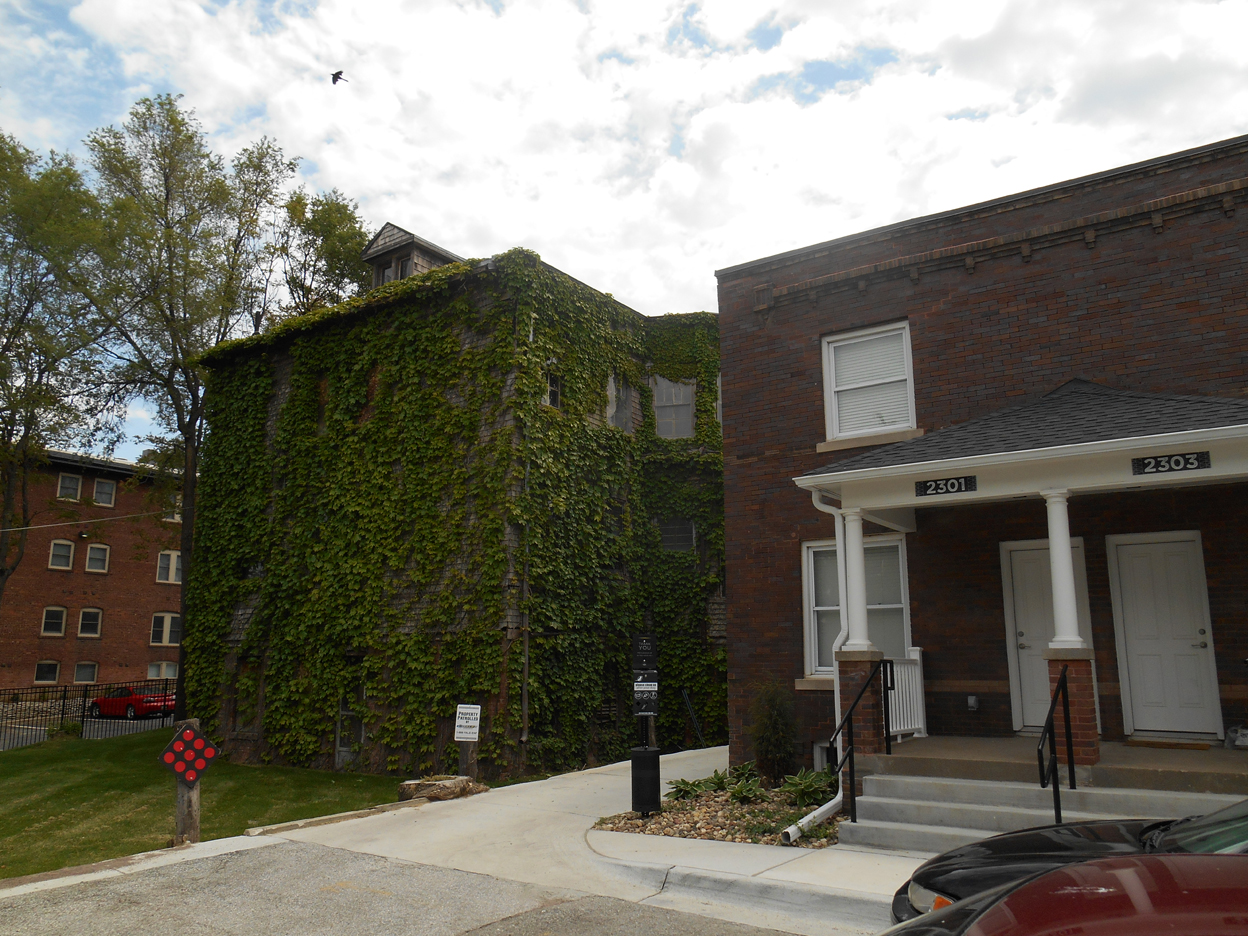
The Dewey Avenue row houses-duplexes, down a side job actually behind 2226 Howard. You can see how very close these buildings are to our Shingle Style mansion. 2301-2303 Dewey Avenue.
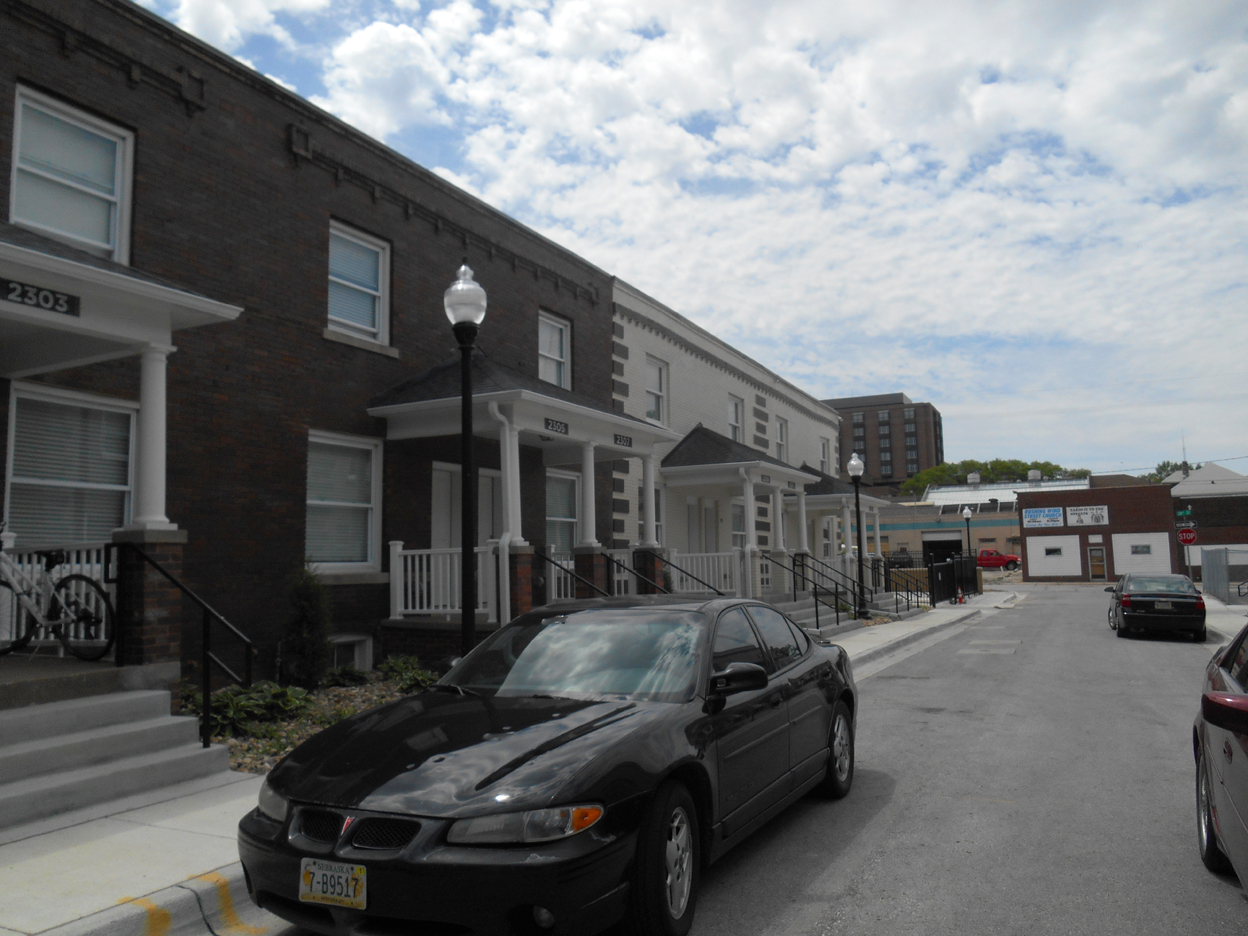
The continued duplexes down Dewey Avenue on the south side. The best. A true movie set.
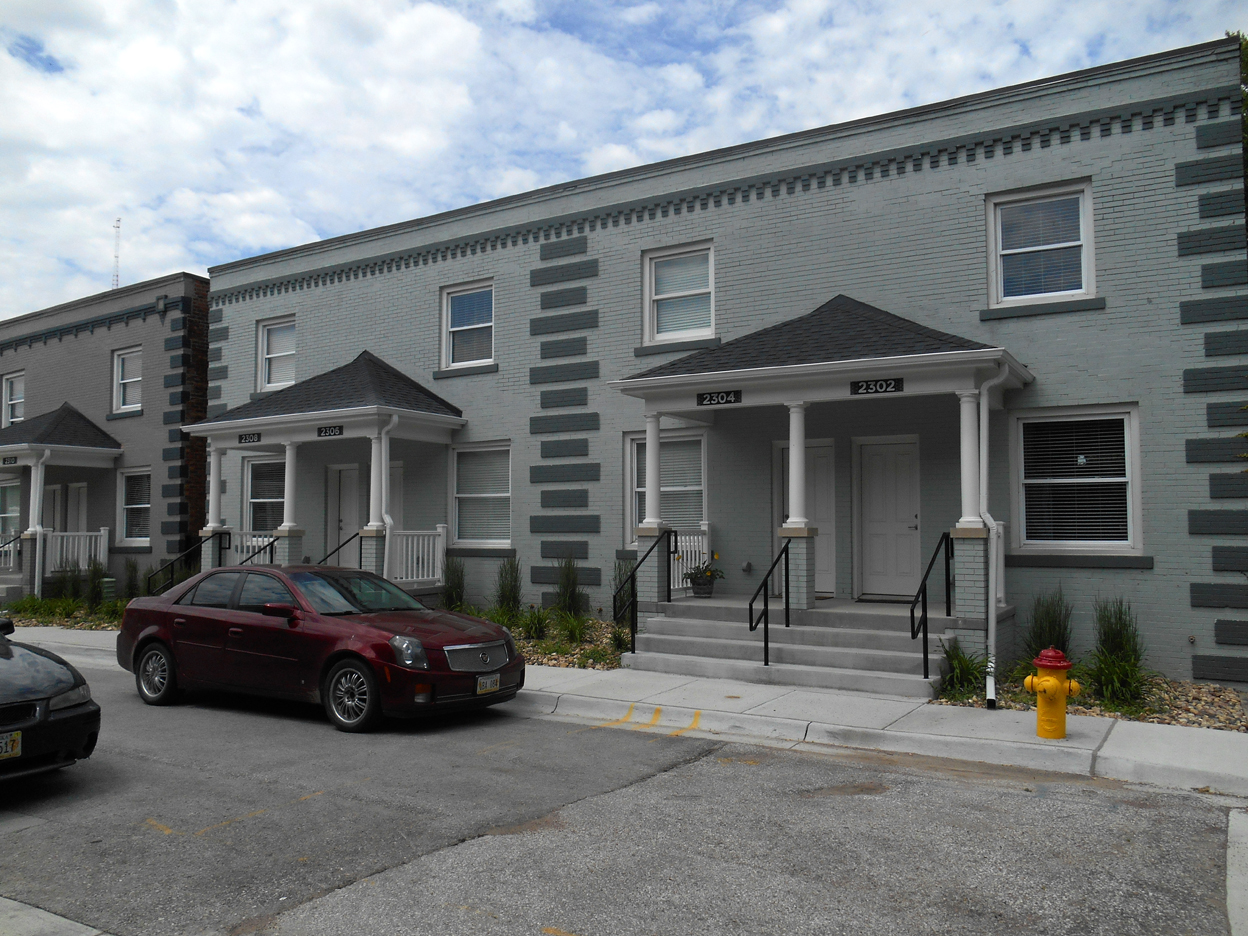
The north side of Dewey Avenue. There were also (and continue to be, thankfully) duplexes and fourplexes just to the west of 2226 Howard but I am not including their photos here as this is getting a bit exhaustive. This is just a taste. Yes, you must go look for yourself or wait for my followup on the Howard Street Apartment District.
The Bryon G. Burbank File
The corresponding newspaper articles and Register of Deeds Office list revealed Byron G. Burbank took ownership of 2226 Howard on November 4, 1929. I turned up the Burbank name earlier in my investigation when I had noted him buying up multiple lots in Shinn’s Addition back in 1897. Burbank bought more in the Park Place Addition in 1908. It turns out Byron Burbank was a well-known Omaha attorney. And he had a son named, Forrest Burbank, which immediately caught my attention–a name befitting of celebrity or poshness on some level. It was also the name of my favorite apartment building on Howard Street. Coincidence? Later I would track down the announcement of his acceptance to Harvard Law School.
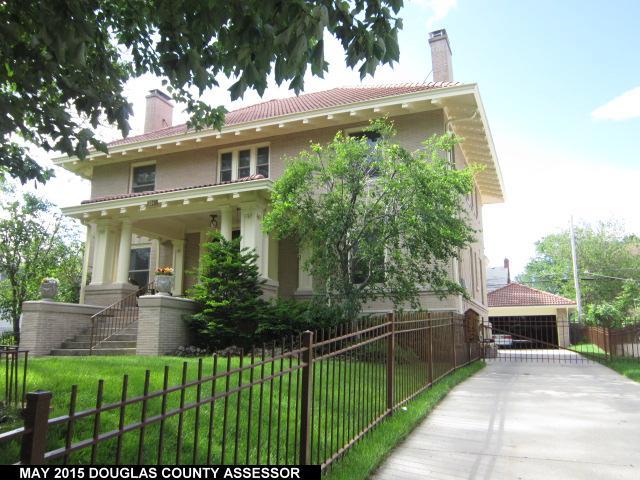
3845 California. Photo from the Douglas County Assessor site. This is my idea of a Gorgeous House. Holysmokes. The 1930 U.S. Census confirmed Byron G. Burbank (69) was married to Jane B. Burbank (46), and their son Forrest (20) also lived in the home. Byron was listed as an “Apartment Owner” by profession. The family lived in this fabulous home at 3845 California. The Douglas County assessor site said this property was built in 1918. Later I would find Mr. Burbank was a larger property owner than I had imagined, owning several large apartment structures. As it turns out, Burbank had the Longfellow Apartments at 2215 Howard and the Forrest Apartments at 2211 Howard built. The Forrest Apartments were no doubt named for his only son.
A Curious List of 1930s Grocers
As was the pattern of ownership, the Burbank family did not actually live at 2226 Howard. They continued to rent it out, possibly with an apartment or rooming house manager handling the day-to-day affairs. In following the Omaha City Directory listings I began to notice a series of managers, changing over almost yearly, who were all notated as being “grocers.” I even joked, early on to Mr. Cassette, that it was as if 2226 Howard was a rehab for grocers. I could not fathom what that meant until much later…
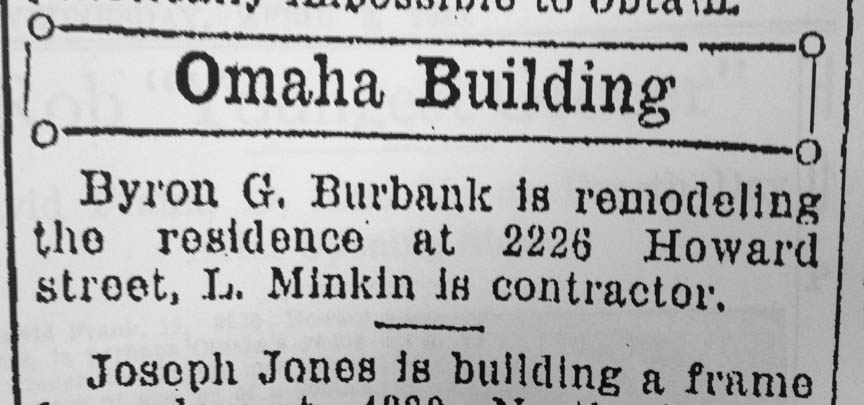
Byron G. Burbank is remodeling. This short mention from the OWH in March of 1930 was yet another clue. You might recognize the Minkin name as the building of the curious grocery-liquor store from Mysteries of Omaha: 2561 Douglas Street. I would come to believe the work Burbank had Minkin complete actually turned the porch of 2226 Howard into a small, neighborhood grocery store.
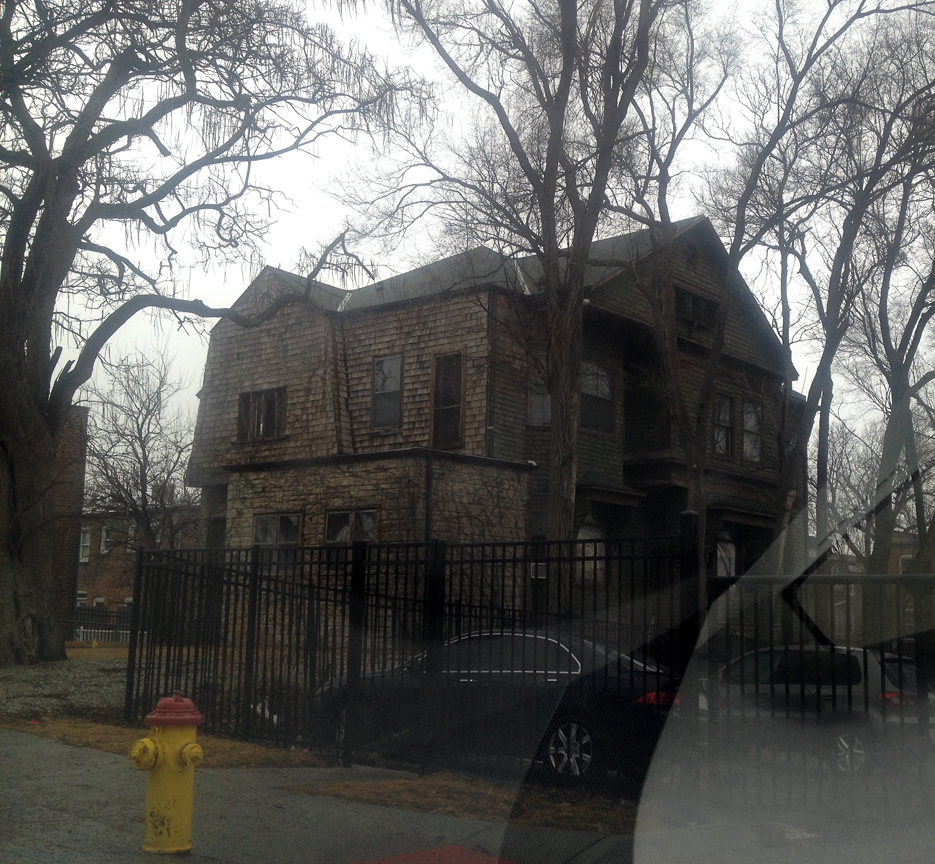
Current photo from 2017, show how this box-like addition to the home, possibly could have been a little neighborhood grocery store. It also explained my early questions about the stone facade on that portion of the house. This photo also shows that 2224 Howard is now, unfortunately, a fenced in lot.
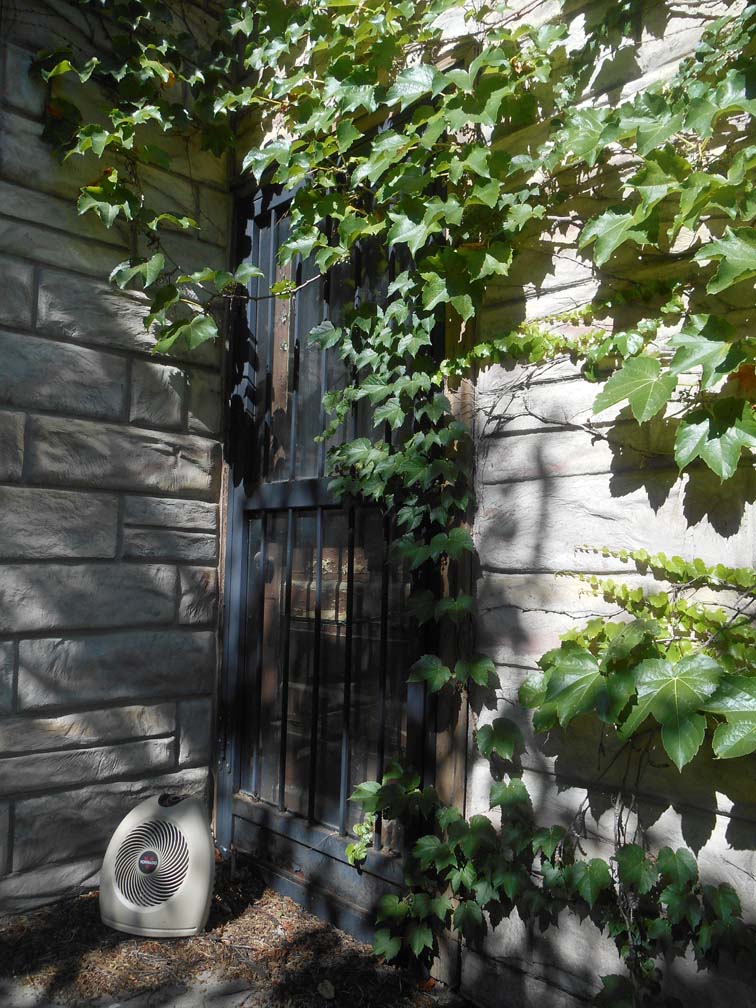
Was this possibly the door to the neighborhood grocery story? It is found to the right of the proper front door.
During this time period the neighborhood grocery store was very popular. Some Americans had small Mom and Pops in their homes, an extension of the European history of a shopkeep living above or behind his store. This was also a way to cut down on expenses. I wrote quite a bit about this phenomenon in Brothers Lounge and the Case of the Vanishing Mom and Pop.
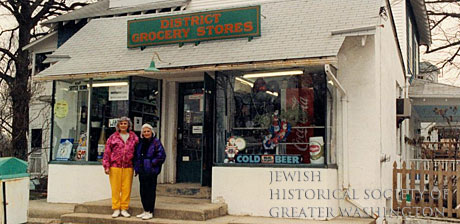
Here is an example of very tiny corner shop added to the front of a house.
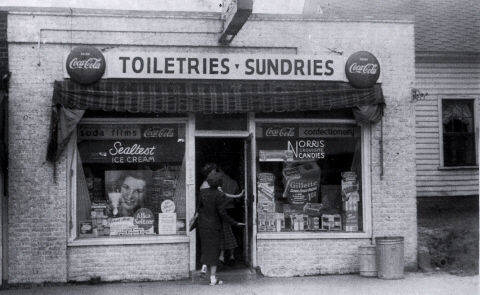
Another example of a small neighborhood store built on the front of someone’s house. When I was growing up in Benson, these house stores or neighborhood shops were not uncommon to see further in North Omaha. You could purchase candy, soda and chips from a neighborhood person, usually through a front window.
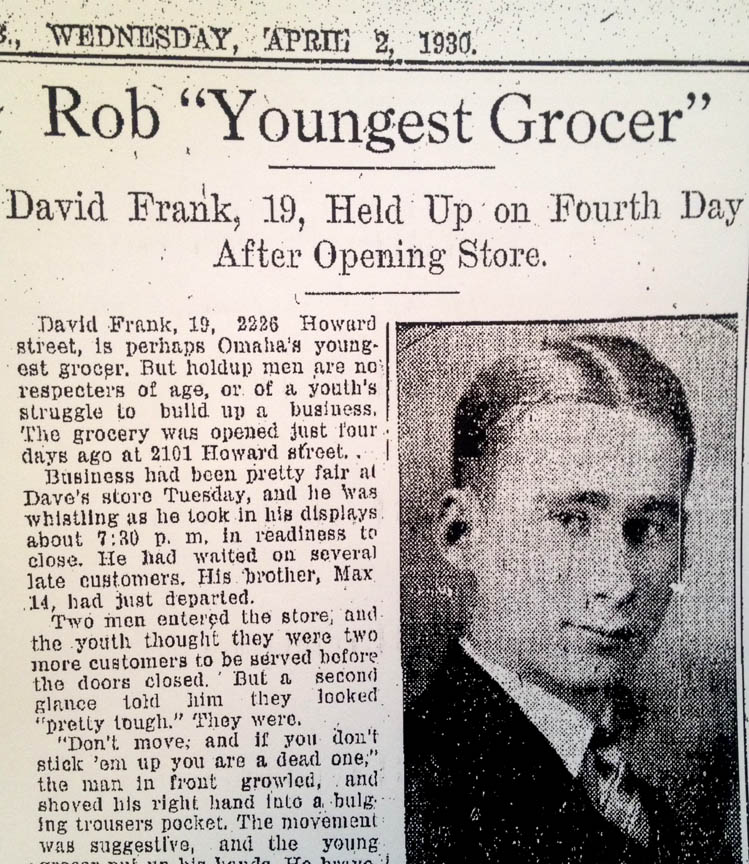
I love this article from April 2, 1930 about David Frank, yet another grocer, who curiously lived at 2226 Howard but ran another neighborhood grocery store right down the street at 2101 Howard. Apparently David was held up on his fourth day after opening his brand new grocery store. David Frank would go on to become an Omaha legend; a successful entrepreneur owning the Peter Pan Furniture store and the Dundee Theater (!) through the 70s and early 80s. Frank also raced the many thoroughbred horses he owned at Ak Sar Ben. I found the ad from 1931 where Frank was selling off his grocery store at 2101 Howard. It would later become Parrot’s Beauty Salon.
The City Directory of 1931 displayed Frank Meier, grocer and wife Sarah Meier now moving into 2226 Howard. An Omaha World Herald ad from March 1, 1931 lent a further confirmational clue: “10 room rooming house with or without small store. 2226 Howard. Inquire at 2211 Howard.” 2211 Howard is the Forrest Apartments, by the way. By 1932 John Pardoe, “grocer” and wife, Bettina were running the store and rooming house. In 1933 Charles Cavanaugh, “grocer” and wife, Flora ran 2226 Howard.
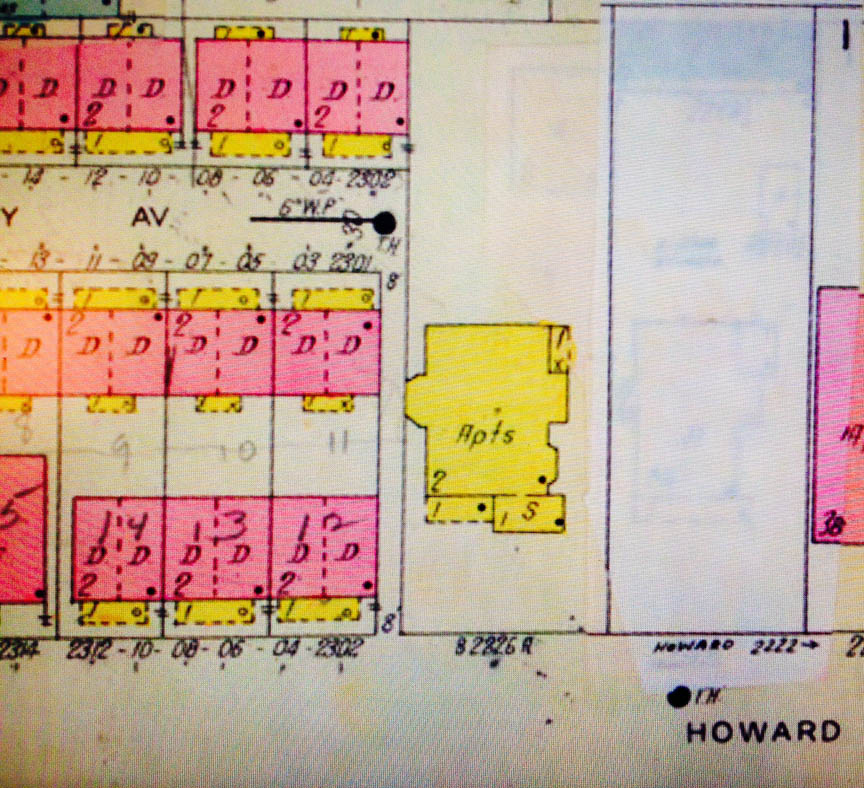
A colored Sanford Map detail, sometime post 1940s. (Thanks to Trina Westman of the Omaha Planning Department). I include it here, out of chronological order to show the coding. I would later put two and two together after viewing this map. See 2226 show as “Apts” with an “S” code for store. Note that the Sanborn map has been altered-covering the previously drafted 2224 Howard with a white paper—signifying that 2224 has been razed. Additional information gained from this map, but cropped out—three larger homes at 2208 and 2206 are now parking lots, presumably for the Clarkson Hospital.
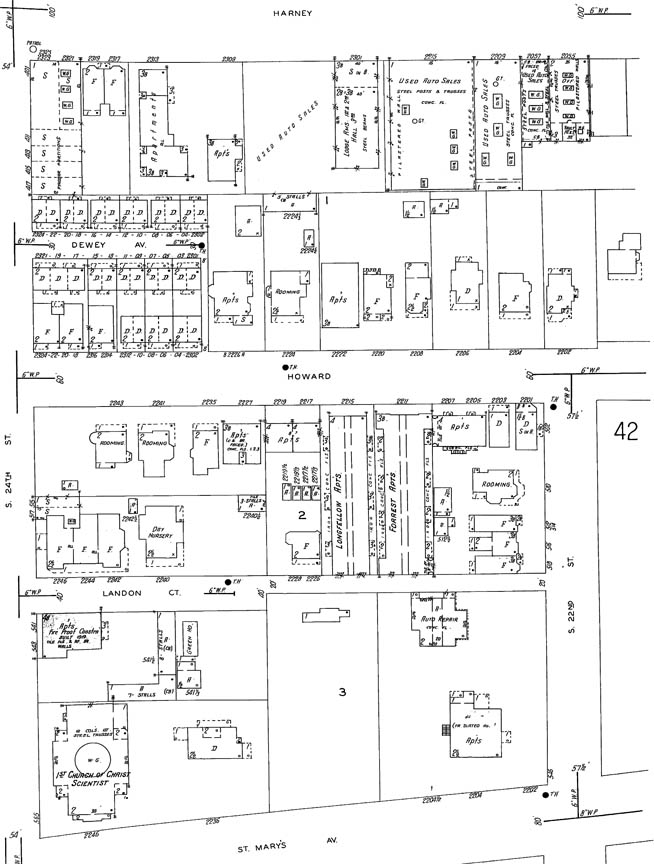
The 1934 Sanford Map shows that Howard Street finally ran all the way through to 20th Street. You can see the numerous houses still standing on the north side of Howard, east of 2226. (2224 would later become Marr’s Convalescent Home in 1951.) In 1934 Elmer Luxford, his wife, Margaret and brother, George Luxford, a “grocer” had moved in to the property. 1935 indicated Cyril Hedderly was now the grocer along with his wife, Mabel. Love those names. Frank Reischling, Earl McKinley, and Wayne Strickett were listed as tenants. Under Cyril Hedderly’s management, 2226 Howard would swell to 18 plus tenants in addition to running the grocery store.
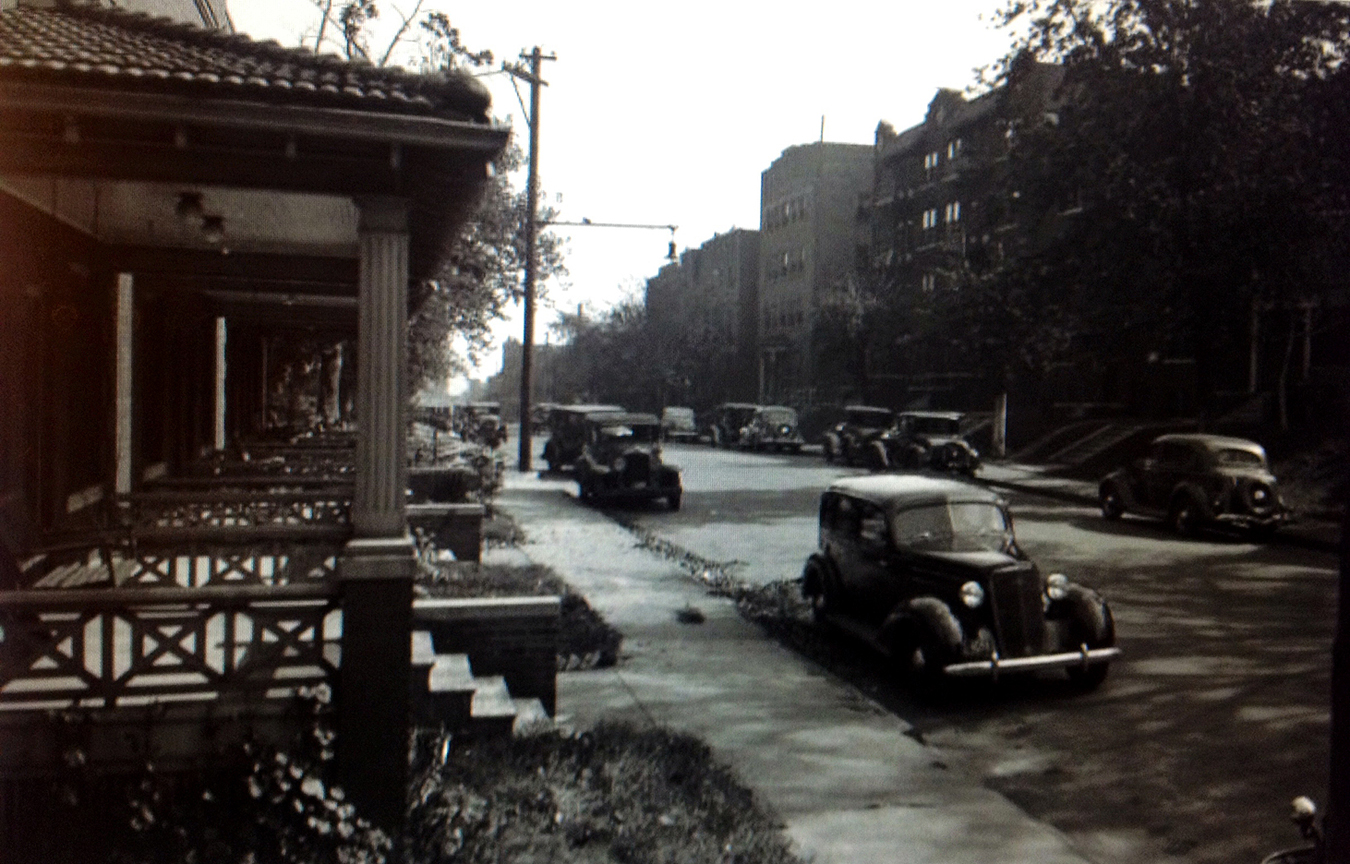
October 10, 1936. The row houses as they looked just west of our Shingle Style mansion at 2226 Howard. Photographer was standing at about 24th and Howard. This fantastic street scene faces east, giving a perfect view of Howard. The first apartment on the right is the Bartlett Apartments at 2227 Howard Street. This photo shows how dense the apartments used to be all the way down Howard. (Photo courtesy of the Bostwick-Frohardt/KM3TV Photography Collection at The Durham Museum Photo Archive).
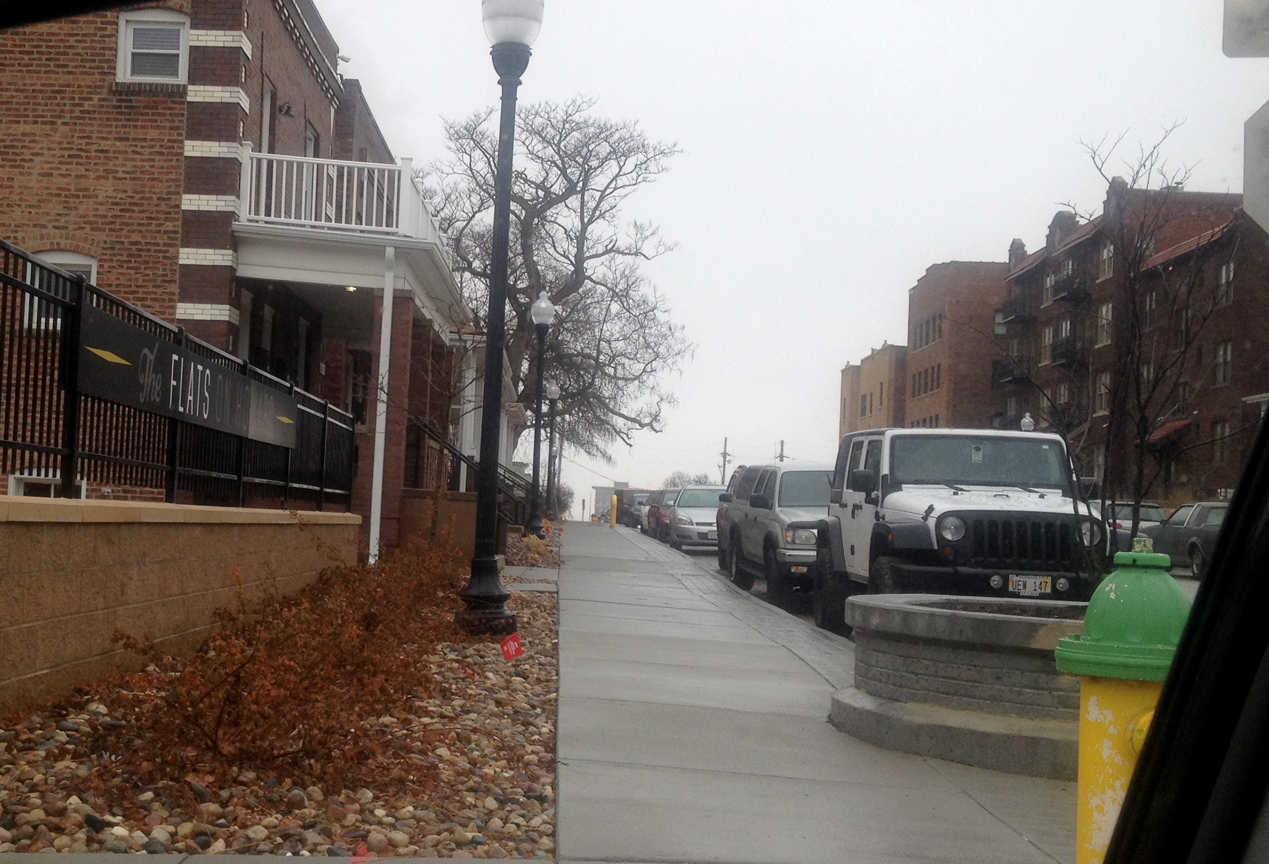
Here is the same view but from 2017. Notice the row houses in the foreground (what would have been 2314 Howard, with the lovely tile roofing, is now gone.) The southern side of the street is still standing intact, showing the Bartlett, Bosworth, Longfellow and Forrest apartments still standing.The landscape abruptly drops off after the Forrest, unlike the previous photo.
The 1940s Case History
Byron G. Burbank maintained ownership of 2226 Howard with Cyril J. and Mabel Hedderly running the store and rooming house. But by May 9, 1940 I found someone trying to unload this property: “A Real Money Maker. Cash grocery, meats, apartments. Gross income $4,000 yearly. Operating expenses less than $125 month. Rent $60. $600 handles.” According to the inflation calculator, $4,000 in 1940 was equal to about $68,000 in current dollars. I remembered that World War II had started just months before.
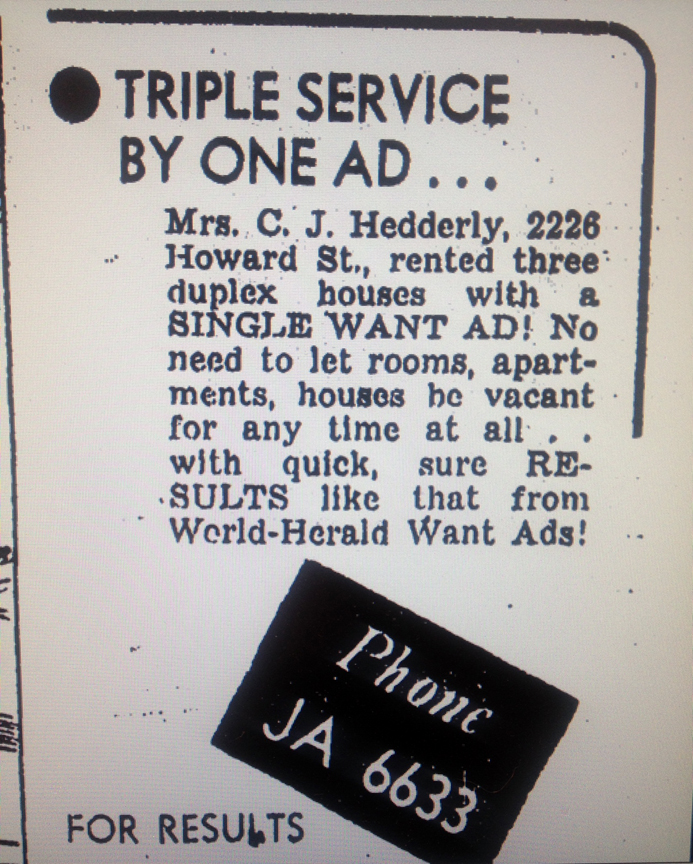
Ad from March 25, 1941. “Triple Service.” Mrs. C. J. Hedderly rented three duplex houses with one single want ad! This advertisement confirmed a hunch that the Hedderlys were property managers for a few of Mr. Burbank’s investments.
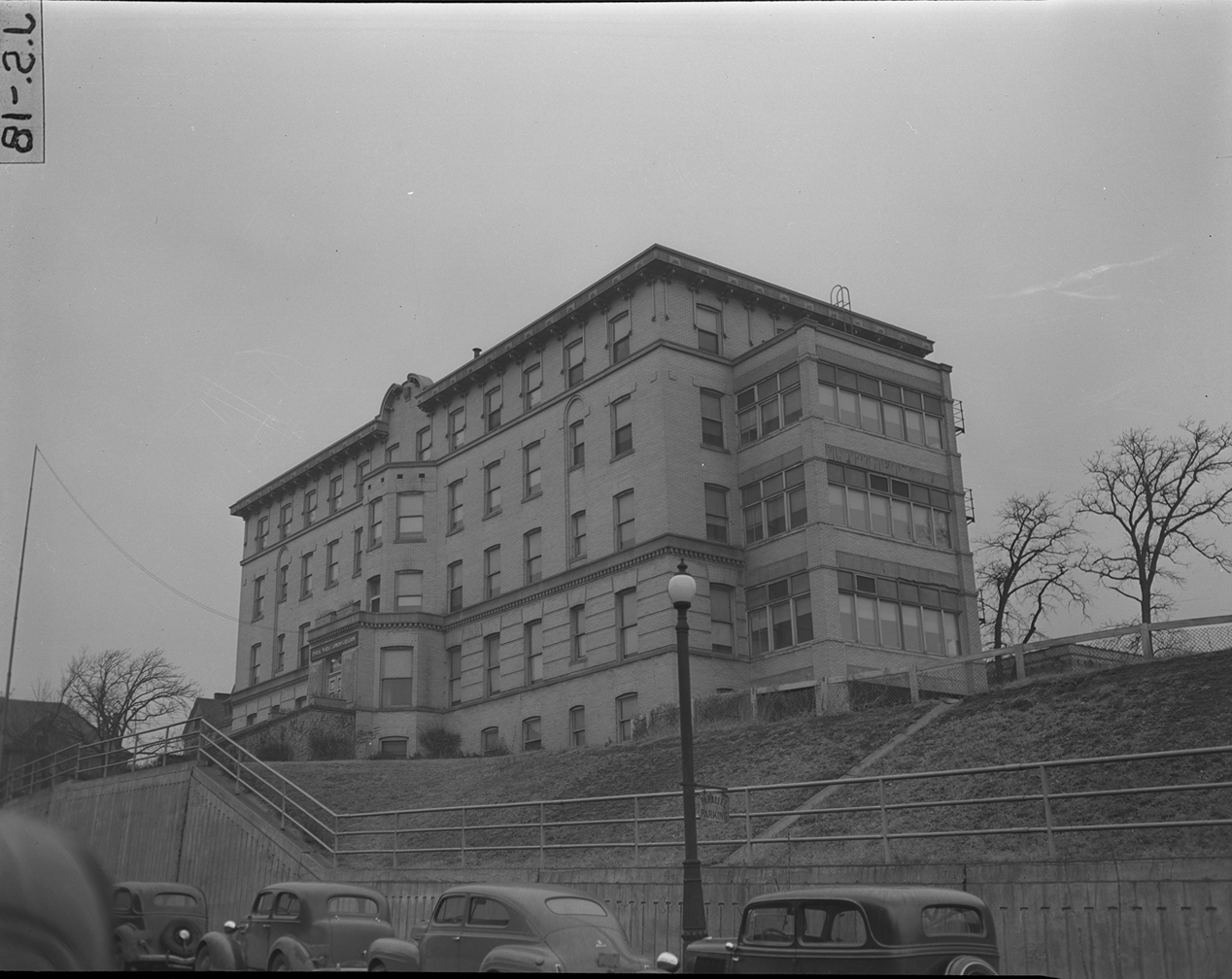
1943 Bishop Clarkson Memorial Hospital. This photo gives light to the lowering of Howard Street and regrade. The old Clarkson Hospital building stands as the Public Works Administration Building at 2100 Howard Street. Clarkson Memorial Hospital would later have a groundbreaking ceremony in 1957 at their new location at 44th and Dewey. By 1959 the building was complete. Other accounts say that the newer Clarkson was opened in 1955. The building at 2100 Howard later became apartments and was eventually torn down (1966) and replaced by the power plant that is there currently. A visit to the incredible DOGIS site shows that between the 1962 and 1973 aerial shots, the NRG Energy Center power plant building appeared. -Note the homes to the west of this hospital. Another photo of these is coming up. I reached out to a good friend and antique everything expert, Syd, who estimated that this was a just post WWII photo, judging from the mix of cars. Bill at the Durham said it was from 1943. Great Image! (John Savage Collection owned by the Omaha World Herald. Lent with permission, courtesy of The Durham Museum Photo Archive).

How 2100 Howard (general area) looks today. NRG Energy Center 2152 Howard. Yes, that giant steam-making building. Downtown Omaha’s heating and cooling machine. According to the NRG website, “NRG Energy Center Omaha provides energy-efficient and environmentally sound district heating and cooling for the business district of downtown Omaha, including Woodman Tower, Creighton University, the Joslyn Art Museum, Creighton University Medical Center and more than 70 percent of all other public and commercial buildings in the downtown area.”

In 1946 the well-known John Latenser & Sons Company designed the new McFayden Ford dealership building at 20th and Howard Street. This would become the Omaha Children Museum on the southeast corner of 20th and Howard. Omaha Children’s Museum, how it looks today at 500 S. 20th Street. http://www.ocm.org/
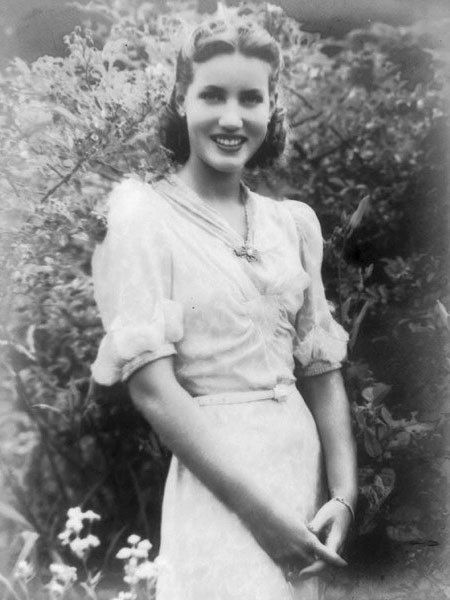
I am only leaving Little Edie Bouvier Beale here to brighten up this spot. This beautiful creature is who I imagine could have, should hav,e been living at 2226 Howard all along.
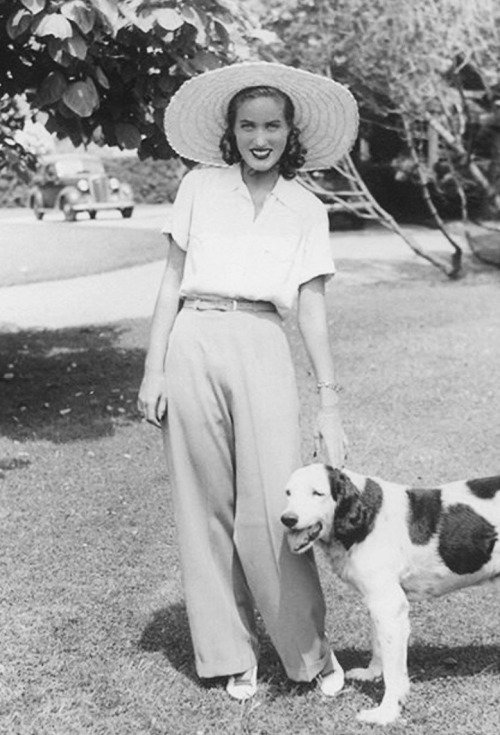
Family Ownership and More Neighborhood Clues
According to the Register of Deeds, in April of 1946 yet another owner bought the home from Mr. Burbank. It just so happens that the subsequent owners have all been family members of this 1946 buyer. Out of respect for the current owner’s privacy, I will not reveal anything about the owners from 1946 on. What I can tell you is, it would appear that the grocery store—furnished rooms arrangement continued on into the early 1950s, perhaps longer. Our lovely Shingle Style mansion continued on in an apartment style rather than rented rooms into the 1980s, from what I have been able to gather.
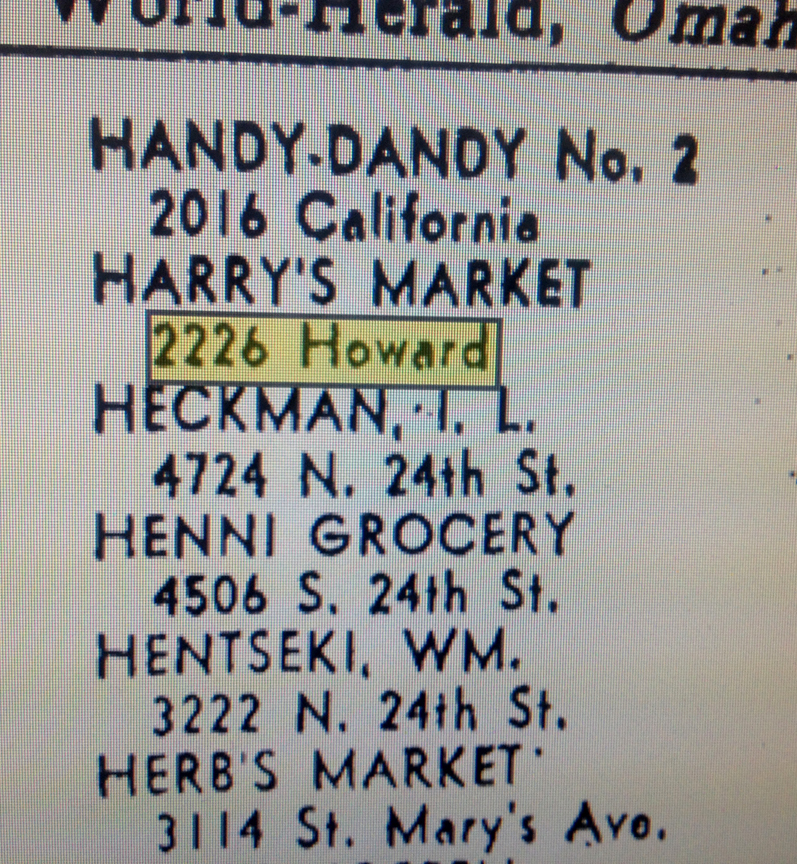
Harry’s Market advertisement placed the grocery exactly at 2226 Howard.
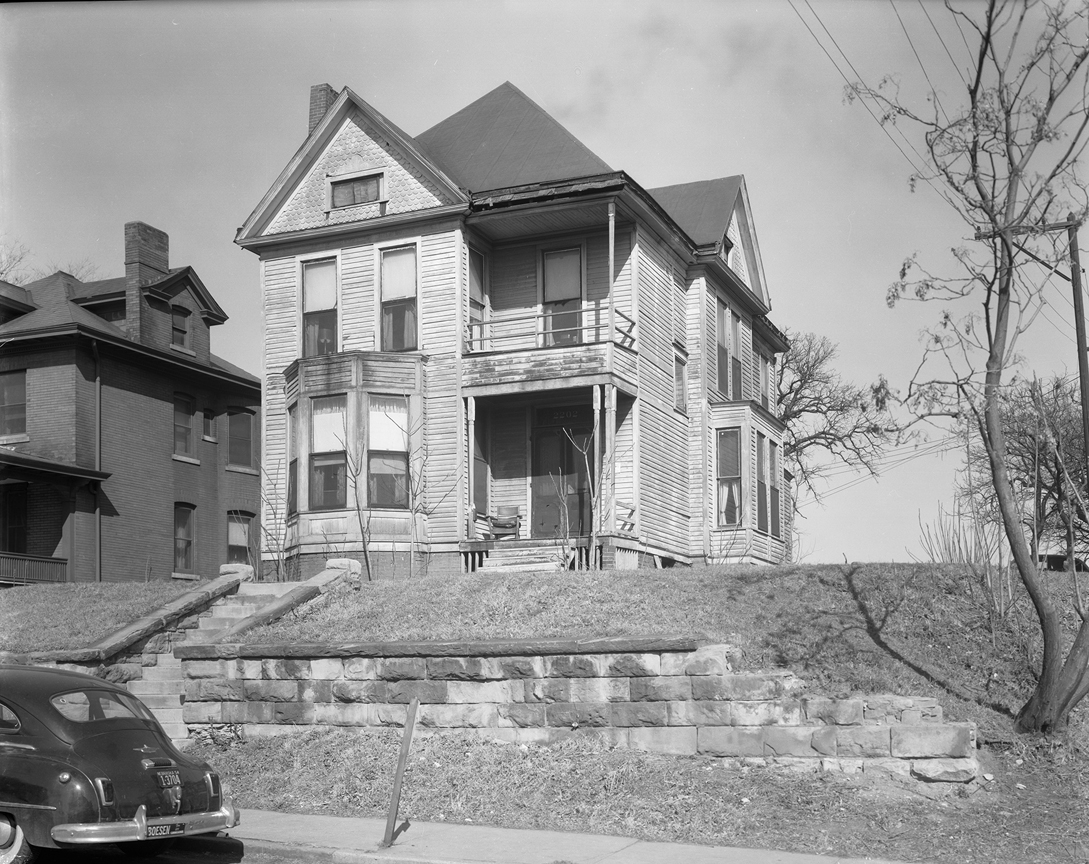
March 5, 1954. Large house at 2202 Howard Street. This would have been directly to the west of the Clarkson Memorial. Now an empty lot. Notice the large fine brick home to the west—this would have been 2204 Howard, now an empty lot. (Photo courtesy of the Bostwick-Frohardt/KM3TV Photography Collection at The Durham Museum Photo Archive).

I happened upon this 1948 Landon Court Grocery ad for 22nd and Howard. I believe this was David Frank’s little corner grocery that was held up. The address had been 2110 Howard.
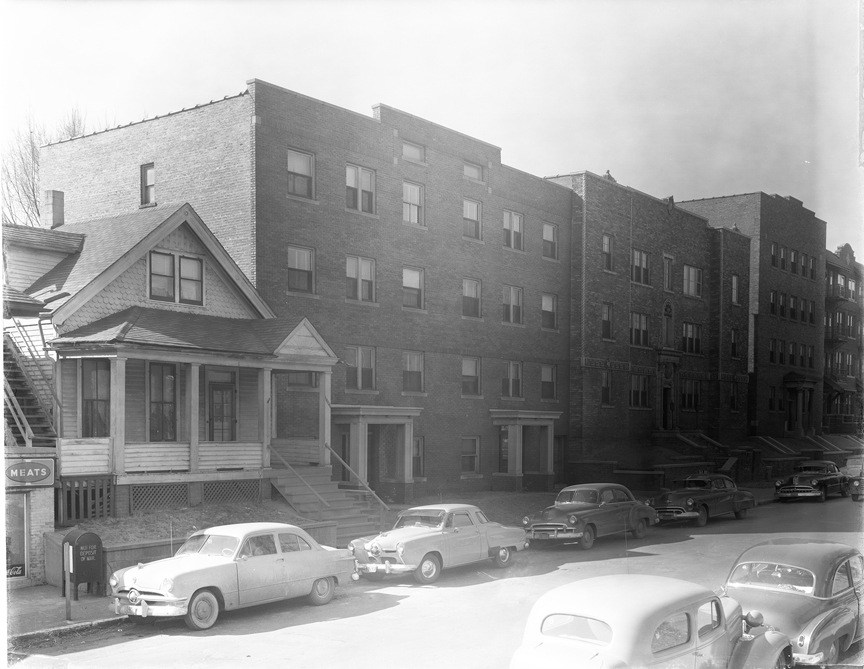
March of 1954. South side of Howard Street, almost at 22nd and Howard. A small corner grocery store is seen with the sign “Meats” on said corner. (I believe this was the site of David Frank’s original grocery store.) To the store’s west is a small white house, already converted to into apartments, judging from its sidewinding stairwell. To the west of that is a large apartment building with two entrances. All three of these buildings have been razed. To the west of the double entrance apartment is the Forrest Apartments, still standing. (Photo courtesy of the Bostwick-Frohardt/KM3TV Photography Collection at The Durham Museum Photo Archive). Love these shots and of course these cars. Take me back in time but only if I can have the best dresses and fitted sweaters.
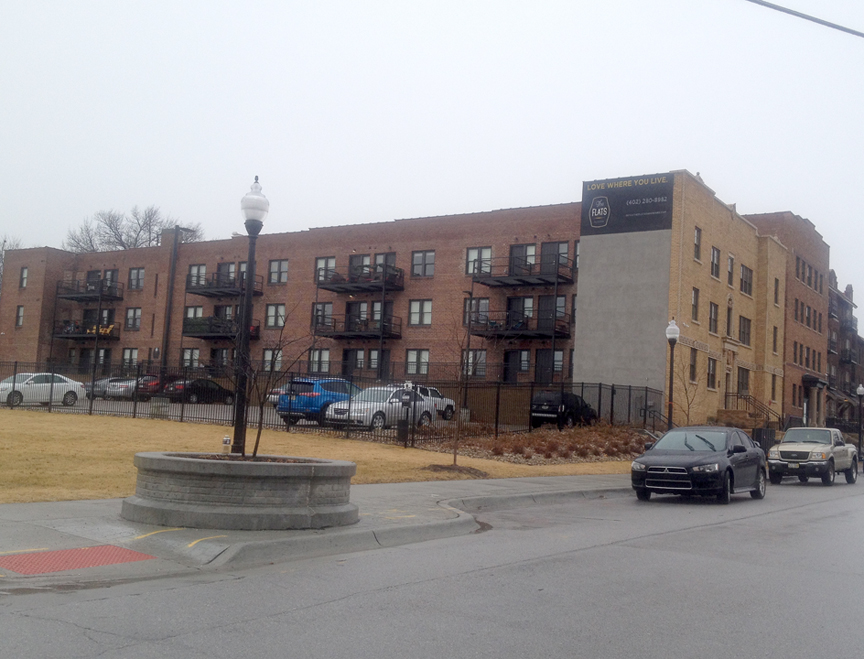
The view of 22nd and Howard in 2017 photo of 22nd and Howard. Notice the Forrest Apartments are the last apartments standing on the eastern most side. Next to the Forrest is the Longfellow. The missing apartments on the eastern corner have allowed the new developers to build decks and parking for new tenants. Trying to look for the positives.
The 1960s
2226 Howard in the 60s was still being rented out as furnished rooms but its owners also lived in the large home. An ad from 1961 marketed: “Basement for rent. Ideal for pensioners. No Drinkers. Men only.” As with the times, in the late 1960s the home went from being called furnished rooms to apartments. I wondered how much work was done inside the home to reconfigure it to proper apartments, instead of having a shared bathroom down the hall? Or was there a shared bathroom down the hall? I would love to have seen photos of this great home through the years.
You can imagine, over this many years, how many people came and went from our Shingle Style mansion. A large number of tenants living at 2226 Howard were involved with the law, mentioned in stories of accidents and sweet anecdotal tales. There were marble tournament winners; Moral Raid busts involving arrests and hooch seizures; There were a surprising number of tenants struck by cars over the years, sometimes resulting in death. At one point a worker fixing the roof fell from atop our mansion, ultimately ending his life. To conjure the people who have passed through her doors. I cannot imagine the energy in her floorboards and within her halls. Truly breathtaking to dream on the stories she could whisper to you…
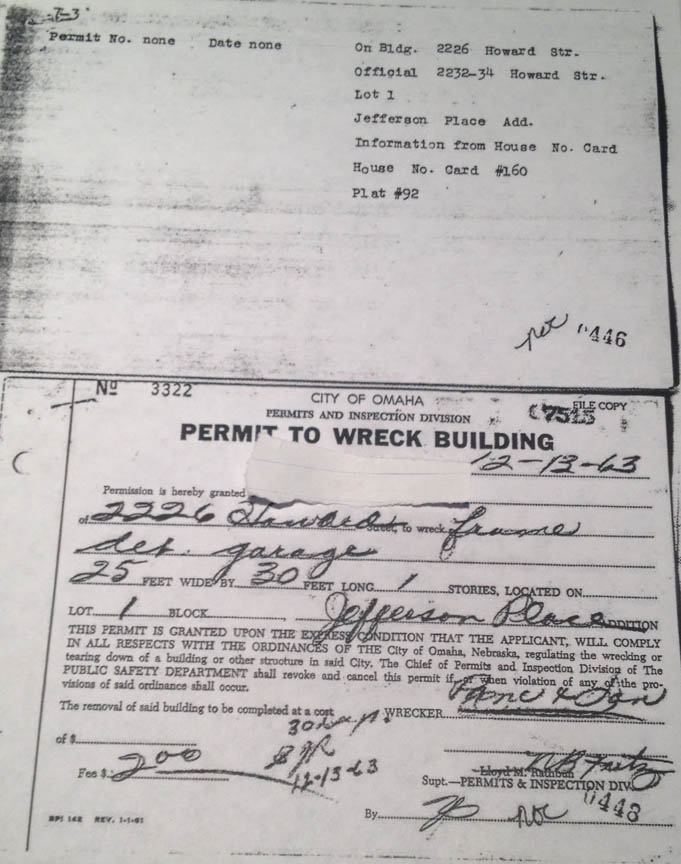
From December 13, 1963–the document from the City Planning Department (Thanks to my dear friend, Joe Knapp.) Permit to Wreck Building, the large frame detached garage that had stored so many horses and cars over the years. I covered the owner’s name for privacy reasons. Do you love historical handwritten notes and forms as much as I? I could sit at the Register of Deeds Office and pore over their large, handwritten ledgers All Day Long.
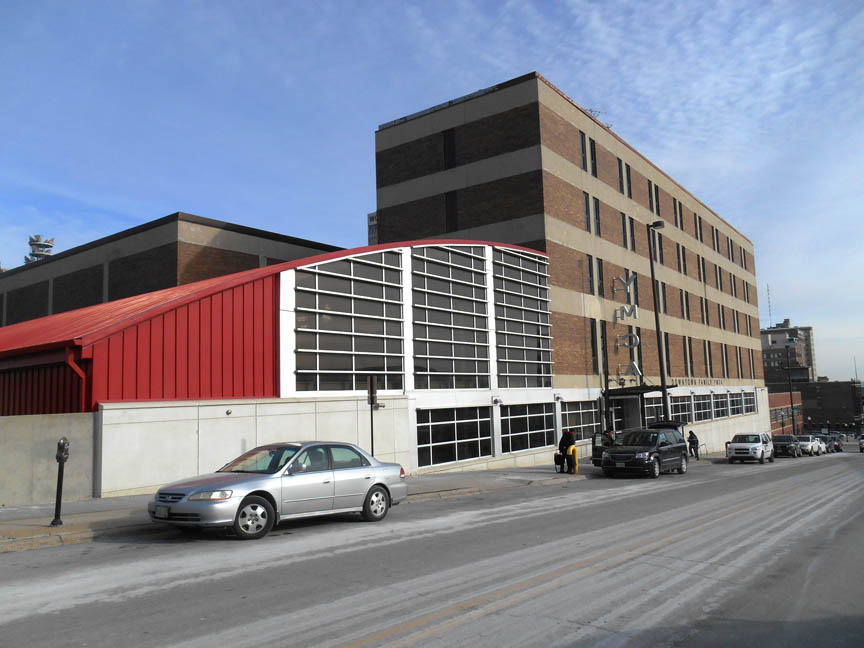
In 1968 the YMCA building groundbreaking was begun northwest corner of 20th and Howard. 430 South 20th Street. The YMCA moved from 17th and Harney where it had been for decades. Two years earlier in 1966 the Bishop Clarkson Memorial Hospital at 2100 Howard was razed. It had already moved to its current location in the UNMC area.
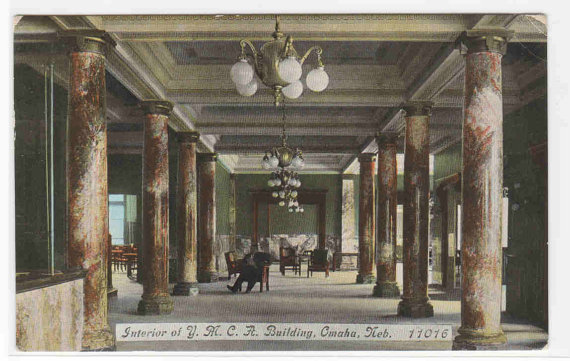
Here is a postcard of the interior of the old YMCA at 17th and Harney. It doesn’t look like it smells of old gym socks and a pile of handball towels. In fact, it is quite magnificent.
1980
In July of 1980, 2226 Howard transferred into the current owner’s name, a relative in a short list of familial owners. Again I will not print their name to protect their privacy. All accounts say that this is a privately owned home and it is no longer a multi-rental apartment building. Just short of going right up to the door, which I would not want intrude or make someone feel uncomfortable, it certainly looks lived in and yard is well maintained. On the numerous days that I have wandered past, I have seen various people coming and going. But never a light and never a peep from inside. Are there renters living in the home or is it truly a single family home? I am sure one of you knows.
The following are some great photos that Trina Westman of the Omaha City Planning Department sent to me from the 1980 Landmarks Survey of this area. I treasure these, my only glimpse of 2226 Howard from the past.
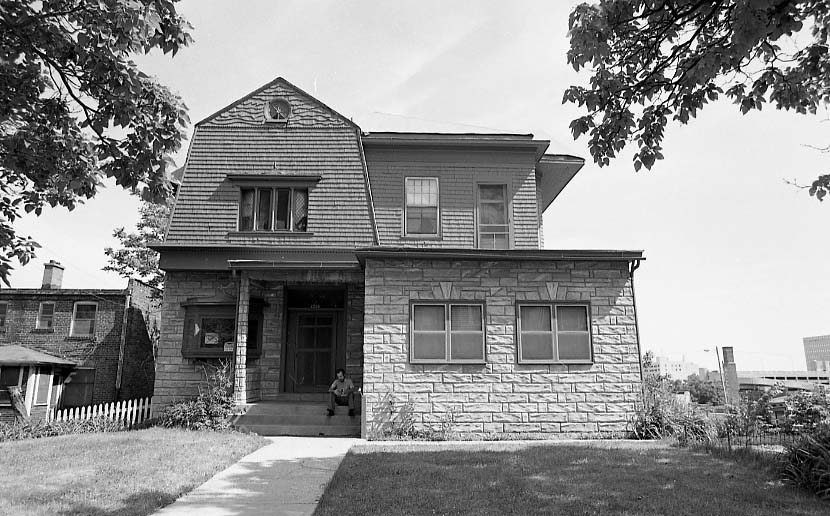
Front view of the home from 1980 Landmarks Survey. There was an overhang on the porch with a stone support column. From this photo it is easier to see the stone work on the front of the home. I believe the door on the second floor, allowing one to go out on the addition’s roof, was added by Burbank as well.
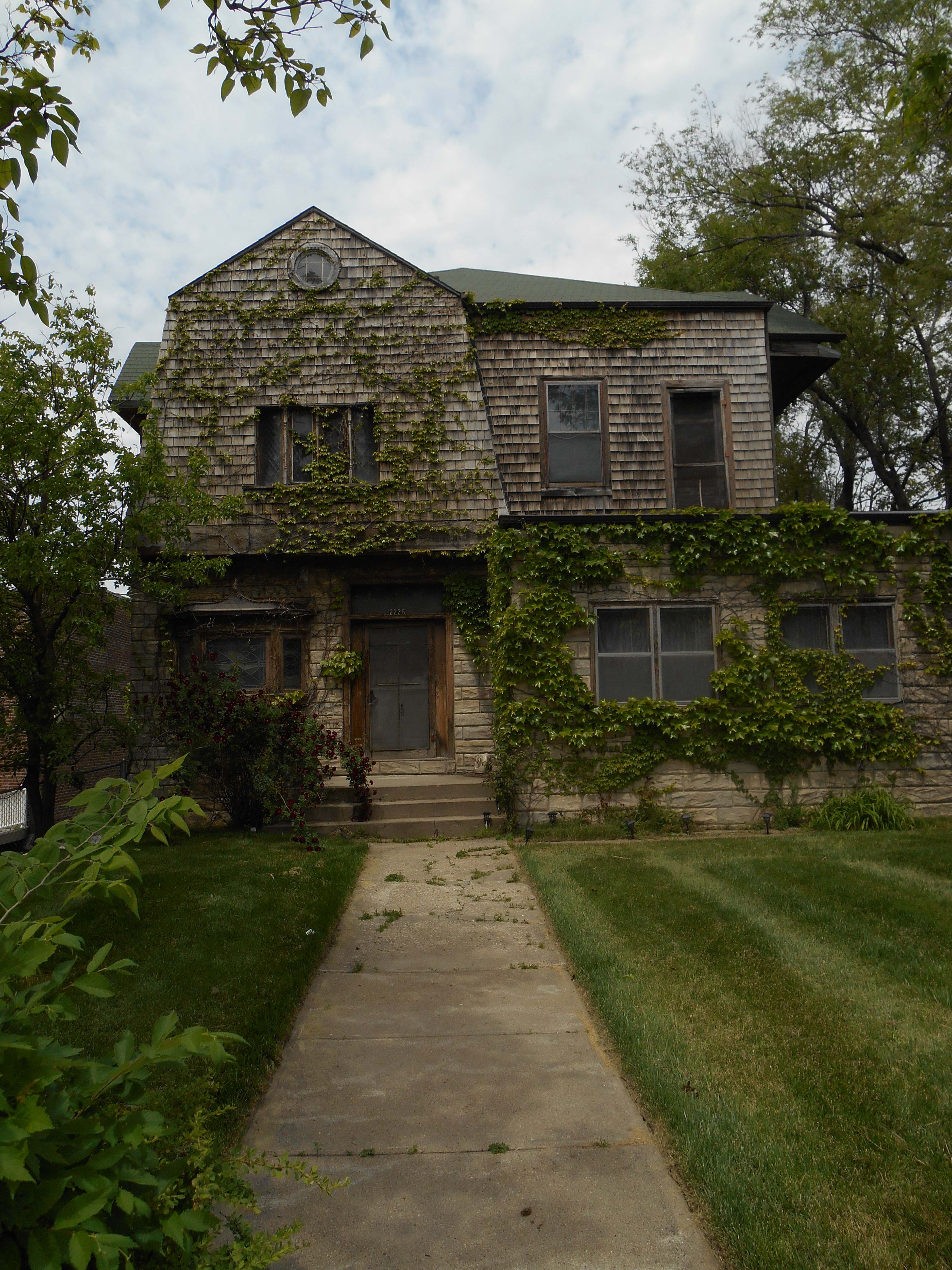
Early June 2016. With the front porch removed. I do believe the house is more gorgeous, more mysterious now.
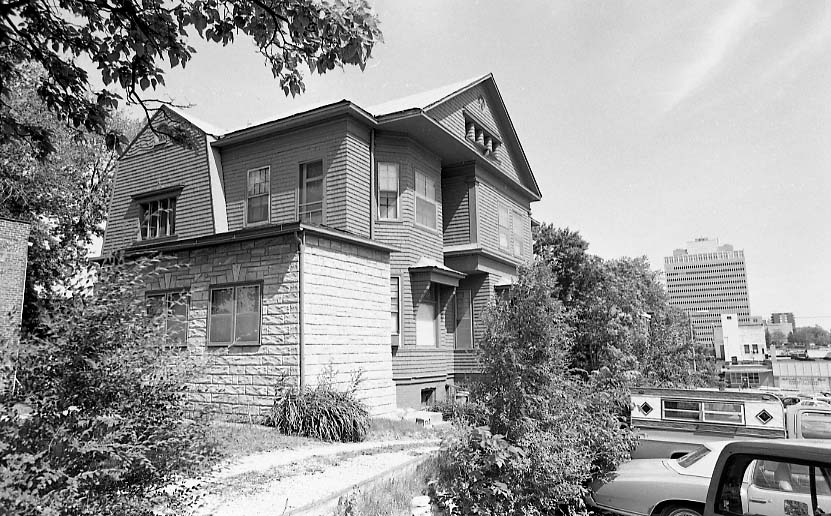
East view of the home from 1980 Landmarks Survey. You can see the driveway was still used then.

East side of 2226 Howard from early June 2016.
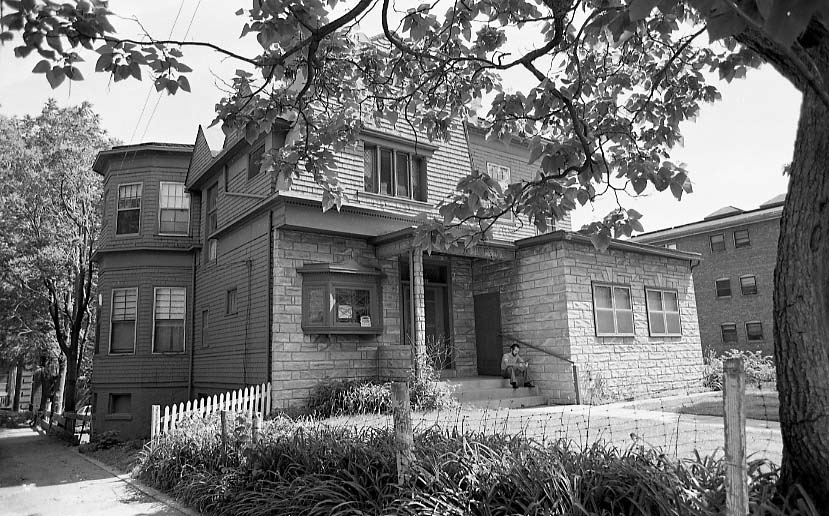
Western view of the home from the 1980 Landmarks Survey.
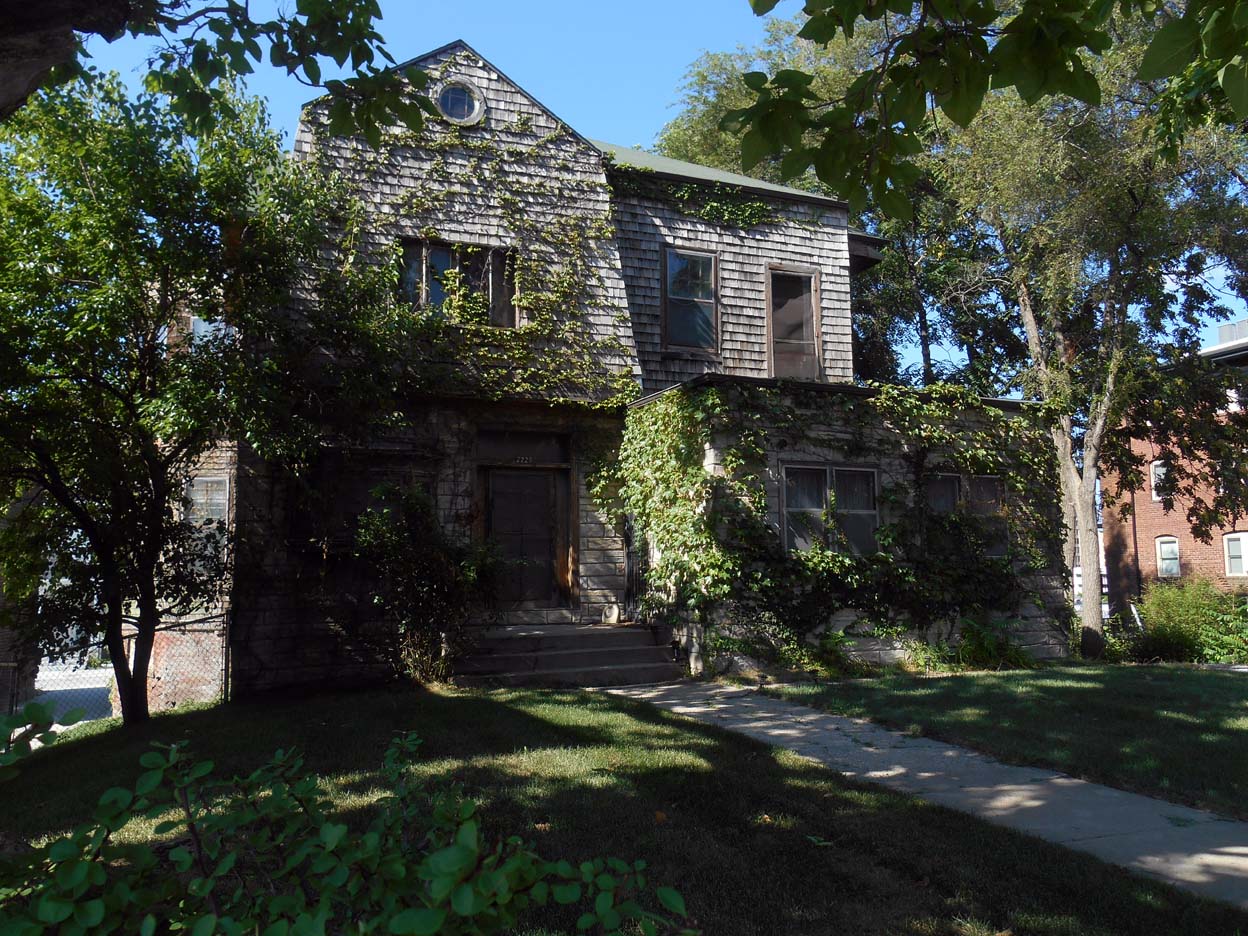
Western angle from early June 2016.
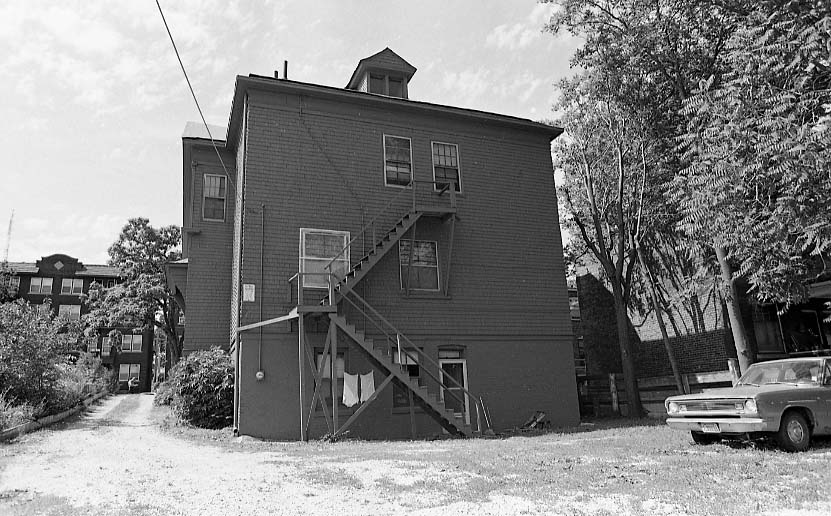
The fire escape in the rear doesn’t have exit doors. 1980 Landmarks Survey
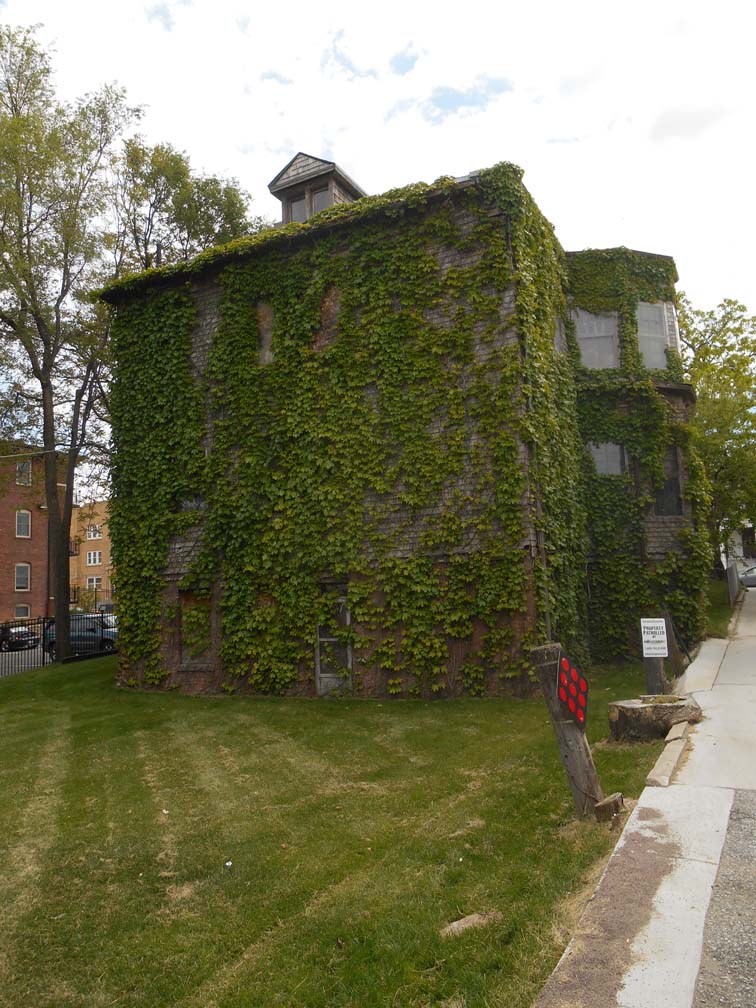
Early June 2016.

The large backyard.
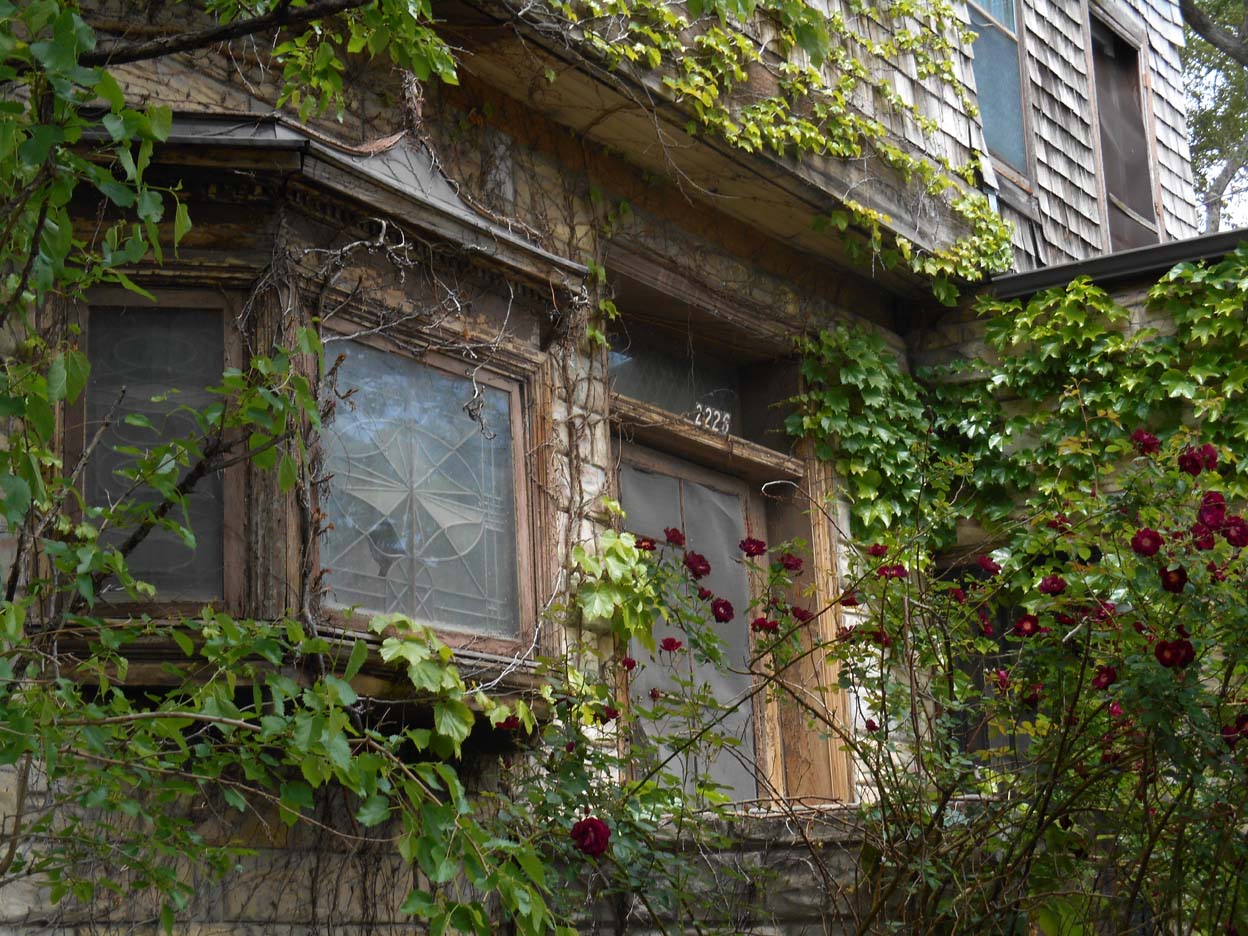
Beautiful roses greet you at the door. And that window…

The eastern most side of the house and what appears to be another entrance. Such scrumptious details. According to the city, there have been 7 building permits filed for 2226 Howard in the last 21 years.
Stretch of Howard Street Apartments District
Starting in 1981 there had been renewed interest in returning the Howard Street Apartments to its once glory. A private investor had bought three apartments in the area. I am not sure whatever became of his plans. By 1994 there was a halfway house at 22nd and Howard, leading to the paper calling the area and other downtown squats by the name Tramp Camp.
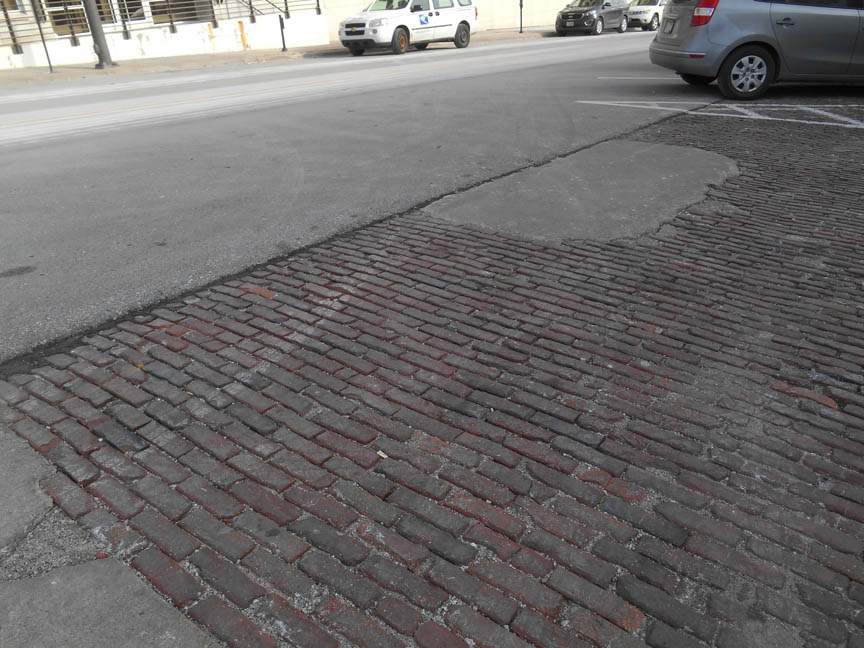
The brick street of Howard still visible in between the YMCA and the Children’s Museum.
In the late 1990s I began a membership at the Downtown YMCA. This is when I first became aware of this puzzling area. I would often park up on Howard Street and walk down the hill to the Y, just to feel the enchanting experience. As beautiful as it was, it did not appear as it does today, although all architectural elements were still present. It seemed barren almost…abandoned. Some of the apartments looked run down and rough. There was a sporadic amount of increased criminal activity in those years, according to the newspapers but I wasn’t with things like that at the time. I always loved the mysterious feel of the abandoned movie set, a strange blending of dense apartments minus the tenants, a lone mansion from yesteryear, many empty lots, a huge steam machine and the Children’s Museum–YMCA corner. Was that a tumble weed prop rolling down the hill?
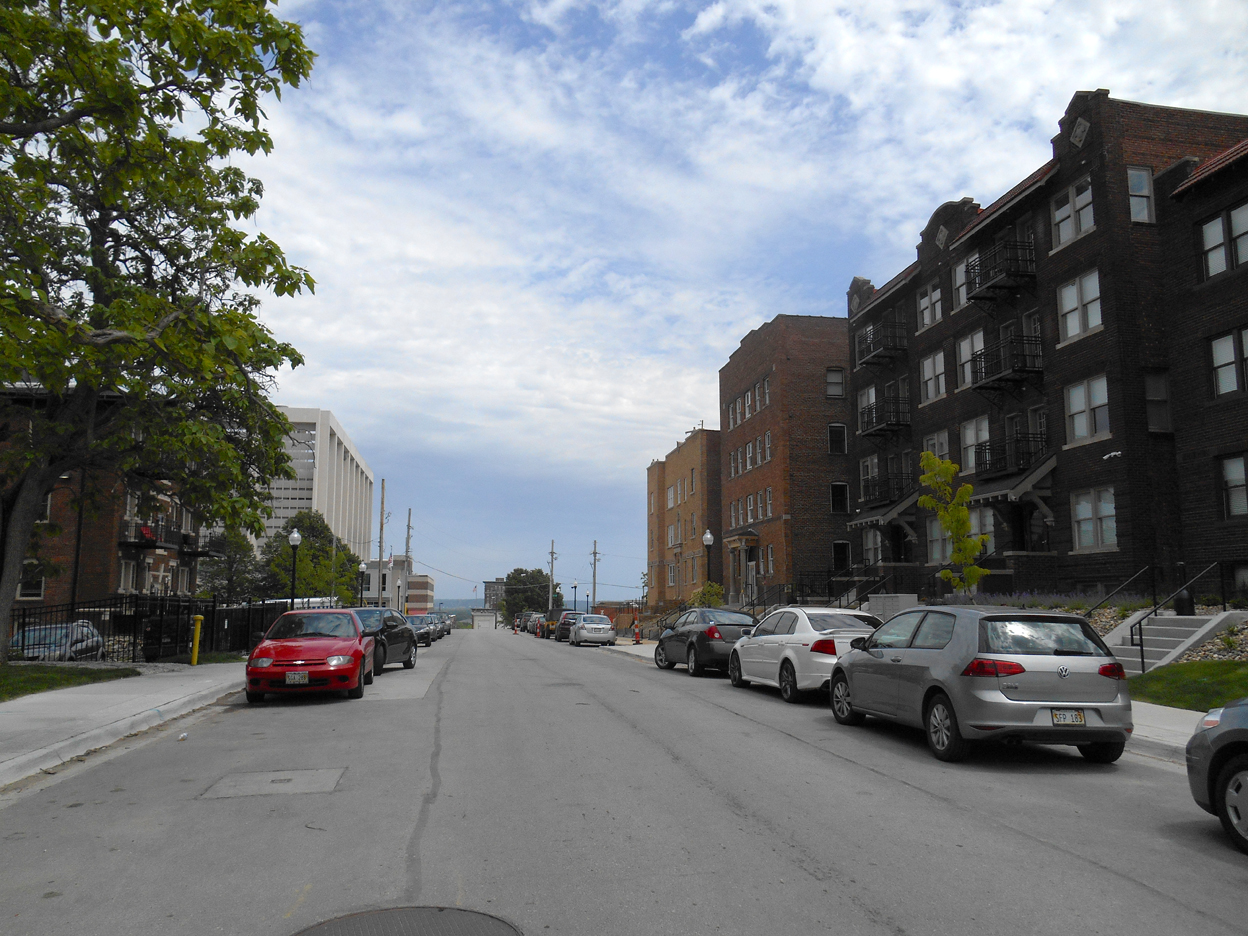
From what I could find, 2015 brought Arch Icon and TFL development firms to the neighborhood and thanks to their eye for restoration and historic tax credits, this incredible block is looking better than ever. All of the apartments seem to be filled and a stroll down the sidewalk on a good day will put you face to face with all sorts of energized, young people. The street is clearly reinvigorated with the elements that brought downtown workers to this neighborhood in the 1920s.
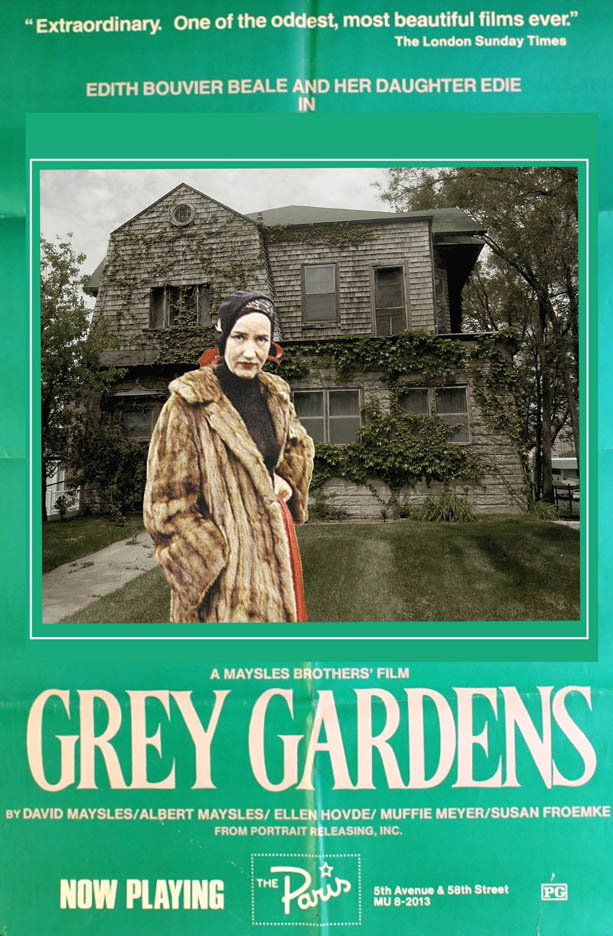
As for 2226 Howard, I long to go inside this treasured Omaha home. I imagine her Gloriously Dark interior. How I would love to bask in a book-lined library or revel in one of those long tower windows while having a good morning stretch. I would like to think that house and I could have a good, long chat. And Mr. Cassette could design the garden with a variety of pale colored flowers including climbing rose, lavender, phlox, and delphinium. Maybe a small, partially shingled teahouse of the 1930s could be established in a corner of the back yard…. where we could sit with friends and look out on our nice Grey Gardens.
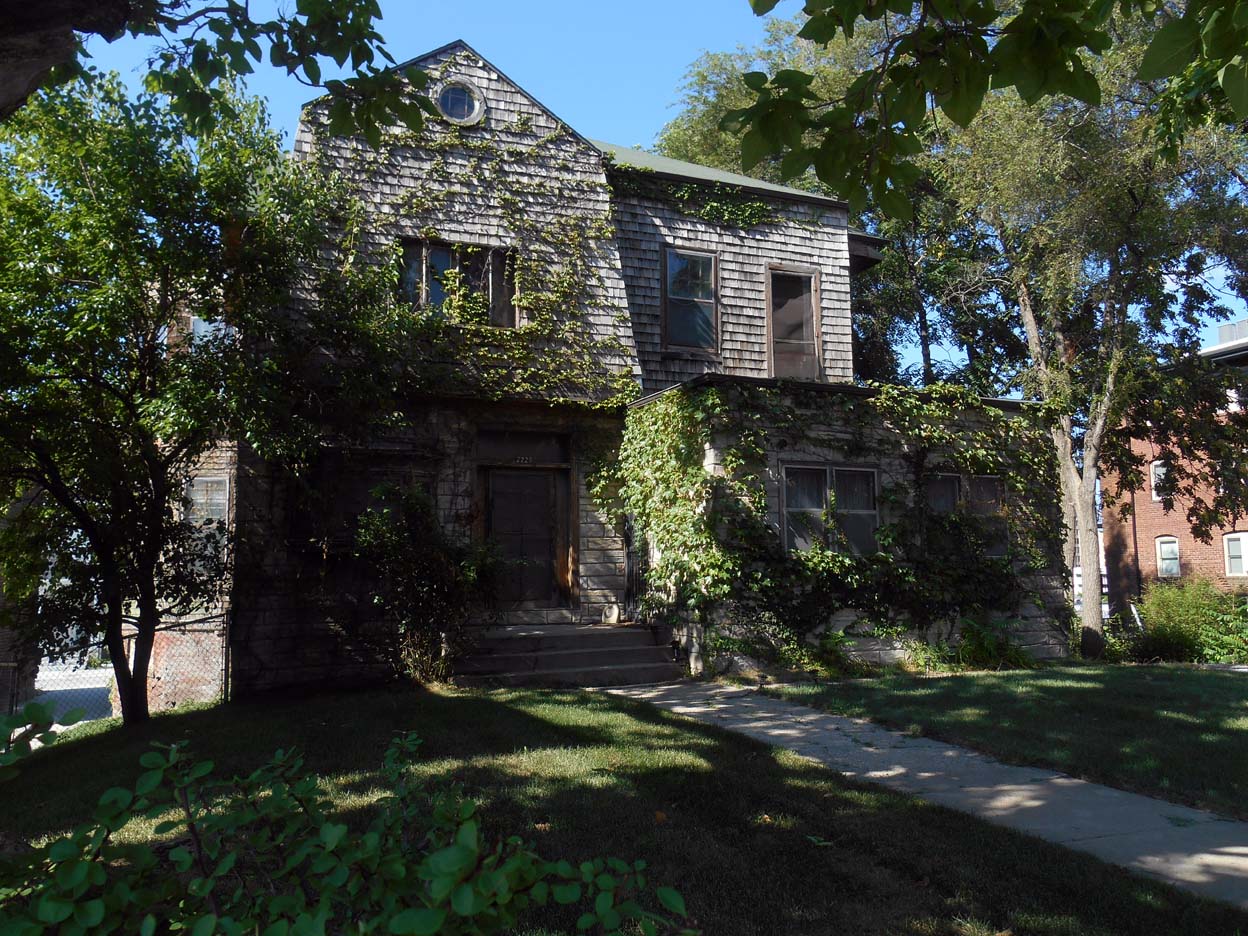

2022.
**Psssst!! Update of Sept 23, 2023:
On September 19, 2023 our 2226 Howard Street property was put on the market. She’s been getting a lot more attention since our 2017 investigation. We have all been dying to see the interior and here she is. Within days there was an offer—sites now show the sale is “pending.” More to come….
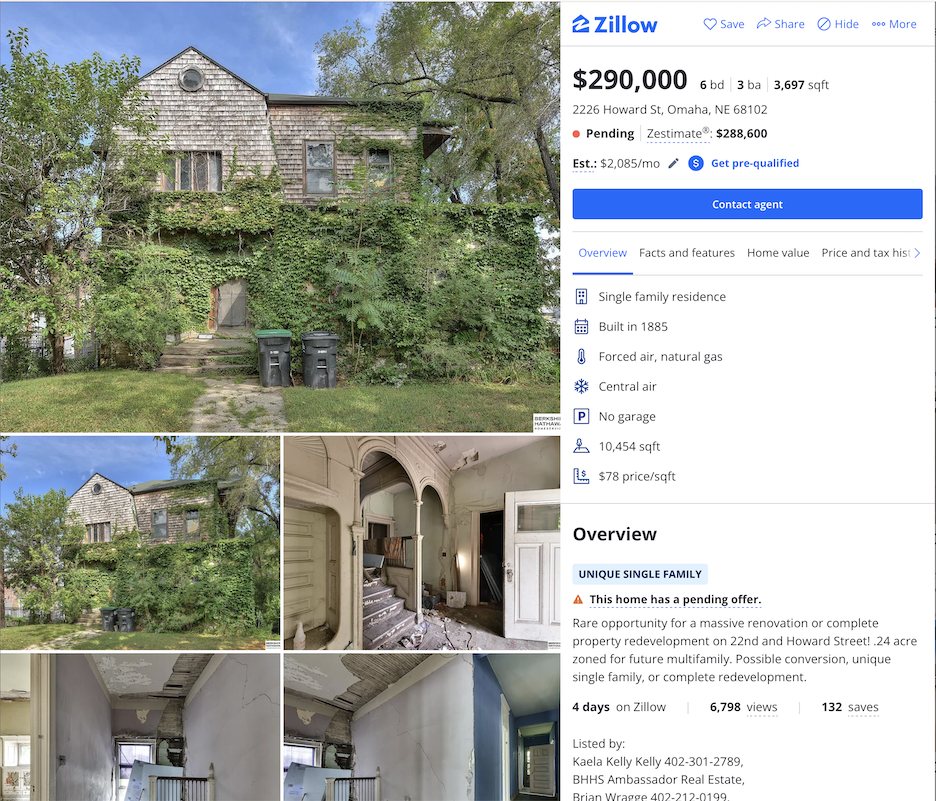
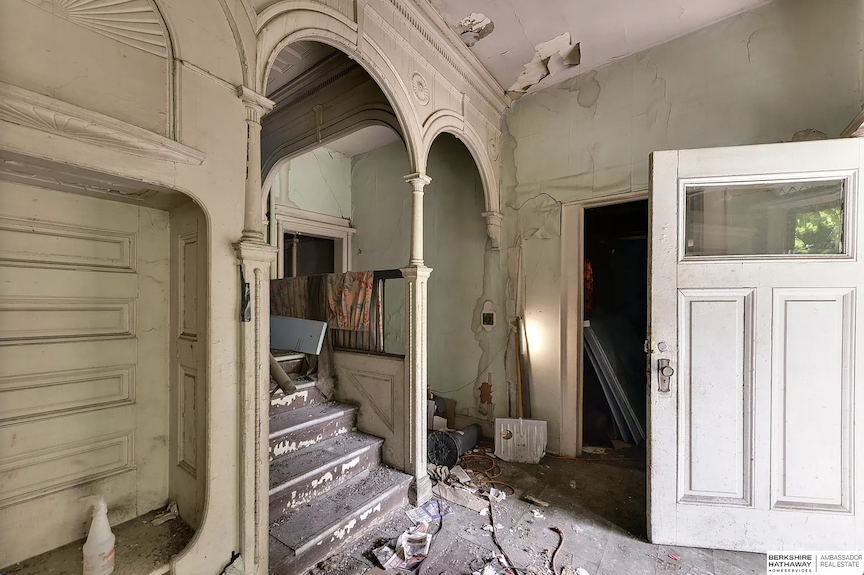

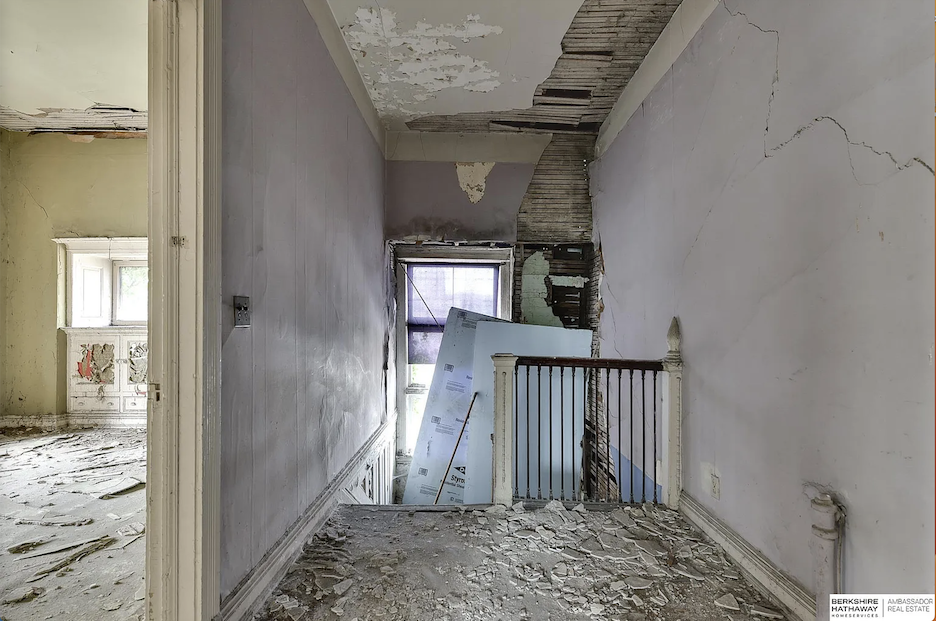
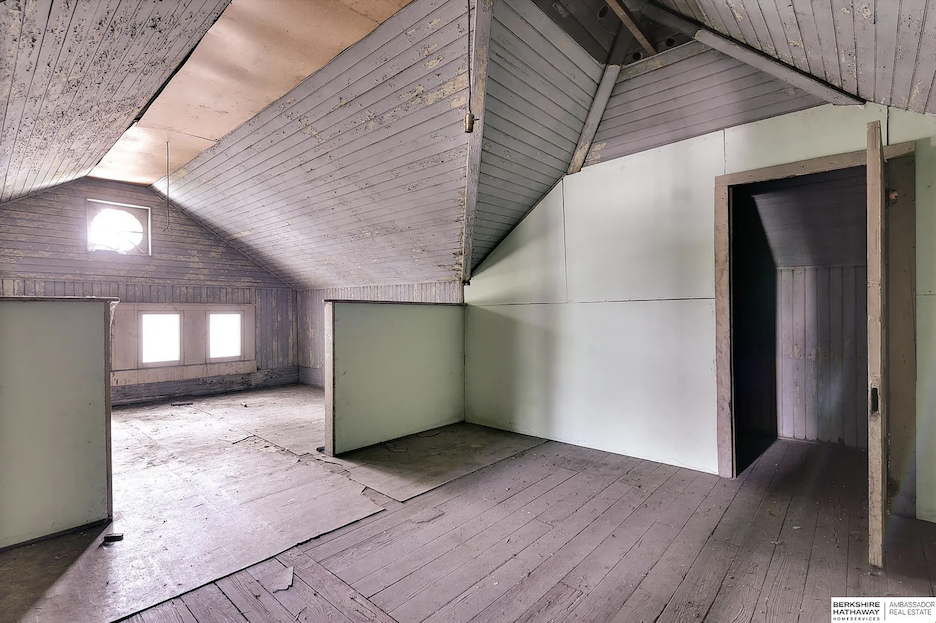
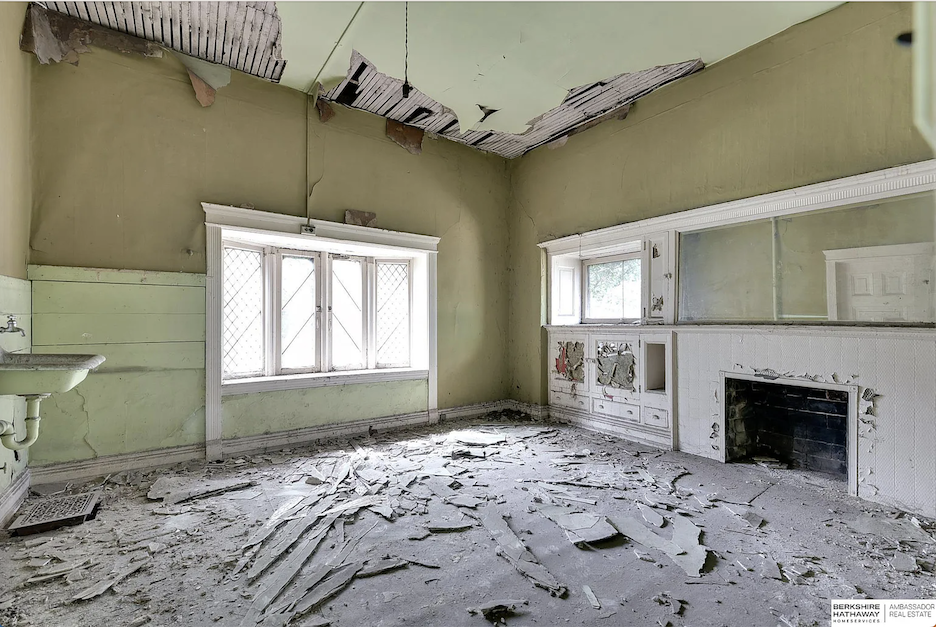
All images borrowed Zillow.
October of 2023. Photo borrowed from the Douglas County Assessor.
The Rest of the Story
Leigh Anne and Bryan Walter Mueller bought the 2226 Howard Street property from Haldane Cleminson III in October-November of 2023 for $260,000. In early November, I heard from Darren Schwinck, a man who has worked in the architectural salvage business for 45+ yrs: “I am currently working for the person that bought salvage rights to that house from the new owner. Sadly it’s in far worse condition inside than those Zillow pictures showed! While this house was far too deteriorated to restore, many of its features from inside will live on in new locations.” He noted, however, that “most of the really impressive stuff was already torn out” of the home. I asked him if architectural scavengers had broken in. Darren explained, yes, people had broken in there, removing things before the salvage business had arrived. They locked up every night but when they’d return, someone had broken in or tried to break in again. Darren and I began communicating and he was so kind to send us more photos with details.
The information Darren shared was fascinating, however dismal. The following descriptions tell of a boarding house transformation that never really returned to its former glory years when it was a single-family home. We have seen run-down sleeping rooms but never anything quite like this. Once grandeur seen in this state of decrepitude is both haunting and strangely beautiful to me at the same time. The longing…and the whys.
“It had a gas (acetylene?) lighting system piped to many of the rooms prior to electricity. This was probably original equipment when it was built, but this system was out of service long ago. Minimal electrical service was added later, possibly 1910-1920s. Minimal electrical updates after that. There were two fireplaces on main level and one on the second level. All had impressive mantles with large mirrors. The main level had two bathrooms in the northwest corner. Four rooms look like they were used as boarding rooms/living space. Two of those rooms had a wall sink but no toilet or bathtub; one had a minimalist kitchen where the most recent resident had been living. No formal kitchen anywhere!
The second level had one bathroom in northeast corner. Five rooms were used as boarding rooms, four of those had a wall sink only and I believe one had nothing. Three of the rooms had a closet with three drawer, built-in dresser. The third level was two large rooms. One of them had a dividing wall that went up 4-5′ high. No plumbing up there but gas lighting went all the way up! The basement had one or two bathrooms, possibly 2-4 rooms that were used as boarding rooms.
Only one exterior door on main level, one in back, on the walk out basement.
No closets in most of the rooms. That’s probably normal for the period, as people would’ve used a wardrobe for their formal/fancy hanging clothes.”
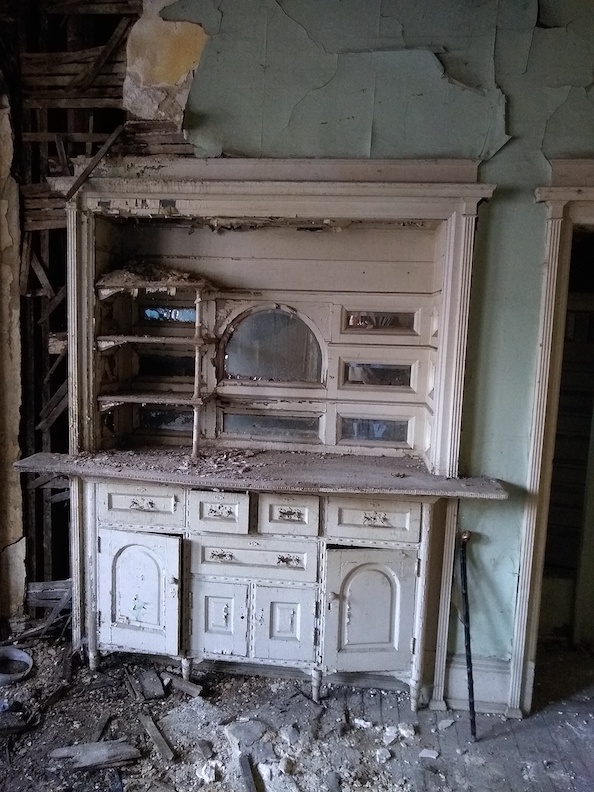
“The room with bay window on west side of main level must have originally been the formal dining room. This built-in cabinet was 6 1/2′ to 7′ wide x 7 1/2′ to 8′ tall. Unfortunately the roof leaked and destroyed part of it.”

“The room across the hall from dining room was the north bay window on east side. It had a nice fireplace mantle and built-in 9′ wide bookcase on right side. Originally it had another built-in cupboard of some sort on left side but that had been torn out– a plywood closet was in it’s place.”

“The large, heavy pocket doors in both of those rooms about 8′ tall x 8′ wide opening. Very unusual trim with pillars on either side. In the dining room they opened into the hallway and in the east room they opened to the adjacent room south, which was the south bay window on east side. Cast iron track/hardware inside the wall on those had patent date of Oct 12, 1885.”
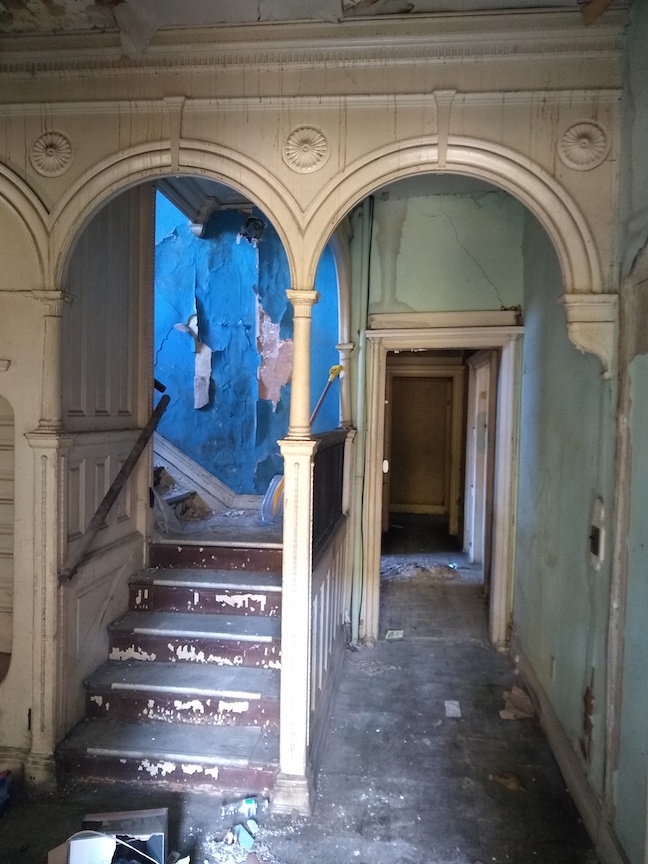
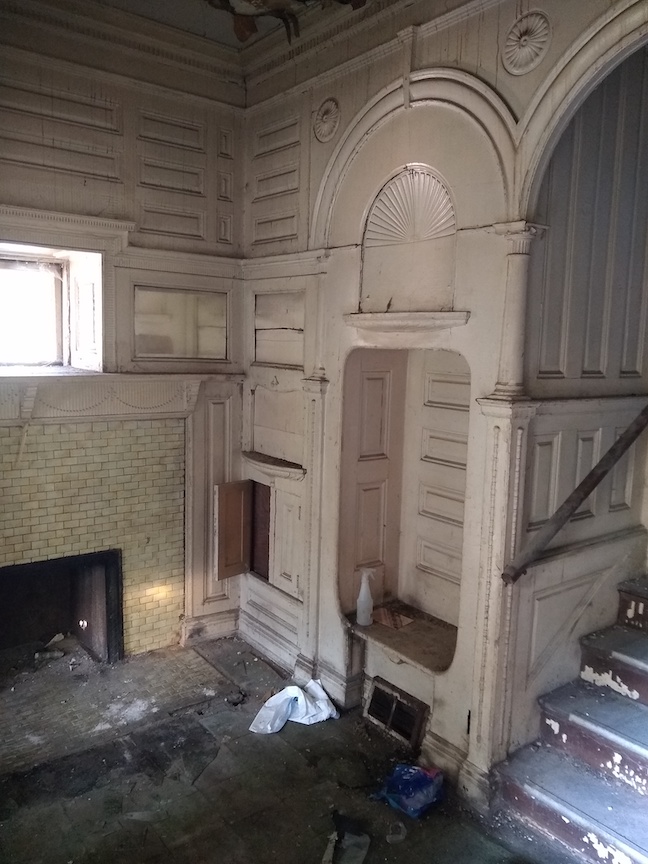
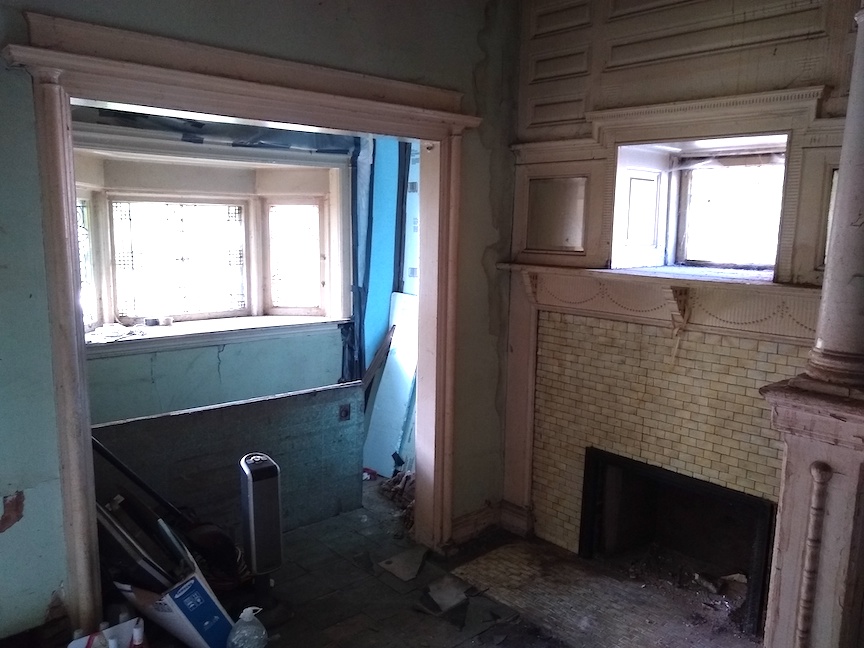
“Multiple views of the main entry area just inside the front door. Leaded glass windows visible here are to the west (left) of front door when viewed from the street.” Darren and team tore out the main staircase.

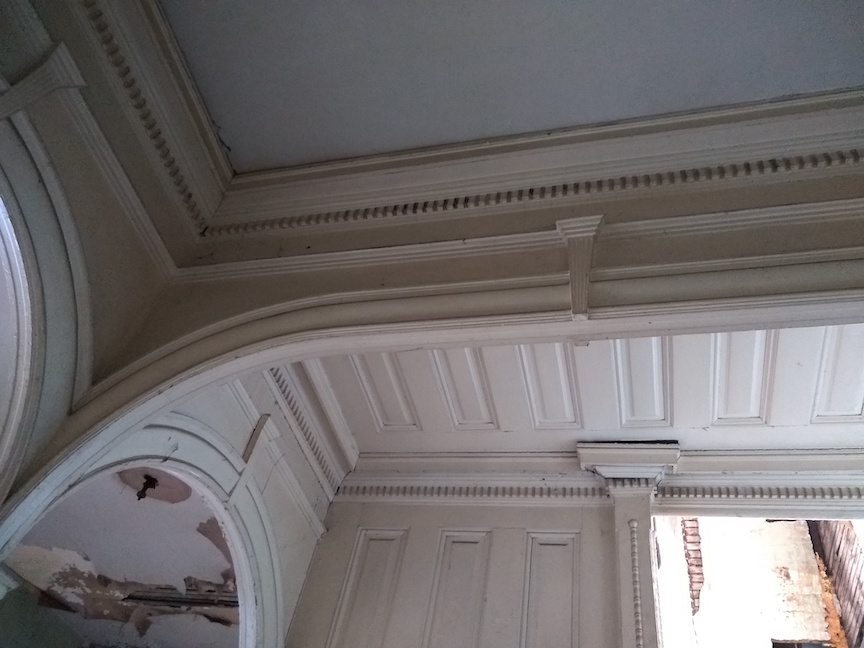

Purportedly the owner, Haldane Cleminson III, was already out of the house before salvage had begun. Regrettably he was “removed” at the end of July “against his will” and the house was legally condemned. Allegedly he was in his 90s and his family is from Chicago area. 2226 Howard Street had been in his family since that 1946 sale I had written about all those years ago. There are horror stories about his “caretaker” circulating from numerous people–that the lady should be facing criminal charges for elder abuse and embezzlement. From what people have heard and seen of his living conditions, there is shared amazement he lived through the experience. “She manipulated him into putting her in his will and she was supposed to get the house when he died.” However Mr. Cleminson’s removal happened in the last months, someone had gone through and emptied most of the house’s contents, as there was very little remaining when the salvage team arrived. One of the neighbors reported there were roll-off dumpsters full of stuff hauled away before it got listed for sale.
My friend Julie Sommer shared a memory that illuminates a bit more of Mr. Cleminson and his home. “Hal (Haldane Cleminson III) was a special friend of mine in the 1990s. He was a regular at Jones Street Brewery and we both shared a love of entomology. He didn’t drive, so I often drove him home to 2226 Howard where he lived with several raccoons, a few squirrels, and no electricity. He had milk wrapped in a wet towel on the counter. He was so intriguing to me, a character out of a beautiful novel. He’d sit on the patio at the restaurant, in the hot sun, in wool pants and a long sleeved shirt, and share his salad with a yellow jacket wasp. I saved all the letters he wrote describing beetles he’d find. I am happy to hear he lived so long, but sad that our friendship ended too soon. I hope his caretaker was kind to him since I know his living conditions were never ideal.”
In January of 2024 new owner, Leigh Anne Mueller, had the sewer and water cut off and that was my final indication that it was all over. The couple applied for building demolition in late March of 2024. I had wondered why there was animal control brought in but Julie’s above description hints at wildlife cohabitation in the house. John Cox of Cox Demolition of CB, IA completed the $63,300.00 job, with “clean hole” inspection completed in April 2024.
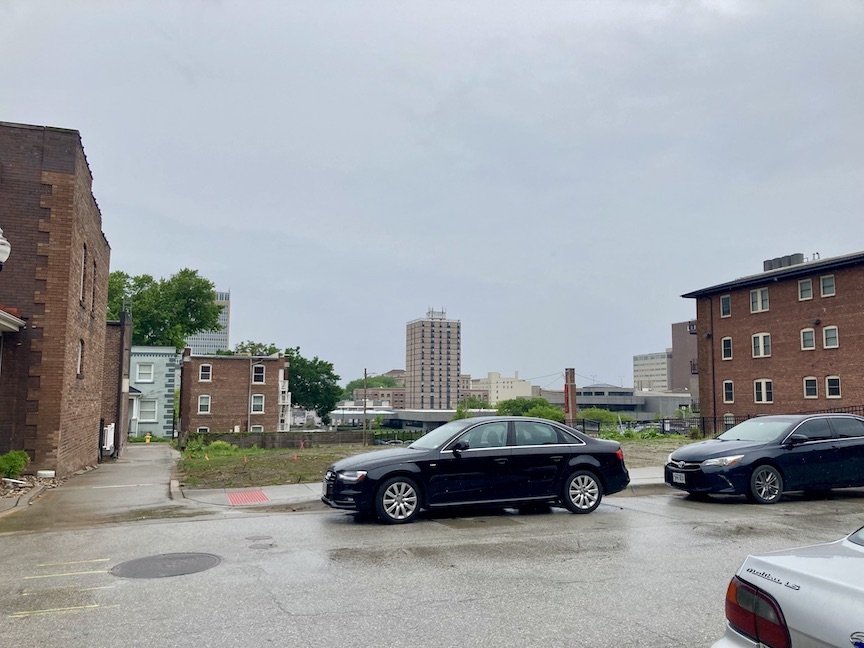
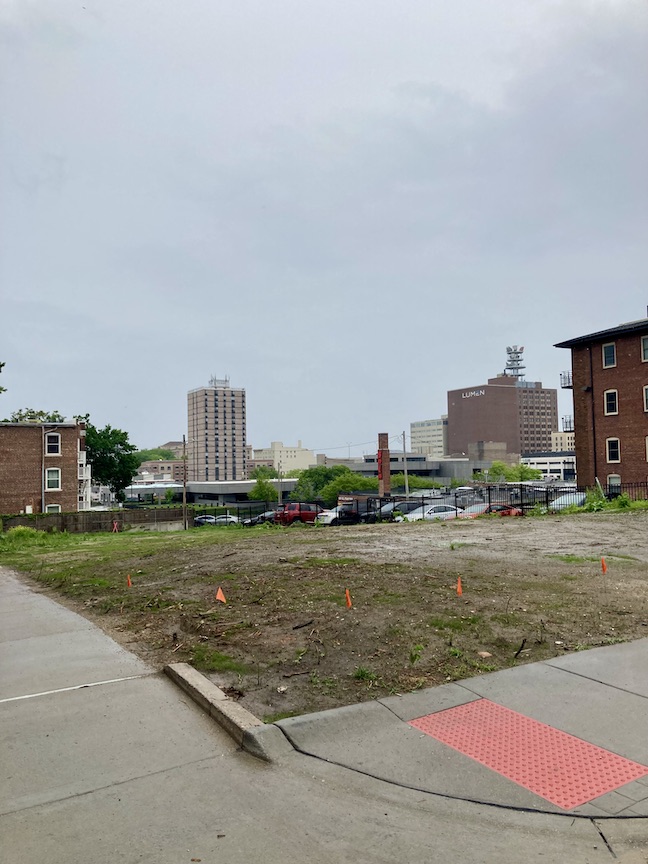
2226 Howard site as of today. Darren just shared something that made me smile. “One of the fireplace mantles and several of the cabinets we salvaged have already found new homes, at least one even ended up back in Omaha!”
Also to the southwest, a new apartment building is being completed: The Howard.
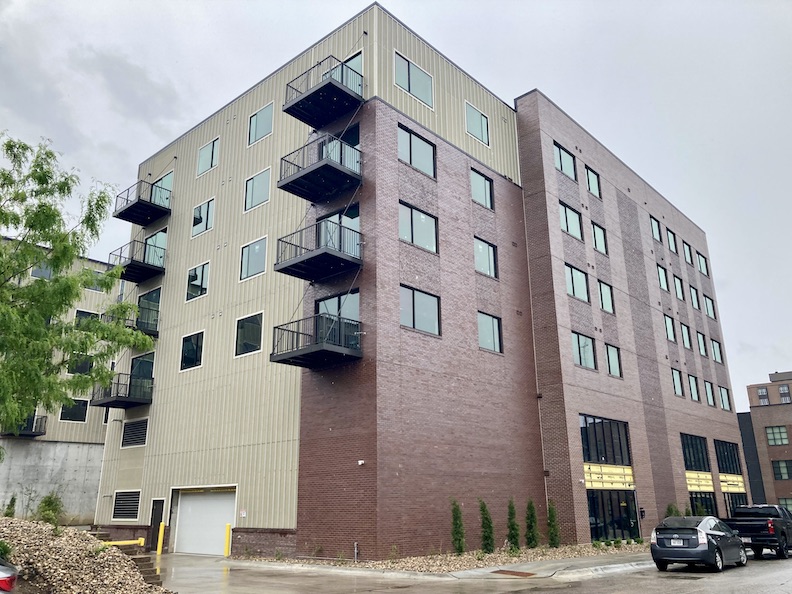
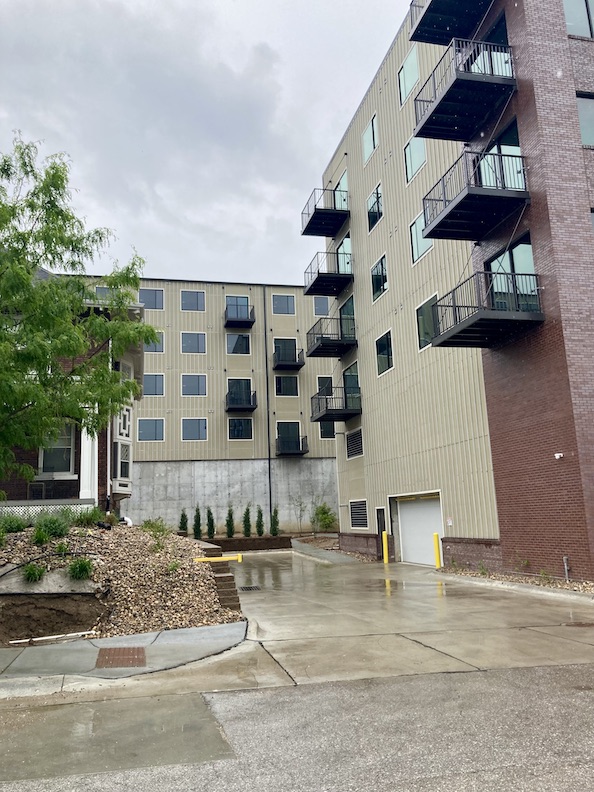
I’ve got to think that at some point, a building very similar will appear in the 2226 Howard Street shingle site.
I welcome your feedback and comments on this incredible home, its history of owners and the Howard Street Apartment District. To enable comments or to read others’ comments, please click on the header title. If you would like to correspond with me privately, please do so at myomahaobsession@yahoo.com. But I assure you, everyone would love to read what you have to say and it makes the conversation more fun. You can keep up with my latest investigations without even leaving your inbox, by “following” myomahaobsession. You will get sent email updates every time I have written a new article. Also join My Omaha Obsession on Facebook where you will find even more fun comments from readers. Thank you Omaha friends.
© Miss Cassette and myomahaobsession, 2017. Unauthorized use and/or duplication of this material without express and written permission from this site’s author and/or owner is strictly prohibited. Excerpts and links may be used, provided that full and clear credit is given to Miss Cassette and myomahaobsession with appropriate and specific direction to the original content.
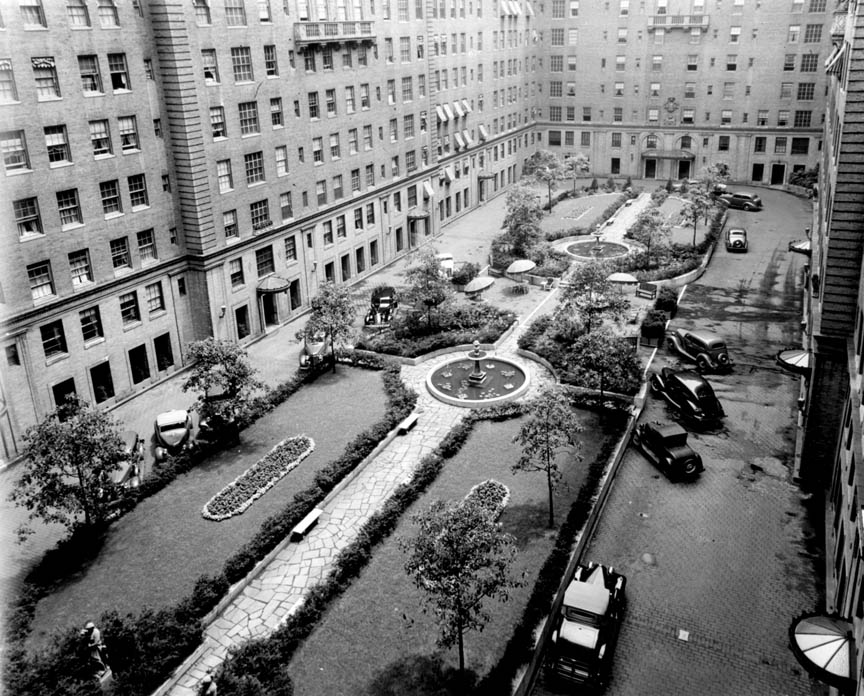
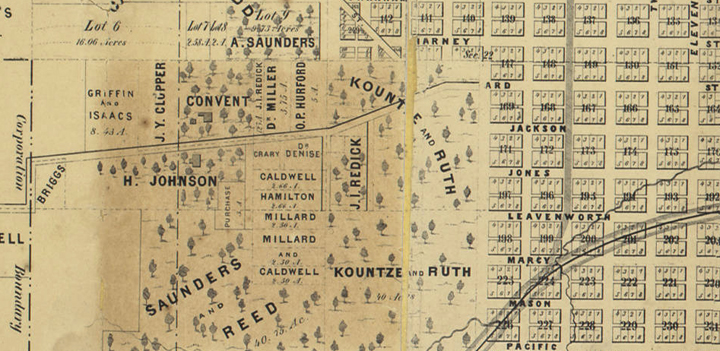

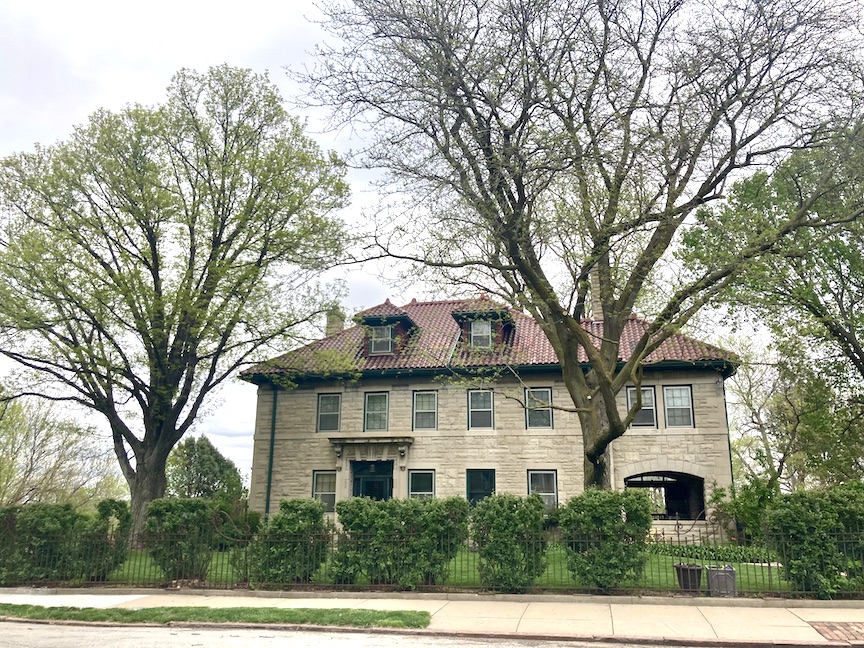
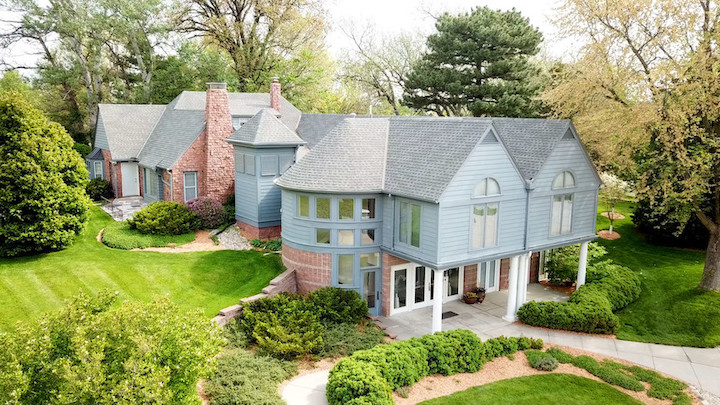
Lovely detailed story, Miss Cassette. All I could think of was silver fish. Only recently did we have our house re-roofed with synthetic shingles to replace the shakes and twenty years of fighting with the silver fish.
Me and my kids walked by this house for years and sometimes we would stop and just look at it and wonder about the people that lived here and are there ghosts still there.You see I am obsessed with Omaha history and the Paranormal so it naturally transferred to my kids and my daughter found this story.Thank you so much for this.Also I wondered do you now any history about 17th and Nicholas that’s where I grew up and I couldn’t have dreamed of a more magical place to have grown up but now its just a waste land in my eyes but I would love to know more about where I grew up.
Thank you so much for writing in. I am glad to know we are not alone. If you can, please let me know your old address at Nicholas or if you’d rather, you can email me. myomahaobsession@yahoo.com
I was born in the apartment building right behind this house on Dewey in 1965
Every now and again I see a light in a different room of the house, i work early hours and the light always seems to show at odd hours. I thought there might be a timer. It’s now Oct 2018 and the poor house is looking a little worn no one is mowing. Whoever owns the house will not sell to the nustyle development… but there is a land line listed with a womans name. No one goes in no one comes out and I’m ready to leave a plate of cookies with a note that states hello neighbor you have a beautiful house.
O MY WORD! Yes, please leave the cookies with the note! That is so Nancy Drew. We need to get in that home. As the clock ticks, I become more obsessed.
Great research! My great-great grandparents lived at 2202 Howard St. (next to Clarkson Hospital) from (roughly) 1910 to 1923. I have two photos of the house from that period. My great-great grandfather was Perry A.C. Stevens (his name is listed in the 1912 directory you excerpted). I can share them with you if you are interested. -Sean
I have been fascinated by house at 2206 Howard Street as well, having stumbled across it a while back. (I share your love of old houses like this) Anyway, I have some additional info:. This came from the Omaha Bee and describes the wedding of Jessie and Harry S. Rollins: https://chroniclingamerica.loc.gov/lccn/sn99021999/1885-11-28/ed-1/seq-5/#date1=1885&index=0&rows=20&words=McWhorter+Rollins&searchType=basic&sequence=0&state=Nebraska&date2=1909&proxtext=McWhorter+%26+Rollins&y=3&x=15&dateFilterType=yearRange&page=1
Interestingly, City Directories show Harry living at 2018 Howard St in 1888, 1889 and 1890. (I assume it’s the same Harry because middle initial and workplace are the same). , but in 1887, he’s at 2020 Howard Street. This ties in with your article that mentions the confusion about the address. Since Little Guy died in 1893 and since Jessie got engaged a short while after that, it’s possible that they got divorced because the of child’s death. On the other hand, it’s equally plausible that Jessie was not a happily married woman since it sounds like she liked to run with the society girls, etc.
The biggest surprise was that he is in the 1900 Census living in Neligh in Antelope county and his marital status is divorced….which explains how Jessie remarried. He died (also per ancestry.com) on May 3, 1915 and is buried in Henry, Illinois. Anyway, I am totally fascinated by this and will add more if I find anything else.
You are so wonderful! Great detecting. Please, please feel free to add more as you wish. I really appreciate this.
Wow this is fascinating and I wondered if there wasn’t a divorce situation!
Love the story. I used to drive by this house when my son lived on 24th and Harney. I sure hope this gem can stick around for generations to come.
Fantastic chronicling work! This is the second time I’ve found this site through searching for details about interesting houses, but this time I discovered it because I saw a listing for the home just go up and wanted to know more. In fact, the listing includes interior photos, which I’m not sure have ever been made publicly available before now! The inside is sadly in need of repair (lots of repair. Lots and lots of repair) but you can see so much of the original craftsmanship shine through too.
Thanks for all your time and research into this (and all the other) fascinating buildings of Omaha!
Presently this house is for sale, and it appears it could be demolished. Unfortunately, the pics of the inside are horrendous and it looks like something very very sad/bad has been going on inside. Sadly I doubt anyone is going to want to take on the major task of restoring it. So check out the pics, and maybe even contact the listing agent to look at the inside, before it’s gone for good. Great detective work on this !!
Have you seen these pictures?
https://www.zillow.com/homedetails/2226-Howard-St-Omaha-NE-68102/75792821_zpid/?fbclid=IwAR3VbSml3bw2hT915rkro4wBY6xdD50_I2oQmEG4xaNqCkM5lkSACNegwuw
Interior photos on Zillow
https://www.zillow.com/homedetails/2226-Howard-St-Omaha-NE-68102/75792821_zpid/
Yes…it’s sad that it’s so beat up inside, i wonder what happened?
I enjoyed reading your story on 2226 Howard St. I’ve done architectural salvage for 45+ yrs, I am currently working for the person that bought salvage rights to that house from the new owner, sadly it’s in far worse condition inside than those Zillow pictures showed! While this house was far too deteriorated to restore, many of it’s features from inside will live on in new locations.
I noticed in the pics you had from 1980? the basement windows didn’t have the metal bars, they were added later…
1n 1965 my family lived on 22nd Dewey in the building next to the alley, when I was 3 years a salesman unfamiliar with the area drove the wrong way in that alley and hit me, I wasn’t seriously hurt. In early 1966 we moved across the street closest to 24th st. But in 1968 we were forced to move because Firestone bought the property behind us but need more land. I remember throwing a hissy fit as Mom would call it.
My great grand pa started the first Conor grocery store downtown, steffel s Conor store…
I certainly hope you will one day write about the Kimball house on St. Mary’s. I did the probate that allowed the current owner to buy it. The legal description for the Kimball house is Convent Place and I recall that when it was a convent, the buyer (an order of nuns) paid a fantastic price for the land. I ended up buying the two lots to the east and the legal description is Courtland Place. The south side of the lots front St. Mary’s Avenue and the north side is Landon Court. I encountered some interesting characters on Landon Court.
Kimball kept chickens on this lot and there is a Nebraska Supreme Court case about that. The City of Omaha had passed a law to prohibit chicken raising in the city limits.
Br. William Woegner, at St. Cecila’s, is the expert on all things Thomas Rogers Kimball. Kimball designed St. Cecilia’s. I always suspected that some of the roof tiles from St. C’s ended up on his mom’s house.
There are two buildings on the Courtland Place lot; one being a duplex. The husband and wife who I sold it to converted the duplex into a nice one family home. But they foolishly spent a fortune on a heat pump.
The view from Courtland Place is fabulous to the east. My buyers sold the real estate to a retired attorney et ux and they wisely cut out a lot of the brush and trimmed the trees on the east boundary so now they have a great view. I had wanted to build some townhomes on the lots, but then the 2007-08 financial crisis hit. I made a small profit.
Correction. My buyers bought a super-expensive geothermal heating and cooling system. It wasn’t just a heat pump.
As I was reading this post, I was truly surprised to come across the name Ethel Teresa Wead Mick. She was an extraordinary woman, the founder of the International Order of the Job’s Daughters, an organization that has profoundly impacted the lives of countless girls and women around the world.
Ethel Mick was a visionary who believed in the power of youth and in the values that form the foundation of this order: faith, courage, purity, respect, and wisdom. She created a space of empowerment where many of us learned about leadership, sisterhood, and how to be stronger, more confident individuals.
Anyone interested in understanding the profound impact of this remarkable woman and the Order of Job’s Daughters should definitely take the time to research her legacy. Her story is one of true beauty and significance.